Quick filters:
Buddha loetla nabhalai Stock Photos and Images
 Thailand: King Rama II, Buddha Loetla Nabhalai (24 February 1767 – 21 July 1824), 2nd monarch of the Chakri Dynasty. Oil on canvas painting, c. 19th century. Phra Bat Somdet Phra Poramenthramaha Isarasundhorn Phra Buddha Loetla Nabhalai, or Rama II, was the second monarch of Siam under the House of Chakri, ruling from 1809-1824. In 1809, Isarasundhorn succeeded his father Buddha Yodfa Chulaloke, the founder of Chakri dynasty, as Buddha Loetla Nabhalai the King of Siam. His reign was largely peaceful, devoid of major conflicts. His reign was known as the 'Golden Age of Rattanakosin Literature' Stock Photohttps://www.alamy.com/image-license-details/?v=1https://www.alamy.com/thailand-king-rama-ii-buddha-loetla-nabhalai-24-february-1767-21-july-1824-2nd-monarch-of-the-chakri-dynasty-oil-on-canvas-painting-c-19th-century-phra-bat-somdet-phra-poramenthramaha-isarasundhorn-phra-buddha-loetla-nabhalai-or-rama-ii-was-the-second-monarch-of-siam-under-the-house-of-chakri-ruling-from-1809-1824-in-1809-isarasundhorn-succeeded-his-father-buddha-yodfa-chulaloke-the-founder-of-chakri-dynasty-as-buddha-loetla-nabhalai-the-king-of-siam-his-reign-was-largely-peaceful-devoid-of-major-conflicts-his-reign-was-known-as-the-golden-age-of-rattanakosin-literature-image344232248.html
Thailand: King Rama II, Buddha Loetla Nabhalai (24 February 1767 – 21 July 1824), 2nd monarch of the Chakri Dynasty. Oil on canvas painting, c. 19th century. Phra Bat Somdet Phra Poramenthramaha Isarasundhorn Phra Buddha Loetla Nabhalai, or Rama II, was the second monarch of Siam under the House of Chakri, ruling from 1809-1824. In 1809, Isarasundhorn succeeded his father Buddha Yodfa Chulaloke, the founder of Chakri dynasty, as Buddha Loetla Nabhalai the King of Siam. His reign was largely peaceful, devoid of major conflicts. His reign was known as the 'Golden Age of Rattanakosin Literature' Stock Photohttps://www.alamy.com/image-license-details/?v=1https://www.alamy.com/thailand-king-rama-ii-buddha-loetla-nabhalai-24-february-1767-21-july-1824-2nd-monarch-of-the-chakri-dynasty-oil-on-canvas-painting-c-19th-century-phra-bat-somdet-phra-poramenthramaha-isarasundhorn-phra-buddha-loetla-nabhalai-or-rama-ii-was-the-second-monarch-of-siam-under-the-house-of-chakri-ruling-from-1809-1824-in-1809-isarasundhorn-succeeded-his-father-buddha-yodfa-chulaloke-the-founder-of-chakri-dynasty-as-buddha-loetla-nabhalai-the-king-of-siam-his-reign-was-largely-peaceful-devoid-of-major-conflicts-his-reign-was-known-as-the-golden-age-of-rattanakosin-literature-image344232248.htmlRM2B013MT–Thailand: King Rama II, Buddha Loetla Nabhalai (24 February 1767 – 21 July 1824), 2nd monarch of the Chakri Dynasty. Oil on canvas painting, c. 19th century. Phra Bat Somdet Phra Poramenthramaha Isarasundhorn Phra Buddha Loetla Nabhalai, or Rama II, was the second monarch of Siam under the House of Chakri, ruling from 1809-1824. In 1809, Isarasundhorn succeeded his father Buddha Yodfa Chulaloke, the founder of Chakri dynasty, as Buddha Loetla Nabhalai the King of Siam. His reign was largely peaceful, devoid of major conflicts. His reign was known as the 'Golden Age of Rattanakosin Literature'
 Buddha Loetla Nabhalai portrait Stock Photohttps://www.alamy.com/image-license-details/?v=1https://www.alamy.com/stock-image-buddha-loetla-nabhalai-portrait-167641964.html
Buddha Loetla Nabhalai portrait Stock Photohttps://www.alamy.com/image-license-details/?v=1https://www.alamy.com/stock-image-buddha-loetla-nabhalai-portrait-167641964.htmlRMKMMN10–Buddha Loetla Nabhalai portrait
 Thailand: King Rama II, Buddha Loetla Nabhalai (24 February 1767 – 21 July 1824), 2nd monarch of the Chakri Dynasty. Oil on canvas painting, c. 19th century. Phra Bat Somdet Phra Poramenthramaha Isarasundhorn Phra Buddha Loetla Nabhalai, or Rama II, was the second monarch of Siam under the House of Chakri, ruling from 1809-1824. In 1809, Isarasundhorn succeeded his father Buddha Yodfa Chulaloke, the founder of Chakri dynasty, as Buddha Loetla Nabhalai the King of Siam. His reign was largely peaceful, devoid of major conflicts. His reign was known as the 'Golden Age of Rattanakosin Literature' Stock Photohttps://www.alamy.com/image-license-details/?v=1https://www.alamy.com/thailand-king-rama-ii-buddha-loetla-nabhalai-24-february-1767-21-july-1824-2nd-monarch-of-the-chakri-dynasty-oil-on-canvas-painting-c-19th-century-phra-bat-somdet-phra-poramenthramaha-isarasundhorn-phra-buddha-loetla-nabhalai-or-rama-ii-was-the-second-monarch-of-siam-under-the-house-of-chakri-ruling-from-1809-1824-in-1809-isarasundhorn-succeeded-his-father-buddha-yodfa-chulaloke-the-founder-of-chakri-dynasty-as-buddha-loetla-nabhalai-the-king-of-siam-his-reign-was-largely-peaceful-devoid-of-major-conflicts-his-reign-was-known-as-the-golden-age-of-rattanakosin-literature-image344232246.html
Thailand: King Rama II, Buddha Loetla Nabhalai (24 February 1767 – 21 July 1824), 2nd monarch of the Chakri Dynasty. Oil on canvas painting, c. 19th century. Phra Bat Somdet Phra Poramenthramaha Isarasundhorn Phra Buddha Loetla Nabhalai, or Rama II, was the second monarch of Siam under the House of Chakri, ruling from 1809-1824. In 1809, Isarasundhorn succeeded his father Buddha Yodfa Chulaloke, the founder of Chakri dynasty, as Buddha Loetla Nabhalai the King of Siam. His reign was largely peaceful, devoid of major conflicts. His reign was known as the 'Golden Age of Rattanakosin Literature' Stock Photohttps://www.alamy.com/image-license-details/?v=1https://www.alamy.com/thailand-king-rama-ii-buddha-loetla-nabhalai-24-february-1767-21-july-1824-2nd-monarch-of-the-chakri-dynasty-oil-on-canvas-painting-c-19th-century-phra-bat-somdet-phra-poramenthramaha-isarasundhorn-phra-buddha-loetla-nabhalai-or-rama-ii-was-the-second-monarch-of-siam-under-the-house-of-chakri-ruling-from-1809-1824-in-1809-isarasundhorn-succeeded-his-father-buddha-yodfa-chulaloke-the-founder-of-chakri-dynasty-as-buddha-loetla-nabhalai-the-king-of-siam-his-reign-was-largely-peaceful-devoid-of-major-conflicts-his-reign-was-known-as-the-golden-age-of-rattanakosin-literature-image344232246.htmlRM2B013MP–Thailand: King Rama II, Buddha Loetla Nabhalai (24 February 1767 – 21 July 1824), 2nd monarch of the Chakri Dynasty. Oil on canvas painting, c. 19th century. Phra Bat Somdet Phra Poramenthramaha Isarasundhorn Phra Buddha Loetla Nabhalai, or Rama II, was the second monarch of Siam under the House of Chakri, ruling from 1809-1824. In 1809, Isarasundhorn succeeded his father Buddha Yodfa Chulaloke, the founder of Chakri dynasty, as Buddha Loetla Nabhalai the King of Siam. His reign was largely peaceful, devoid of major conflicts. His reign was known as the 'Golden Age of Rattanakosin Literature'
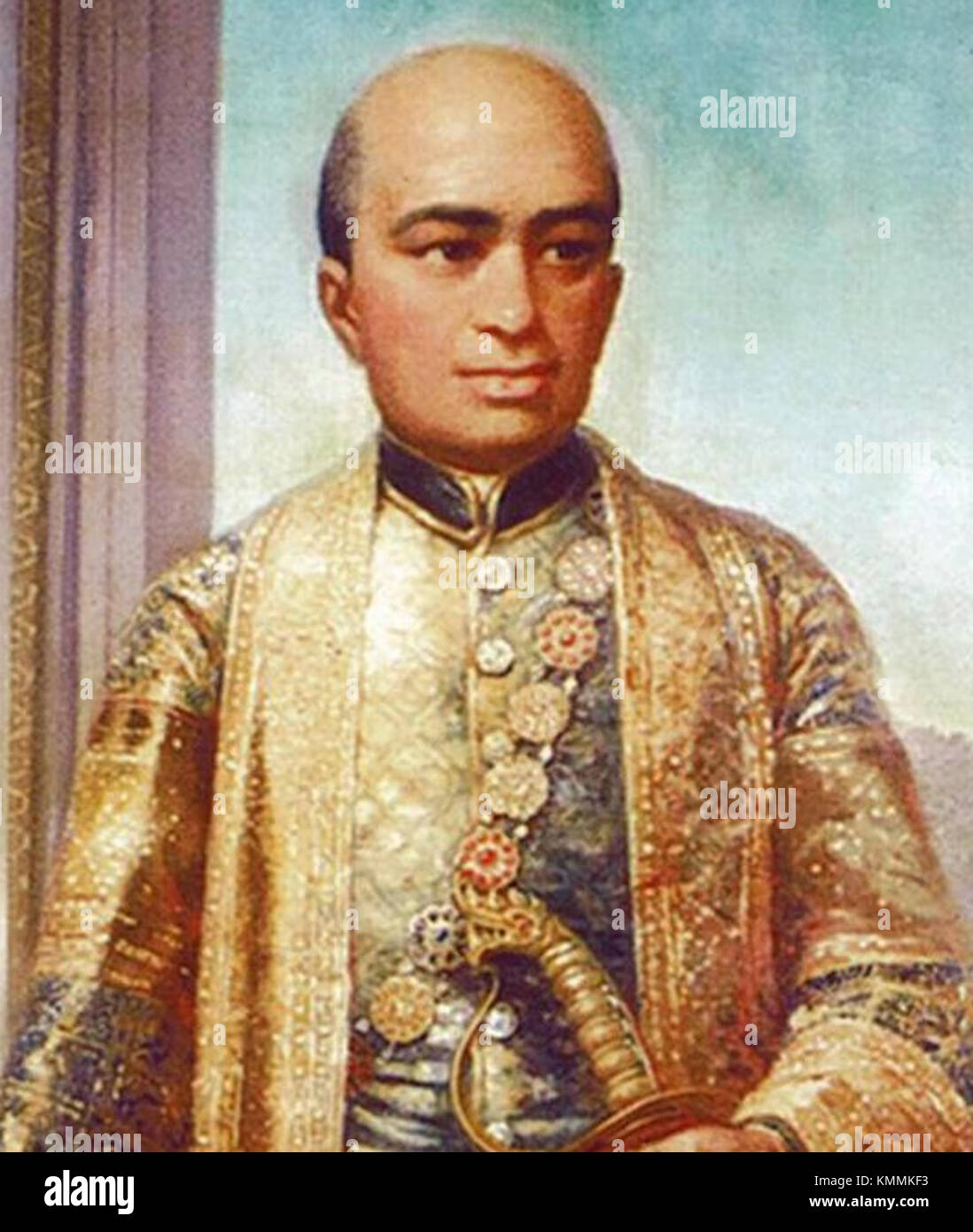 King Buddha Loetla Nabhalai Stock Photohttps://www.alamy.com/image-license-details/?v=1https://www.alamy.com/stock-image-king-buddha-loetla-nabhalai-167640791.html
King Buddha Loetla Nabhalai Stock Photohttps://www.alamy.com/image-license-details/?v=1https://www.alamy.com/stock-image-king-buddha-loetla-nabhalai-167640791.htmlRMKMMKF3–King Buddha Loetla Nabhalai
 Thailand: The Phra Sri Sakyamuni Buddha image, Wat Suthat, Bangkok. Wat Suthat Thepphawararam is a royal temple of the first grade, one of six such temples in Thailand. Construction was begun by King Buddha Yodfa Chulaloke (Rama I) in 1807. Further construction and decorations were carried out by King Buddha Loetla Nabhalai (Rama II) who helped carve the wooden doors, but the temple was not completed until the reign of King Jessadabodindra (Rama III) in 1847. The temple is a fine example of the Rattanakosin architectural style. Stock Photohttps://www.alamy.com/image-license-details/?v=1https://www.alamy.com/thailand-the-phra-sri-sakyamuni-buddha-image-wat-suthat-bangkok-wat-suthat-thepphawararam-is-a-royal-temple-of-the-first-grade-one-of-six-such-temples-in-thailand-construction-was-begun-by-king-buddha-yodfa-chulaloke-rama-i-in-1807-further-construction-and-decorations-were-carried-out-by-king-buddha-loetla-nabhalai-rama-ii-who-helped-carve-the-wooden-doors-but-the-temple-was-not-completed-until-the-reign-of-king-jessadabodindra-rama-iii-in-1847-the-temple-is-a-fine-example-of-the-rattanakosin-architectural-style-image344235028.html
Thailand: The Phra Sri Sakyamuni Buddha image, Wat Suthat, Bangkok. Wat Suthat Thepphawararam is a royal temple of the first grade, one of six such temples in Thailand. Construction was begun by King Buddha Yodfa Chulaloke (Rama I) in 1807. Further construction and decorations were carried out by King Buddha Loetla Nabhalai (Rama II) who helped carve the wooden doors, but the temple was not completed until the reign of King Jessadabodindra (Rama III) in 1847. The temple is a fine example of the Rattanakosin architectural style. Stock Photohttps://www.alamy.com/image-license-details/?v=1https://www.alamy.com/thailand-the-phra-sri-sakyamuni-buddha-image-wat-suthat-bangkok-wat-suthat-thepphawararam-is-a-royal-temple-of-the-first-grade-one-of-six-such-temples-in-thailand-construction-was-begun-by-king-buddha-yodfa-chulaloke-rama-i-in-1807-further-construction-and-decorations-were-carried-out-by-king-buddha-loetla-nabhalai-rama-ii-who-helped-carve-the-wooden-doors-but-the-temple-was-not-completed-until-the-reign-of-king-jessadabodindra-rama-iii-in-1847-the-temple-is-a-fine-example-of-the-rattanakosin-architectural-style-image344235028.htmlRM2B01784–Thailand: The Phra Sri Sakyamuni Buddha image, Wat Suthat, Bangkok. Wat Suthat Thepphawararam is a royal temple of the first grade, one of six such temples in Thailand. Construction was begun by King Buddha Yodfa Chulaloke (Rama I) in 1807. Further construction and decorations were carried out by King Buddha Loetla Nabhalai (Rama II) who helped carve the wooden doors, but the temple was not completed until the reign of King Jessadabodindra (Rama III) in 1847. The temple is a fine example of the Rattanakosin architectural style.
 King Buddha Loetla Nabhalai portrait BW cropped Stock Photohttps://www.alamy.com/image-license-details/?v=1https://www.alamy.com/stock-image-king-buddha-loetla-nabhalai-portrait-bw-cropped-167590680.html
King Buddha Loetla Nabhalai portrait BW cropped Stock Photohttps://www.alamy.com/image-license-details/?v=1https://www.alamy.com/stock-image-king-buddha-loetla-nabhalai-portrait-bw-cropped-167590680.htmlRMKMJBHC–King Buddha Loetla Nabhalai portrait BW cropped
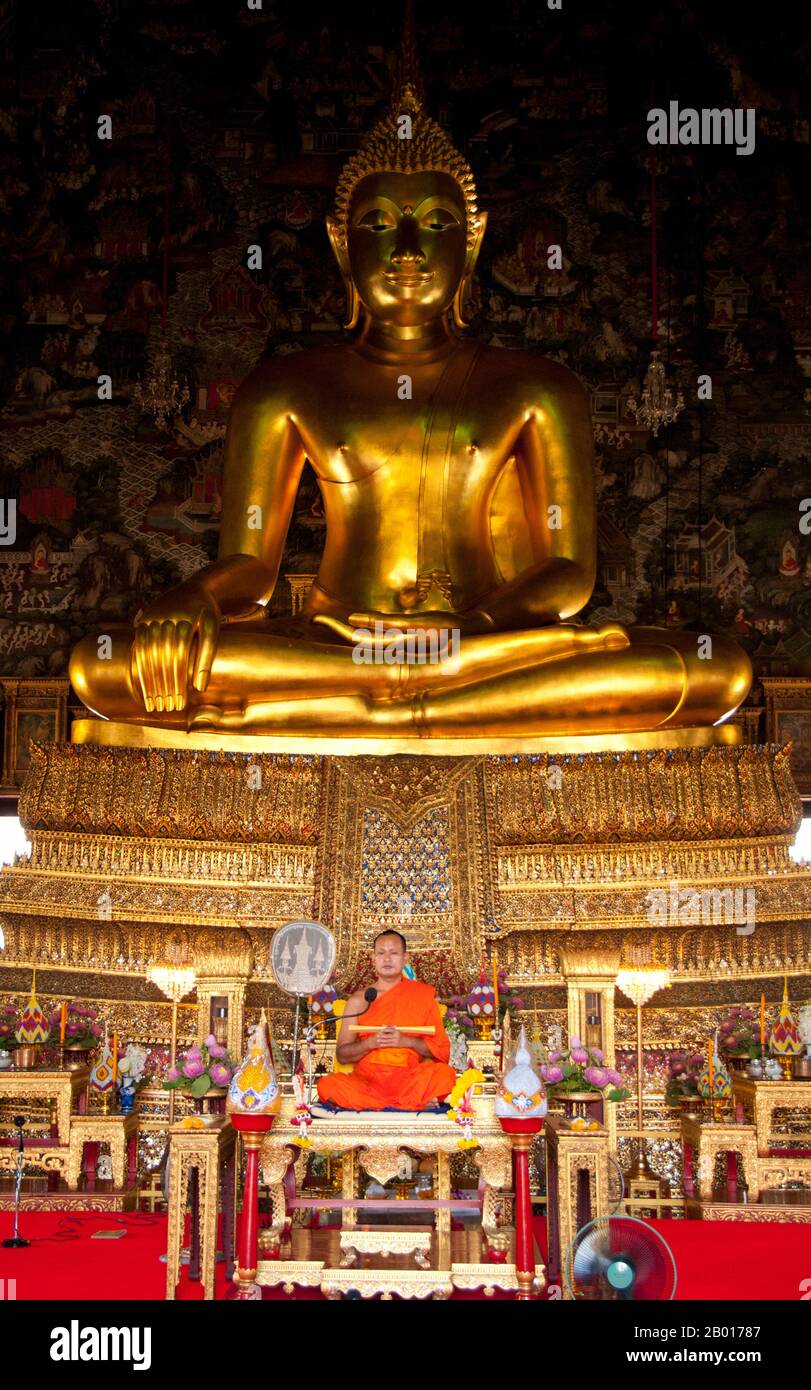 Thailand: The Phra Sri Sakyamuni Buddha image, Wat Suthat, Bangkok. Wat Suthat Thepphawararam is a royal temple of the first grade, one of six such temples in Thailand. Construction was begun by King Buddha Yodfa Chulaloke (Rama I) in 1807. Further construction and decorations were carried out by King Buddha Loetla Nabhalai (Rama II) who helped carve the wooden doors, but the temple was not completed until the reign of King Jessadabodindra (Rama III) in 1847. The temple is a fine example of the Rattanakosin architectural style. Stock Photohttps://www.alamy.com/image-license-details/?v=1https://www.alamy.com/thailand-the-phra-sri-sakyamuni-buddha-image-wat-suthat-bangkok-wat-suthat-thepphawararam-is-a-royal-temple-of-the-first-grade-one-of-six-such-temples-in-thailand-construction-was-begun-by-king-buddha-yodfa-chulaloke-rama-i-in-1807-further-construction-and-decorations-were-carried-out-by-king-buddha-loetla-nabhalai-rama-ii-who-helped-carve-the-wooden-doors-but-the-temple-was-not-completed-until-the-reign-of-king-jessadabodindra-rama-iii-in-1847-the-temple-is-a-fine-example-of-the-rattanakosin-architectural-style-image344235031.html
Thailand: The Phra Sri Sakyamuni Buddha image, Wat Suthat, Bangkok. Wat Suthat Thepphawararam is a royal temple of the first grade, one of six such temples in Thailand. Construction was begun by King Buddha Yodfa Chulaloke (Rama I) in 1807. Further construction and decorations were carried out by King Buddha Loetla Nabhalai (Rama II) who helped carve the wooden doors, but the temple was not completed until the reign of King Jessadabodindra (Rama III) in 1847. The temple is a fine example of the Rattanakosin architectural style. Stock Photohttps://www.alamy.com/image-license-details/?v=1https://www.alamy.com/thailand-the-phra-sri-sakyamuni-buddha-image-wat-suthat-bangkok-wat-suthat-thepphawararam-is-a-royal-temple-of-the-first-grade-one-of-six-such-temples-in-thailand-construction-was-begun-by-king-buddha-yodfa-chulaloke-rama-i-in-1807-further-construction-and-decorations-were-carried-out-by-king-buddha-loetla-nabhalai-rama-ii-who-helped-carve-the-wooden-doors-but-the-temple-was-not-completed-until-the-reign-of-king-jessadabodindra-rama-iii-in-1847-the-temple-is-a-fine-example-of-the-rattanakosin-architectural-style-image344235031.htmlRM2B01787–Thailand: The Phra Sri Sakyamuni Buddha image, Wat Suthat, Bangkok. Wat Suthat Thepphawararam is a royal temple of the first grade, one of six such temples in Thailand. Construction was begun by King Buddha Yodfa Chulaloke (Rama I) in 1807. Further construction and decorations were carried out by King Buddha Loetla Nabhalai (Rama II) who helped carve the wooden doors, but the temple was not completed until the reign of King Jessadabodindra (Rama III) in 1847. The temple is a fine example of the Rattanakosin architectural style.
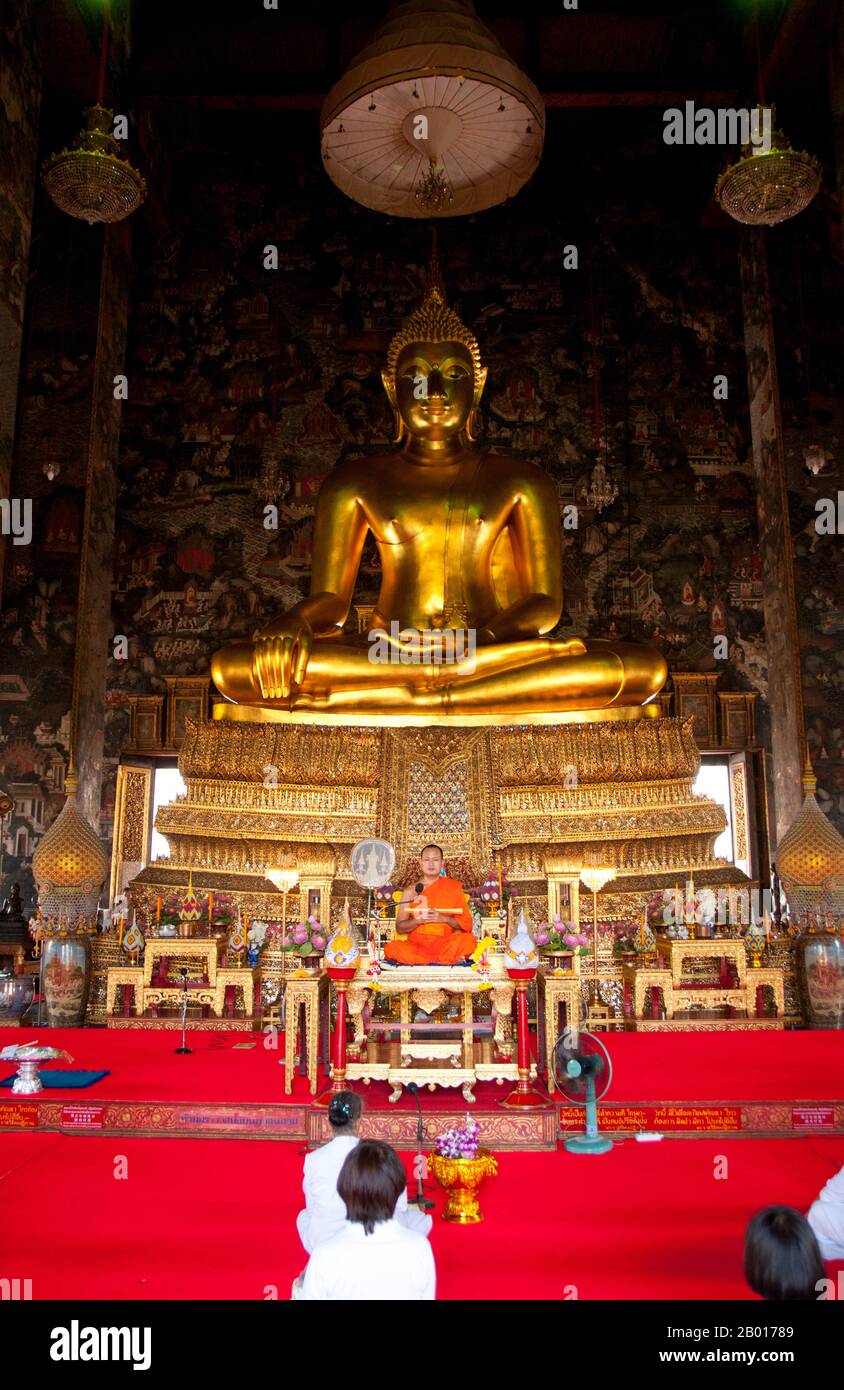 Thailand: The Phra Sri Sakyamuni Buddha image, Wat Suthat, Bangkok. Wat Suthat Thepphawararam is a royal temple of the first grade, one of six such temples in Thailand. Construction was begun by King Buddha Yodfa Chulaloke (Rama I) in 1807. Further construction and decorations were carried out by King Buddha Loetla Nabhalai (Rama II) who helped carve the wooden doors, but the temple was not completed until the reign of King Jessadabodindra (Rama III) in 1847. The temple is a fine example of the Rattanakosin architectural style. Stock Photohttps://www.alamy.com/image-license-details/?v=1https://www.alamy.com/thailand-the-phra-sri-sakyamuni-buddha-image-wat-suthat-bangkok-wat-suthat-thepphawararam-is-a-royal-temple-of-the-first-grade-one-of-six-such-temples-in-thailand-construction-was-begun-by-king-buddha-yodfa-chulaloke-rama-i-in-1807-further-construction-and-decorations-were-carried-out-by-king-buddha-loetla-nabhalai-rama-ii-who-helped-carve-the-wooden-doors-but-the-temple-was-not-completed-until-the-reign-of-king-jessadabodindra-rama-iii-in-1847-the-temple-is-a-fine-example-of-the-rattanakosin-architectural-style-image344235033.html
Thailand: The Phra Sri Sakyamuni Buddha image, Wat Suthat, Bangkok. Wat Suthat Thepphawararam is a royal temple of the first grade, one of six such temples in Thailand. Construction was begun by King Buddha Yodfa Chulaloke (Rama I) in 1807. Further construction and decorations were carried out by King Buddha Loetla Nabhalai (Rama II) who helped carve the wooden doors, but the temple was not completed until the reign of King Jessadabodindra (Rama III) in 1847. The temple is a fine example of the Rattanakosin architectural style. Stock Photohttps://www.alamy.com/image-license-details/?v=1https://www.alamy.com/thailand-the-phra-sri-sakyamuni-buddha-image-wat-suthat-bangkok-wat-suthat-thepphawararam-is-a-royal-temple-of-the-first-grade-one-of-six-such-temples-in-thailand-construction-was-begun-by-king-buddha-yodfa-chulaloke-rama-i-in-1807-further-construction-and-decorations-were-carried-out-by-king-buddha-loetla-nabhalai-rama-ii-who-helped-carve-the-wooden-doors-but-the-temple-was-not-completed-until-the-reign-of-king-jessadabodindra-rama-iii-in-1847-the-temple-is-a-fine-example-of-the-rattanakosin-architectural-style-image344235033.htmlRM2B01789–Thailand: The Phra Sri Sakyamuni Buddha image, Wat Suthat, Bangkok. Wat Suthat Thepphawararam is a royal temple of the first grade, one of six such temples in Thailand. Construction was begun by King Buddha Yodfa Chulaloke (Rama I) in 1807. Further construction and decorations were carried out by King Buddha Loetla Nabhalai (Rama II) who helped carve the wooden doors, but the temple was not completed until the reign of King Jessadabodindra (Rama III) in 1847. The temple is a fine example of the Rattanakosin architectural style.
 Thailand: Row of Buddhas, Wat Suthat, Bangkok. Wat Suthat Thepphawararam is a royal temple of the first grade, one of six such temples in Thailand. Construction was begun by King Buddha Yodfa Chulaloke (Rama I) in 1807. Further construction and decorations were carried out by King Buddha Loetla Nabhalai (Rama II) who helped carve the wooden doors, but the temple was not completed until the reign of King Jessadabodindra (Rama III) in 1847. The temple is a fine example of the Rattanakosin architectural style. It also contains the Buddha image Phra Sri Sakyamuni or 'Sisakayamunee'. Stock Photohttps://www.alamy.com/image-license-details/?v=1https://www.alamy.com/thailand-row-of-buddhas-wat-suthat-bangkok-wat-suthat-thepphawararam-is-a-royal-temple-of-the-first-grade-one-of-six-such-temples-in-thailand-construction-was-begun-by-king-buddha-yodfa-chulaloke-rama-i-in-1807-further-construction-and-decorations-were-carried-out-by-king-buddha-loetla-nabhalai-rama-ii-who-helped-carve-the-wooden-doors-but-the-temple-was-not-completed-until-the-reign-of-king-jessadabodindra-rama-iii-in-1847-the-temple-is-a-fine-example-of-the-rattanakosin-architectural-style-it-also-contains-the-buddha-image-phra-sri-sakyamuni-or-sisakayamunee-image344235047.html
Thailand: Row of Buddhas, Wat Suthat, Bangkok. Wat Suthat Thepphawararam is a royal temple of the first grade, one of six such temples in Thailand. Construction was begun by King Buddha Yodfa Chulaloke (Rama I) in 1807. Further construction and decorations were carried out by King Buddha Loetla Nabhalai (Rama II) who helped carve the wooden doors, but the temple was not completed until the reign of King Jessadabodindra (Rama III) in 1847. The temple is a fine example of the Rattanakosin architectural style. It also contains the Buddha image Phra Sri Sakyamuni or 'Sisakayamunee'. Stock Photohttps://www.alamy.com/image-license-details/?v=1https://www.alamy.com/thailand-row-of-buddhas-wat-suthat-bangkok-wat-suthat-thepphawararam-is-a-royal-temple-of-the-first-grade-one-of-six-such-temples-in-thailand-construction-was-begun-by-king-buddha-yodfa-chulaloke-rama-i-in-1807-further-construction-and-decorations-were-carried-out-by-king-buddha-loetla-nabhalai-rama-ii-who-helped-carve-the-wooden-doors-but-the-temple-was-not-completed-until-the-reign-of-king-jessadabodindra-rama-iii-in-1847-the-temple-is-a-fine-example-of-the-rattanakosin-architectural-style-it-also-contains-the-buddha-image-phra-sri-sakyamuni-or-sisakayamunee-image344235047.htmlRM2B0178R–Thailand: Row of Buddhas, Wat Suthat, Bangkok. Wat Suthat Thepphawararam is a royal temple of the first grade, one of six such temples in Thailand. Construction was begun by King Buddha Yodfa Chulaloke (Rama I) in 1807. Further construction and decorations were carried out by King Buddha Loetla Nabhalai (Rama II) who helped carve the wooden doors, but the temple was not completed until the reign of King Jessadabodindra (Rama III) in 1847. The temple is a fine example of the Rattanakosin architectural style. It also contains the Buddha image Phra Sri Sakyamuni or 'Sisakayamunee'.
 Thailand: Row of Buddhas, Wat Suthat, Bangkok. Wat Suthat Thepphawararam is a royal temple of the first grade, one of six such temples in Thailand. Construction was begun by King Buddha Yodfa Chulaloke (Rama I) in 1807. Further construction and decorations were carried out by King Buddha Loetla Nabhalai (Rama II) who helped carve the wooden doors, but the temple was not completed until the reign of King Jessadabodindra (Rama III) in 1847. The temple is a fine example of the Rattanakosin architectural style. It also contains the Buddha image Phra Sri Sakyamuni or 'Sisakayamunee'. Stock Photohttps://www.alamy.com/image-license-details/?v=1https://www.alamy.com/thailand-row-of-buddhas-wat-suthat-bangkok-wat-suthat-thepphawararam-is-a-royal-temple-of-the-first-grade-one-of-six-such-temples-in-thailand-construction-was-begun-by-king-buddha-yodfa-chulaloke-rama-i-in-1807-further-construction-and-decorations-were-carried-out-by-king-buddha-loetla-nabhalai-rama-ii-who-helped-carve-the-wooden-doors-but-the-temple-was-not-completed-until-the-reign-of-king-jessadabodindra-rama-iii-in-1847-the-temple-is-a-fine-example-of-the-rattanakosin-architectural-style-it-also-contains-the-buddha-image-phra-sri-sakyamuni-or-sisakayamunee-image344235043.html
Thailand: Row of Buddhas, Wat Suthat, Bangkok. Wat Suthat Thepphawararam is a royal temple of the first grade, one of six such temples in Thailand. Construction was begun by King Buddha Yodfa Chulaloke (Rama I) in 1807. Further construction and decorations were carried out by King Buddha Loetla Nabhalai (Rama II) who helped carve the wooden doors, but the temple was not completed until the reign of King Jessadabodindra (Rama III) in 1847. The temple is a fine example of the Rattanakosin architectural style. It also contains the Buddha image Phra Sri Sakyamuni or 'Sisakayamunee'. Stock Photohttps://www.alamy.com/image-license-details/?v=1https://www.alamy.com/thailand-row-of-buddhas-wat-suthat-bangkok-wat-suthat-thepphawararam-is-a-royal-temple-of-the-first-grade-one-of-six-such-temples-in-thailand-construction-was-begun-by-king-buddha-yodfa-chulaloke-rama-i-in-1807-further-construction-and-decorations-were-carried-out-by-king-buddha-loetla-nabhalai-rama-ii-who-helped-carve-the-wooden-doors-but-the-temple-was-not-completed-until-the-reign-of-king-jessadabodindra-rama-iii-in-1847-the-temple-is-a-fine-example-of-the-rattanakosin-architectural-style-it-also-contains-the-buddha-image-phra-sri-sakyamuni-or-sisakayamunee-image344235043.htmlRM2B0178K–Thailand: Row of Buddhas, Wat Suthat, Bangkok. Wat Suthat Thepphawararam is a royal temple of the first grade, one of six such temples in Thailand. Construction was begun by King Buddha Yodfa Chulaloke (Rama I) in 1807. Further construction and decorations were carried out by King Buddha Loetla Nabhalai (Rama II) who helped carve the wooden doors, but the temple was not completed until the reign of King Jessadabodindra (Rama III) in 1847. The temple is a fine example of the Rattanakosin architectural style. It also contains the Buddha image Phra Sri Sakyamuni or 'Sisakayamunee'.
 Thailand: Row of Buddhas, Wat Suthat, Bangkok. Wat Suthat Thepphawararam is a royal temple of the first grade, one of six such temples in Thailand. Construction was begun by King Buddha Yodfa Chulaloke (Rama I) in 1807. Further construction and decorations were carried out by King Buddha Loetla Nabhalai (Rama II) who helped carve the wooden doors, but the temple was not completed until the reign of King Jessadabodindra (Rama III) in 1847. The temple is a fine example of the Rattanakosin architectural style. It also contains the Buddha image Phra Sri Sakyamuni or 'Sisakayamunee'. Stock Photohttps://www.alamy.com/image-license-details/?v=1https://www.alamy.com/thailand-row-of-buddhas-wat-suthat-bangkok-wat-suthat-thepphawararam-is-a-royal-temple-of-the-first-grade-one-of-six-such-temples-in-thailand-construction-was-begun-by-king-buddha-yodfa-chulaloke-rama-i-in-1807-further-construction-and-decorations-were-carried-out-by-king-buddha-loetla-nabhalai-rama-ii-who-helped-carve-the-wooden-doors-but-the-temple-was-not-completed-until-the-reign-of-king-jessadabodindra-rama-iii-in-1847-the-temple-is-a-fine-example-of-the-rattanakosin-architectural-style-it-also-contains-the-buddha-image-phra-sri-sakyamuni-or-sisakayamunee-image344235041.html
Thailand: Row of Buddhas, Wat Suthat, Bangkok. Wat Suthat Thepphawararam is a royal temple of the first grade, one of six such temples in Thailand. Construction was begun by King Buddha Yodfa Chulaloke (Rama I) in 1807. Further construction and decorations were carried out by King Buddha Loetla Nabhalai (Rama II) who helped carve the wooden doors, but the temple was not completed until the reign of King Jessadabodindra (Rama III) in 1847. The temple is a fine example of the Rattanakosin architectural style. It also contains the Buddha image Phra Sri Sakyamuni or 'Sisakayamunee'. Stock Photohttps://www.alamy.com/image-license-details/?v=1https://www.alamy.com/thailand-row-of-buddhas-wat-suthat-bangkok-wat-suthat-thepphawararam-is-a-royal-temple-of-the-first-grade-one-of-six-such-temples-in-thailand-construction-was-begun-by-king-buddha-yodfa-chulaloke-rama-i-in-1807-further-construction-and-decorations-were-carried-out-by-king-buddha-loetla-nabhalai-rama-ii-who-helped-carve-the-wooden-doors-but-the-temple-was-not-completed-until-the-reign-of-king-jessadabodindra-rama-iii-in-1847-the-temple-is-a-fine-example-of-the-rattanakosin-architectural-style-it-also-contains-the-buddha-image-phra-sri-sakyamuni-or-sisakayamunee-image344235041.htmlRM2B0178H–Thailand: Row of Buddhas, Wat Suthat, Bangkok. Wat Suthat Thepphawararam is a royal temple of the first grade, one of six such temples in Thailand. Construction was begun by King Buddha Yodfa Chulaloke (Rama I) in 1807. Further construction and decorations were carried out by King Buddha Loetla Nabhalai (Rama II) who helped carve the wooden doors, but the temple was not completed until the reign of King Jessadabodindra (Rama III) in 1847. The temple is a fine example of the Rattanakosin architectural style. It also contains the Buddha image Phra Sri Sakyamuni or 'Sisakayamunee'.
 Thailand: A row of Buddhas in the main temple complex, Wat Arun (Temple of Dawn), Bangkok. Wat Arun Rajwararam (Temple of the Dawn), full name Wat Arunratchawararam Ratchaworamahawihan, is a Thai Buddhist temple on the Thonburi west bank side of the Chao Phraya River in Bangkok. It is named after Aruna, the Indian God of Dawn. A monastery has stood here since the Ayutthayan period (1351 - 1767), but the temple's outstanding feature, the Khmer-style central prang, was not begun until 1809, during the reign of King Buddha Loetla Nabhalai (Rama II). Stock Photohttps://www.alamy.com/image-license-details/?v=1https://www.alamy.com/thailand-a-row-of-buddhas-in-the-main-temple-complex-wat-arun-temple-of-dawn-bangkok-wat-arun-rajwararam-temple-of-the-dawn-full-name-wat-arunratchawararam-ratchaworamahawihan-is-a-thai-buddhist-temple-on-the-thonburi-west-bank-side-of-the-chao-phraya-river-in-bangkok-it-is-named-after-aruna-the-indian-god-of-dawn-a-monastery-has-stood-here-since-the-ayutthayan-period-1351-1767-but-the-temples-outstanding-feature-the-khmer-style-central-prang-was-not-begun-until-1809-during-the-reign-of-king-buddha-loetla-nabhalai-rama-ii-image344235332.html
Thailand: A row of Buddhas in the main temple complex, Wat Arun (Temple of Dawn), Bangkok. Wat Arun Rajwararam (Temple of the Dawn), full name Wat Arunratchawararam Ratchaworamahawihan, is a Thai Buddhist temple on the Thonburi west bank side of the Chao Phraya River in Bangkok. It is named after Aruna, the Indian God of Dawn. A monastery has stood here since the Ayutthayan period (1351 - 1767), but the temple's outstanding feature, the Khmer-style central prang, was not begun until 1809, during the reign of King Buddha Loetla Nabhalai (Rama II). Stock Photohttps://www.alamy.com/image-license-details/?v=1https://www.alamy.com/thailand-a-row-of-buddhas-in-the-main-temple-complex-wat-arun-temple-of-dawn-bangkok-wat-arun-rajwararam-temple-of-the-dawn-full-name-wat-arunratchawararam-ratchaworamahawihan-is-a-thai-buddhist-temple-on-the-thonburi-west-bank-side-of-the-chao-phraya-river-in-bangkok-it-is-named-after-aruna-the-indian-god-of-dawn-a-monastery-has-stood-here-since-the-ayutthayan-period-1351-1767-but-the-temples-outstanding-feature-the-khmer-style-central-prang-was-not-begun-until-1809-during-the-reign-of-king-buddha-loetla-nabhalai-rama-ii-image344235332.htmlRM2B017K0–Thailand: A row of Buddhas in the main temple complex, Wat Arun (Temple of Dawn), Bangkok. Wat Arun Rajwararam (Temple of the Dawn), full name Wat Arunratchawararam Ratchaworamahawihan, is a Thai Buddhist temple on the Thonburi west bank side of the Chao Phraya River in Bangkok. It is named after Aruna, the Indian God of Dawn. A monastery has stood here since the Ayutthayan period (1351 - 1767), but the temple's outstanding feature, the Khmer-style central prang, was not begun until 1809, during the reign of King Buddha Loetla Nabhalai (Rama II).
 Thailand: A row of Buddhas in the main temple complex, Wat Arun (Temple of Dawn), Bangkok. Wat Arun Rajwararam (Temple of the Dawn), full name Wat Arunratchawararam Ratchaworamahawihan, is a Thai Buddhist temple on the Thonburi west bank side of the Chao Phraya River in Bangkok. It is named after Aruna, the Indian God of Dawn. A monastery has stood here since the Ayutthayan period (1351 - 1767), but the temple's outstanding feature, the Khmer-style central prang, was not begun until 1809, during the reign of King Buddha Loetla Nabhalai (Rama II). Stock Photohttps://www.alamy.com/image-license-details/?v=1https://www.alamy.com/thailand-a-row-of-buddhas-in-the-main-temple-complex-wat-arun-temple-of-dawn-bangkok-wat-arun-rajwararam-temple-of-the-dawn-full-name-wat-arunratchawararam-ratchaworamahawihan-is-a-thai-buddhist-temple-on-the-thonburi-west-bank-side-of-the-chao-phraya-river-in-bangkok-it-is-named-after-aruna-the-indian-god-of-dawn-a-monastery-has-stood-here-since-the-ayutthayan-period-1351-1767-but-the-temples-outstanding-feature-the-khmer-style-central-prang-was-not-begun-until-1809-during-the-reign-of-king-buddha-loetla-nabhalai-rama-ii-image344235325.html
Thailand: A row of Buddhas in the main temple complex, Wat Arun (Temple of Dawn), Bangkok. Wat Arun Rajwararam (Temple of the Dawn), full name Wat Arunratchawararam Ratchaworamahawihan, is a Thai Buddhist temple on the Thonburi west bank side of the Chao Phraya River in Bangkok. It is named after Aruna, the Indian God of Dawn. A monastery has stood here since the Ayutthayan period (1351 - 1767), but the temple's outstanding feature, the Khmer-style central prang, was not begun until 1809, during the reign of King Buddha Loetla Nabhalai (Rama II). Stock Photohttps://www.alamy.com/image-license-details/?v=1https://www.alamy.com/thailand-a-row-of-buddhas-in-the-main-temple-complex-wat-arun-temple-of-dawn-bangkok-wat-arun-rajwararam-temple-of-the-dawn-full-name-wat-arunratchawararam-ratchaworamahawihan-is-a-thai-buddhist-temple-on-the-thonburi-west-bank-side-of-the-chao-phraya-river-in-bangkok-it-is-named-after-aruna-the-indian-god-of-dawn-a-monastery-has-stood-here-since-the-ayutthayan-period-1351-1767-but-the-temples-outstanding-feature-the-khmer-style-central-prang-was-not-begun-until-1809-during-the-reign-of-king-buddha-loetla-nabhalai-rama-ii-image344235325.htmlRM2B017JN–Thailand: A row of Buddhas in the main temple complex, Wat Arun (Temple of Dawn), Bangkok. Wat Arun Rajwararam (Temple of the Dawn), full name Wat Arunratchawararam Ratchaworamahawihan, is a Thai Buddhist temple on the Thonburi west bank side of the Chao Phraya River in Bangkok. It is named after Aruna, the Indian God of Dawn. A monastery has stood here since the Ayutthayan period (1351 - 1767), but the temple's outstanding feature, the Khmer-style central prang, was not begun until 1809, during the reign of King Buddha Loetla Nabhalai (Rama II).
 Thailand: A row of Buddhas in the main temple complex, Wat Arun (Temple of Dawn), Bangkok. Wat Arun Rajwararam (Temple of the Dawn), full name Wat Arunratchawararam Ratchaworamahawihan, is a Thai Buddhist temple on the Thonburi west bank side of the Chao Phraya River in Bangkok. It is named after Aruna, the Indian God of Dawn. A monastery has stood here since the Ayutthayan period (1351 - 1767), but the temple's outstanding feature, the Khmer-style central prang, was not begun until 1809, during the reign of King Buddha Loetla Nabhalai (Rama II). Stock Photohttps://www.alamy.com/image-license-details/?v=1https://www.alamy.com/thailand-a-row-of-buddhas-in-the-main-temple-complex-wat-arun-temple-of-dawn-bangkok-wat-arun-rajwararam-temple-of-the-dawn-full-name-wat-arunratchawararam-ratchaworamahawihan-is-a-thai-buddhist-temple-on-the-thonburi-west-bank-side-of-the-chao-phraya-river-in-bangkok-it-is-named-after-aruna-the-indian-god-of-dawn-a-monastery-has-stood-here-since-the-ayutthayan-period-1351-1767-but-the-temples-outstanding-feature-the-khmer-style-central-prang-was-not-begun-until-1809-during-the-reign-of-king-buddha-loetla-nabhalai-rama-ii-image344235326.html
Thailand: A row of Buddhas in the main temple complex, Wat Arun (Temple of Dawn), Bangkok. Wat Arun Rajwararam (Temple of the Dawn), full name Wat Arunratchawararam Ratchaworamahawihan, is a Thai Buddhist temple on the Thonburi west bank side of the Chao Phraya River in Bangkok. It is named after Aruna, the Indian God of Dawn. A monastery has stood here since the Ayutthayan period (1351 - 1767), but the temple's outstanding feature, the Khmer-style central prang, was not begun until 1809, during the reign of King Buddha Loetla Nabhalai (Rama II). Stock Photohttps://www.alamy.com/image-license-details/?v=1https://www.alamy.com/thailand-a-row-of-buddhas-in-the-main-temple-complex-wat-arun-temple-of-dawn-bangkok-wat-arun-rajwararam-temple-of-the-dawn-full-name-wat-arunratchawararam-ratchaworamahawihan-is-a-thai-buddhist-temple-on-the-thonburi-west-bank-side-of-the-chao-phraya-river-in-bangkok-it-is-named-after-aruna-the-indian-god-of-dawn-a-monastery-has-stood-here-since-the-ayutthayan-period-1351-1767-but-the-temples-outstanding-feature-the-khmer-style-central-prang-was-not-begun-until-1809-during-the-reign-of-king-buddha-loetla-nabhalai-rama-ii-image344235326.htmlRM2B017JP–Thailand: A row of Buddhas in the main temple complex, Wat Arun (Temple of Dawn), Bangkok. Wat Arun Rajwararam (Temple of the Dawn), full name Wat Arunratchawararam Ratchaworamahawihan, is a Thai Buddhist temple on the Thonburi west bank side of the Chao Phraya River in Bangkok. It is named after Aruna, the Indian God of Dawn. A monastery has stood here since the Ayutthayan period (1351 - 1767), but the temple's outstanding feature, the Khmer-style central prang, was not begun until 1809, during the reign of King Buddha Loetla Nabhalai (Rama II).
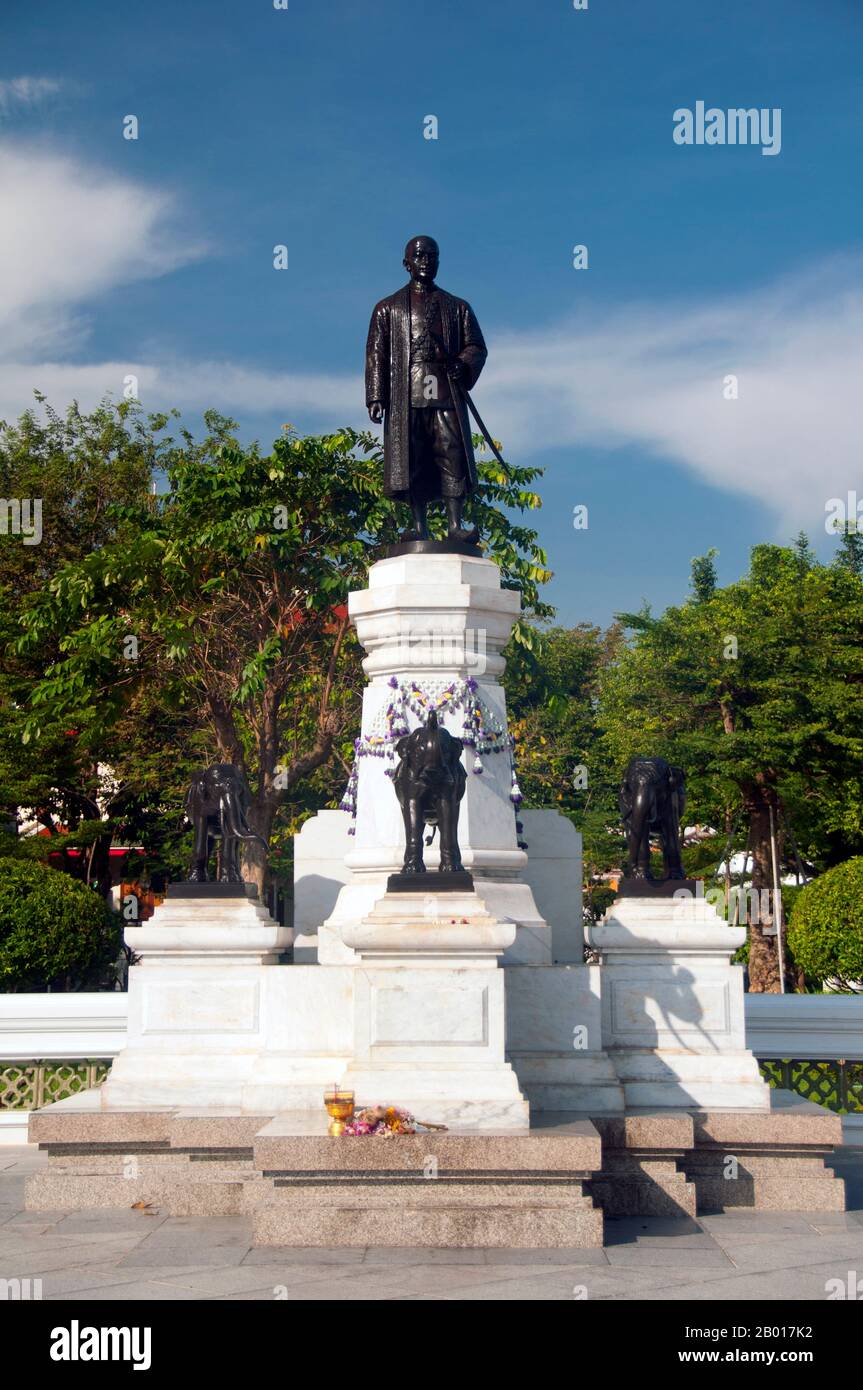 Thailand: Rama II statue at Wat Arun (Temple of Dawn), Bangkok. Phra Bat Somdet Phra Poramenthramaha Isarasundhorn Phra Buddha Loetla Nabhalai, or Rama II (24 February 1767 – 21 July 1824), was the second monarch of Siam under the House of Chakri, ruling from 1809-1824. In 1809, Isarasundhorn succeeded his father Buddha Yodfa Chulaloke, the founder of Chakri dynasty, as Buddha Loetla Nabhalai the King of Siam. His reign was largely peaceful, devoid of major conflicts. His reign was known as the 'Golden Age of Rattanakosin Literature'. Stock Photohttps://www.alamy.com/image-license-details/?v=1https://www.alamy.com/thailand-rama-ii-statue-at-wat-arun-temple-of-dawn-bangkok-phra-bat-somdet-phra-poramenthramaha-isarasundhorn-phra-buddha-loetla-nabhalai-or-rama-ii-24-february-1767-21-july-1824-was-the-second-monarch-of-siam-under-the-house-of-chakri-ruling-from-1809-1824-in-1809-isarasundhorn-succeeded-his-father-buddha-yodfa-chulaloke-the-founder-of-chakri-dynasty-as-buddha-loetla-nabhalai-the-king-of-siam-his-reign-was-largely-peaceful-devoid-of-major-conflicts-his-reign-was-known-as-the-golden-age-of-rattanakosin-literature-image344235334.html
Thailand: Rama II statue at Wat Arun (Temple of Dawn), Bangkok. Phra Bat Somdet Phra Poramenthramaha Isarasundhorn Phra Buddha Loetla Nabhalai, or Rama II (24 February 1767 – 21 July 1824), was the second monarch of Siam under the House of Chakri, ruling from 1809-1824. In 1809, Isarasundhorn succeeded his father Buddha Yodfa Chulaloke, the founder of Chakri dynasty, as Buddha Loetla Nabhalai the King of Siam. His reign was largely peaceful, devoid of major conflicts. His reign was known as the 'Golden Age of Rattanakosin Literature'. Stock Photohttps://www.alamy.com/image-license-details/?v=1https://www.alamy.com/thailand-rama-ii-statue-at-wat-arun-temple-of-dawn-bangkok-phra-bat-somdet-phra-poramenthramaha-isarasundhorn-phra-buddha-loetla-nabhalai-or-rama-ii-24-february-1767-21-july-1824-was-the-second-monarch-of-siam-under-the-house-of-chakri-ruling-from-1809-1824-in-1809-isarasundhorn-succeeded-his-father-buddha-yodfa-chulaloke-the-founder-of-chakri-dynasty-as-buddha-loetla-nabhalai-the-king-of-siam-his-reign-was-largely-peaceful-devoid-of-major-conflicts-his-reign-was-known-as-the-golden-age-of-rattanakosin-literature-image344235334.htmlRM2B017K2–Thailand: Rama II statue at Wat Arun (Temple of Dawn), Bangkok. Phra Bat Somdet Phra Poramenthramaha Isarasundhorn Phra Buddha Loetla Nabhalai, or Rama II (24 February 1767 – 21 July 1824), was the second monarch of Siam under the House of Chakri, ruling from 1809-1824. In 1809, Isarasundhorn succeeded his father Buddha Yodfa Chulaloke, the founder of Chakri dynasty, as Buddha Loetla Nabhalai the King of Siam. His reign was largely peaceful, devoid of major conflicts. His reign was known as the 'Golden Age of Rattanakosin Literature'.
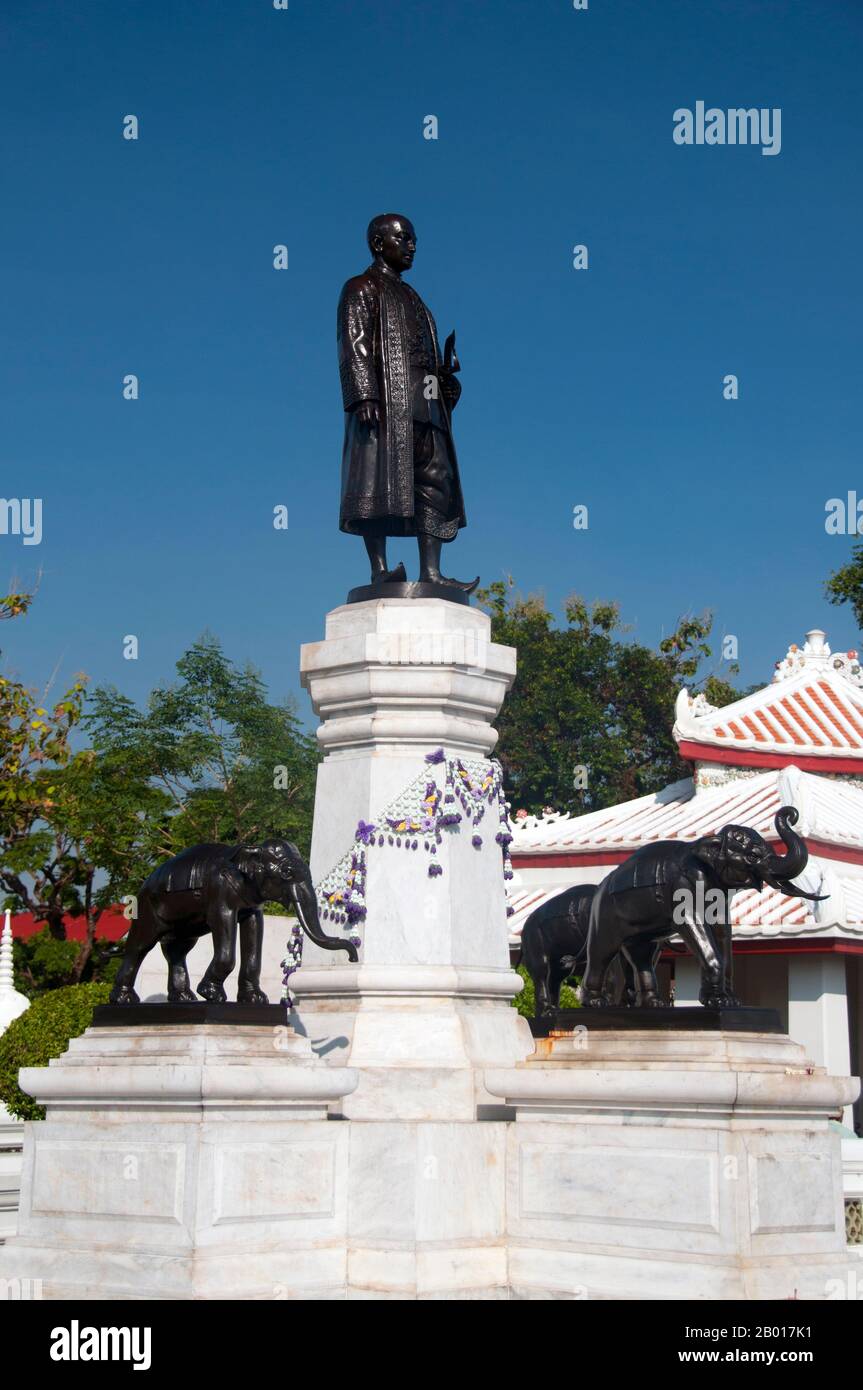 Thailand: Rama II statue at Wat Arun (Temple of Dawn), Bangkok. Phra Bat Somdet Phra Poramenthramaha Isarasundhorn Phra Buddha Loetla Nabhalai, or Rama II (24 February 1767 – 21 July 1824), was the second monarch of Siam under the House of Chakri, ruling from 1809-1824. In 1809, Isarasundhorn succeeded his father Buddha Yodfa Chulaloke, the founder of Chakri dynasty, as Buddha Loetla Nabhalai the King of Siam. His reign was largely peaceful, devoid of major conflicts. His reign was known as the 'Golden Age of Rattanakosin Literature'. Stock Photohttps://www.alamy.com/image-license-details/?v=1https://www.alamy.com/thailand-rama-ii-statue-at-wat-arun-temple-of-dawn-bangkok-phra-bat-somdet-phra-poramenthramaha-isarasundhorn-phra-buddha-loetla-nabhalai-or-rama-ii-24-february-1767-21-july-1824-was-the-second-monarch-of-siam-under-the-house-of-chakri-ruling-from-1809-1824-in-1809-isarasundhorn-succeeded-his-father-buddha-yodfa-chulaloke-the-founder-of-chakri-dynasty-as-buddha-loetla-nabhalai-the-king-of-siam-his-reign-was-largely-peaceful-devoid-of-major-conflicts-his-reign-was-known-as-the-golden-age-of-rattanakosin-literature-image344235333.html
Thailand: Rama II statue at Wat Arun (Temple of Dawn), Bangkok. Phra Bat Somdet Phra Poramenthramaha Isarasundhorn Phra Buddha Loetla Nabhalai, or Rama II (24 February 1767 – 21 July 1824), was the second monarch of Siam under the House of Chakri, ruling from 1809-1824. In 1809, Isarasundhorn succeeded his father Buddha Yodfa Chulaloke, the founder of Chakri dynasty, as Buddha Loetla Nabhalai the King of Siam. His reign was largely peaceful, devoid of major conflicts. His reign was known as the 'Golden Age of Rattanakosin Literature'. Stock Photohttps://www.alamy.com/image-license-details/?v=1https://www.alamy.com/thailand-rama-ii-statue-at-wat-arun-temple-of-dawn-bangkok-phra-bat-somdet-phra-poramenthramaha-isarasundhorn-phra-buddha-loetla-nabhalai-or-rama-ii-24-february-1767-21-july-1824-was-the-second-monarch-of-siam-under-the-house-of-chakri-ruling-from-1809-1824-in-1809-isarasundhorn-succeeded-his-father-buddha-yodfa-chulaloke-the-founder-of-chakri-dynasty-as-buddha-loetla-nabhalai-the-king-of-siam-his-reign-was-largely-peaceful-devoid-of-major-conflicts-his-reign-was-known-as-the-golden-age-of-rattanakosin-literature-image344235333.htmlRM2B017K1–Thailand: Rama II statue at Wat Arun (Temple of Dawn), Bangkok. Phra Bat Somdet Phra Poramenthramaha Isarasundhorn Phra Buddha Loetla Nabhalai, or Rama II (24 February 1767 – 21 July 1824), was the second monarch of Siam under the House of Chakri, ruling from 1809-1824. In 1809, Isarasundhorn succeeded his father Buddha Yodfa Chulaloke, the founder of Chakri dynasty, as Buddha Loetla Nabhalai the King of Siam. His reign was largely peaceful, devoid of major conflicts. His reign was known as the 'Golden Age of Rattanakosin Literature'.
 Beginning on the 15th day of the sixth lunar month, the Visakha Puja festival celebrates the Buddha’s birth, enlightenment and passing away, and is marked at Buddhist temples by chanting and preaching, and candlelit processions in the evening. Wat Suthat Thepphawararam is a royal temple of the first grade, one of six such temples in Thailand. Construction was begun by King Buddha Yodfa Chulaloke (Rama I) in 1807. Further construction and decorations were carried out by King Buddha Loetla Nabhalai (Rama II) who helped carve the wooden doors, but the temple was not completed until the reign of Stock Photohttps://www.alamy.com/image-license-details/?v=1https://www.alamy.com/beginning-on-the-15th-day-of-the-sixth-lunar-month-the-visakha-puja-festival-celebrates-the-buddhas-birth-enlightenment-and-passing-away-and-is-marked-at-buddhist-temples-by-chanting-and-preaching-and-candlelit-processions-in-the-evening-wat-suthat-thepphawararam-is-a-royal-temple-of-the-first-grade-one-of-six-such-temples-in-thailand-construction-was-begun-by-king-buddha-yodfa-chulaloke-rama-i-in-1807-further-construction-and-decorations-were-carried-out-by-king-buddha-loetla-nabhalai-rama-ii-who-helped-carve-the-wooden-doors-but-the-temple-was-not-completed-until-the-reign-of-image344279660.html
Beginning on the 15th day of the sixth lunar month, the Visakha Puja festival celebrates the Buddha’s birth, enlightenment and passing away, and is marked at Buddhist temples by chanting and preaching, and candlelit processions in the evening. Wat Suthat Thepphawararam is a royal temple of the first grade, one of six such temples in Thailand. Construction was begun by King Buddha Yodfa Chulaloke (Rama I) in 1807. Further construction and decorations were carried out by King Buddha Loetla Nabhalai (Rama II) who helped carve the wooden doors, but the temple was not completed until the reign of Stock Photohttps://www.alamy.com/image-license-details/?v=1https://www.alamy.com/beginning-on-the-15th-day-of-the-sixth-lunar-month-the-visakha-puja-festival-celebrates-the-buddhas-birth-enlightenment-and-passing-away-and-is-marked-at-buddhist-temples-by-chanting-and-preaching-and-candlelit-processions-in-the-evening-wat-suthat-thepphawararam-is-a-royal-temple-of-the-first-grade-one-of-six-such-temples-in-thailand-construction-was-begun-by-king-buddha-yodfa-chulaloke-rama-i-in-1807-further-construction-and-decorations-were-carried-out-by-king-buddha-loetla-nabhalai-rama-ii-who-helped-carve-the-wooden-doors-but-the-temple-was-not-completed-until-the-reign-of-image344279660.htmlRM2B03864–Beginning on the 15th day of the sixth lunar month, the Visakha Puja festival celebrates the Buddha’s birth, enlightenment and passing away, and is marked at Buddhist temples by chanting and preaching, and candlelit processions in the evening. Wat Suthat Thepphawararam is a royal temple of the first grade, one of six such temples in Thailand. Construction was begun by King Buddha Yodfa Chulaloke (Rama I) in 1807. Further construction and decorations were carried out by King Buddha Loetla Nabhalai (Rama II) who helped carve the wooden doors, but the temple was not completed until the reign of
 Beginning on the 15th day of the sixth lunar month, the Visakha Puja festival celebrates the Buddha’s birth, enlightenment and passing away, and is marked at Buddhist temples by chanting and preaching, and candlelit processions in the evening. Wat Suthat Thepphawararam is a royal temple of the first grade, one of six such temples in Thailand. Construction was begun by King Buddha Yodfa Chulaloke (Rama I) in 1807. Further construction and decorations were carried out by King Buddha Loetla Nabhalai (Rama II) who helped carve the wooden doors, but the temple was not completed until the reign of Stock Photohttps://www.alamy.com/image-license-details/?v=1https://www.alamy.com/beginning-on-the-15th-day-of-the-sixth-lunar-month-the-visakha-puja-festival-celebrates-the-buddhas-birth-enlightenment-and-passing-away-and-is-marked-at-buddhist-temples-by-chanting-and-preaching-and-candlelit-processions-in-the-evening-wat-suthat-thepphawararam-is-a-royal-temple-of-the-first-grade-one-of-six-such-temples-in-thailand-construction-was-begun-by-king-buddha-yodfa-chulaloke-rama-i-in-1807-further-construction-and-decorations-were-carried-out-by-king-buddha-loetla-nabhalai-rama-ii-who-helped-carve-the-wooden-doors-but-the-temple-was-not-completed-until-the-reign-of-image344279657.html
Beginning on the 15th day of the sixth lunar month, the Visakha Puja festival celebrates the Buddha’s birth, enlightenment and passing away, and is marked at Buddhist temples by chanting and preaching, and candlelit processions in the evening. Wat Suthat Thepphawararam is a royal temple of the first grade, one of six such temples in Thailand. Construction was begun by King Buddha Yodfa Chulaloke (Rama I) in 1807. Further construction and decorations were carried out by King Buddha Loetla Nabhalai (Rama II) who helped carve the wooden doors, but the temple was not completed until the reign of Stock Photohttps://www.alamy.com/image-license-details/?v=1https://www.alamy.com/beginning-on-the-15th-day-of-the-sixth-lunar-month-the-visakha-puja-festival-celebrates-the-buddhas-birth-enlightenment-and-passing-away-and-is-marked-at-buddhist-temples-by-chanting-and-preaching-and-candlelit-processions-in-the-evening-wat-suthat-thepphawararam-is-a-royal-temple-of-the-first-grade-one-of-six-such-temples-in-thailand-construction-was-begun-by-king-buddha-yodfa-chulaloke-rama-i-in-1807-further-construction-and-decorations-were-carried-out-by-king-buddha-loetla-nabhalai-rama-ii-who-helped-carve-the-wooden-doors-but-the-temple-was-not-completed-until-the-reign-of-image344279657.htmlRM2B03861–Beginning on the 15th day of the sixth lunar month, the Visakha Puja festival celebrates the Buddha’s birth, enlightenment and passing away, and is marked at Buddhist temples by chanting and preaching, and candlelit processions in the evening. Wat Suthat Thepphawararam is a royal temple of the first grade, one of six such temples in Thailand. Construction was begun by King Buddha Yodfa Chulaloke (Rama I) in 1807. Further construction and decorations were carried out by King Buddha Loetla Nabhalai (Rama II) who helped carve the wooden doors, but the temple was not completed until the reign of
 Beginning on the 15th day of the sixth lunar month, the Visakha Puja festival celebrates the Buddha’s birth, enlightenment and passing away, and is marked at Buddhist temples by chanting and preaching, and candlelit processions in the evening. Wat Suthat Thepphawararam is a royal temple of the first grade, one of six such temples in Thailand. Construction was begun by King Buddha Yodfa Chulaloke (Rama I) in 1807. Further construction and decorations were carried out by King Buddha Loetla Nabhalai (Rama II) who helped carve the wooden doors, but the temple was not completed until the reign of Stock Photohttps://www.alamy.com/image-license-details/?v=1https://www.alamy.com/beginning-on-the-15th-day-of-the-sixth-lunar-month-the-visakha-puja-festival-celebrates-the-buddhas-birth-enlightenment-and-passing-away-and-is-marked-at-buddhist-temples-by-chanting-and-preaching-and-candlelit-processions-in-the-evening-wat-suthat-thepphawararam-is-a-royal-temple-of-the-first-grade-one-of-six-such-temples-in-thailand-construction-was-begun-by-king-buddha-yodfa-chulaloke-rama-i-in-1807-further-construction-and-decorations-were-carried-out-by-king-buddha-loetla-nabhalai-rama-ii-who-helped-carve-the-wooden-doors-but-the-temple-was-not-completed-until-the-reign-of-image344279655.html
Beginning on the 15th day of the sixth lunar month, the Visakha Puja festival celebrates the Buddha’s birth, enlightenment and passing away, and is marked at Buddhist temples by chanting and preaching, and candlelit processions in the evening. Wat Suthat Thepphawararam is a royal temple of the first grade, one of six such temples in Thailand. Construction was begun by King Buddha Yodfa Chulaloke (Rama I) in 1807. Further construction and decorations were carried out by King Buddha Loetla Nabhalai (Rama II) who helped carve the wooden doors, but the temple was not completed until the reign of Stock Photohttps://www.alamy.com/image-license-details/?v=1https://www.alamy.com/beginning-on-the-15th-day-of-the-sixth-lunar-month-the-visakha-puja-festival-celebrates-the-buddhas-birth-enlightenment-and-passing-away-and-is-marked-at-buddhist-temples-by-chanting-and-preaching-and-candlelit-processions-in-the-evening-wat-suthat-thepphawararam-is-a-royal-temple-of-the-first-grade-one-of-six-such-temples-in-thailand-construction-was-begun-by-king-buddha-yodfa-chulaloke-rama-i-in-1807-further-construction-and-decorations-were-carried-out-by-king-buddha-loetla-nabhalai-rama-ii-who-helped-carve-the-wooden-doors-but-the-temple-was-not-completed-until-the-reign-of-image344279655.htmlRM2B0385Y–Beginning on the 15th day of the sixth lunar month, the Visakha Puja festival celebrates the Buddha’s birth, enlightenment and passing away, and is marked at Buddhist temples by chanting and preaching, and candlelit processions in the evening. Wat Suthat Thepphawararam is a royal temple of the first grade, one of six such temples in Thailand. Construction was begun by King Buddha Yodfa Chulaloke (Rama I) in 1807. Further construction and decorations were carried out by King Buddha Loetla Nabhalai (Rama II) who helped carve the wooden doors, but the temple was not completed until the reign of
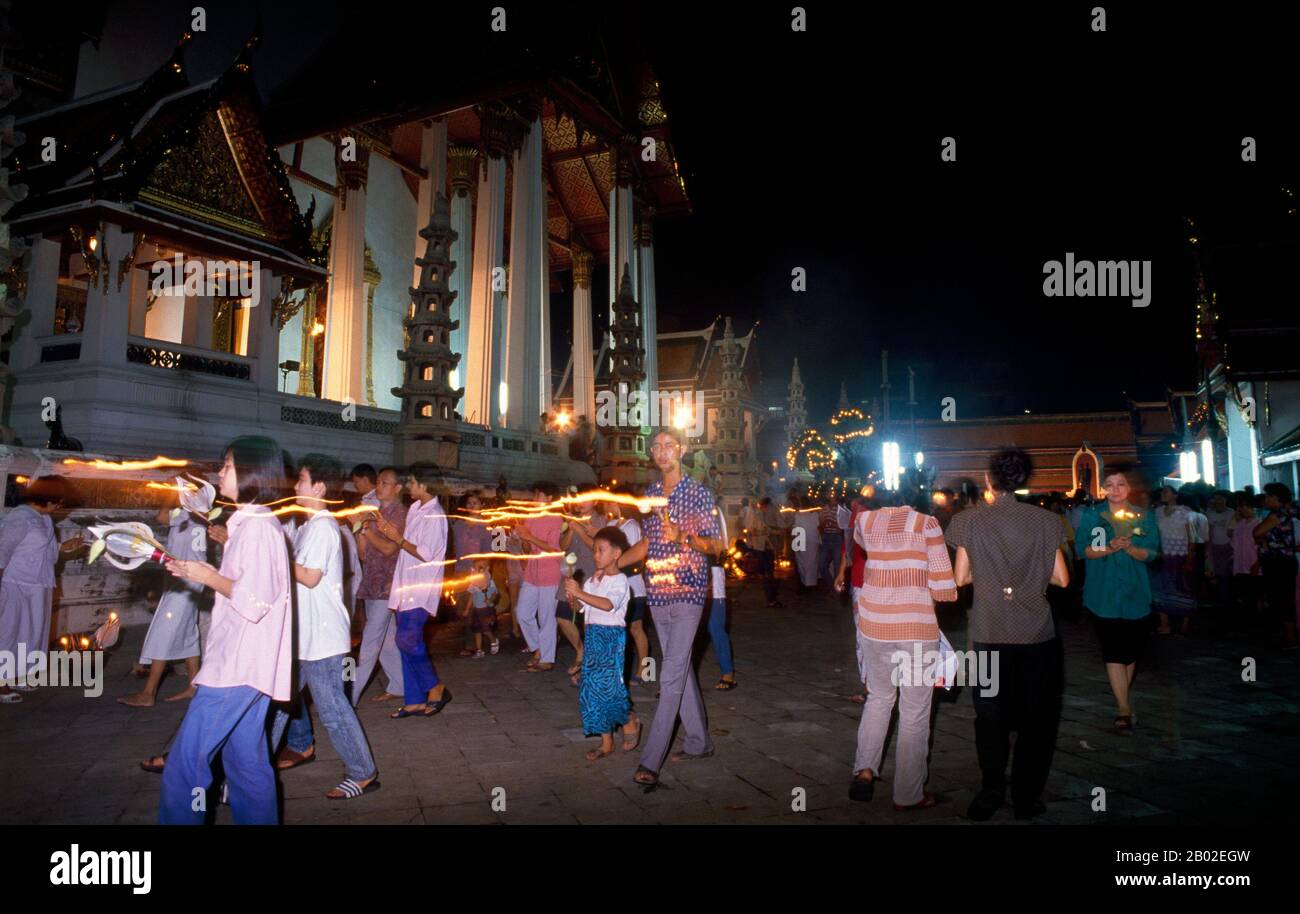 Beginning on the 15th day of the sixth lunar month, the Visakha Puja festival celebrates the Buddha’s birth, enlightenment and passing away, and is marked at Buddhist temples by chanting and preaching, and candlelit processions in the evening. Wat Suthat Thepphawararam is a royal temple of the first grade, one of six such temples in Thailand. Construction was begun by King Buddha Yodfa Chulaloke (Rama I) in 1807. Further construction and decorations were carried out by King Buddha Loetla Nabhalai (Rama II) who helped carve the wooden doors, but the temple was not completed until the reign of Stock Photohttps://www.alamy.com/image-license-details/?v=1https://www.alamy.com/beginning-on-the-15th-day-of-the-sixth-lunar-month-the-visakha-puja-festival-celebrates-the-buddhas-birth-enlightenment-and-passing-away-and-is-marked-at-buddhist-temples-by-chanting-and-preaching-and-candlelit-processions-in-the-evening-wat-suthat-thepphawararam-is-a-royal-temple-of-the-first-grade-one-of-six-such-temples-in-thailand-construction-was-begun-by-king-buddha-yodfa-chulaloke-rama-i-in-1807-further-construction-and-decorations-were-carried-out-by-king-buddha-loetla-nabhalai-rama-ii-who-helped-carve-the-wooden-doors-but-the-temple-was-not-completed-until-the-reign-of-image344262713.html
Beginning on the 15th day of the sixth lunar month, the Visakha Puja festival celebrates the Buddha’s birth, enlightenment and passing away, and is marked at Buddhist temples by chanting and preaching, and candlelit processions in the evening. Wat Suthat Thepphawararam is a royal temple of the first grade, one of six such temples in Thailand. Construction was begun by King Buddha Yodfa Chulaloke (Rama I) in 1807. Further construction and decorations were carried out by King Buddha Loetla Nabhalai (Rama II) who helped carve the wooden doors, but the temple was not completed until the reign of Stock Photohttps://www.alamy.com/image-license-details/?v=1https://www.alamy.com/beginning-on-the-15th-day-of-the-sixth-lunar-month-the-visakha-puja-festival-celebrates-the-buddhas-birth-enlightenment-and-passing-away-and-is-marked-at-buddhist-temples-by-chanting-and-preaching-and-candlelit-processions-in-the-evening-wat-suthat-thepphawararam-is-a-royal-temple-of-the-first-grade-one-of-six-such-temples-in-thailand-construction-was-begun-by-king-buddha-yodfa-chulaloke-rama-i-in-1807-further-construction-and-decorations-were-carried-out-by-king-buddha-loetla-nabhalai-rama-ii-who-helped-carve-the-wooden-doors-but-the-temple-was-not-completed-until-the-reign-of-image344262713.htmlRM2B02EGW–Beginning on the 15th day of the sixth lunar month, the Visakha Puja festival celebrates the Buddha’s birth, enlightenment and passing away, and is marked at Buddhist temples by chanting and preaching, and candlelit processions in the evening. Wat Suthat Thepphawararam is a royal temple of the first grade, one of six such temples in Thailand. Construction was begun by King Buddha Yodfa Chulaloke (Rama I) in 1807. Further construction and decorations were carried out by King Buddha Loetla Nabhalai (Rama II) who helped carve the wooden doors, but the temple was not completed until the reign of
 Beginning on the 15th day of the sixth lunar month, the Visakha Puja festival celebrates the Buddha’s birth, enlightenment and passing away, and is marked at Buddhist temples by chanting and preaching, and candlelit processions in the evening. Wat Suthat Thepphawararam is a royal temple of the first grade, one of six such temples in Thailand. Construction was begun by King Buddha Yodfa Chulaloke (Rama I) in 1807. Further construction and decorations were carried out by King Buddha Loetla Nabhalai (Rama II) who helped carve the wooden doors, but the temple was not completed until the reign of Stock Photohttps://www.alamy.com/image-license-details/?v=1https://www.alamy.com/beginning-on-the-15th-day-of-the-sixth-lunar-month-the-visakha-puja-festival-celebrates-the-buddhas-birth-enlightenment-and-passing-away-and-is-marked-at-buddhist-temples-by-chanting-and-preaching-and-candlelit-processions-in-the-evening-wat-suthat-thepphawararam-is-a-royal-temple-of-the-first-grade-one-of-six-such-temples-in-thailand-construction-was-begun-by-king-buddha-yodfa-chulaloke-rama-i-in-1807-further-construction-and-decorations-were-carried-out-by-king-buddha-loetla-nabhalai-rama-ii-who-helped-carve-the-wooden-doors-but-the-temple-was-not-completed-until-the-reign-of-image344271082.html
Beginning on the 15th day of the sixth lunar month, the Visakha Puja festival celebrates the Buddha’s birth, enlightenment and passing away, and is marked at Buddhist temples by chanting and preaching, and candlelit processions in the evening. Wat Suthat Thepphawararam is a royal temple of the first grade, one of six such temples in Thailand. Construction was begun by King Buddha Yodfa Chulaloke (Rama I) in 1807. Further construction and decorations were carried out by King Buddha Loetla Nabhalai (Rama II) who helped carve the wooden doors, but the temple was not completed until the reign of Stock Photohttps://www.alamy.com/image-license-details/?v=1https://www.alamy.com/beginning-on-the-15th-day-of-the-sixth-lunar-month-the-visakha-puja-festival-celebrates-the-buddhas-birth-enlightenment-and-passing-away-and-is-marked-at-buddhist-temples-by-chanting-and-preaching-and-candlelit-processions-in-the-evening-wat-suthat-thepphawararam-is-a-royal-temple-of-the-first-grade-one-of-six-such-temples-in-thailand-construction-was-begun-by-king-buddha-yodfa-chulaloke-rama-i-in-1807-further-construction-and-decorations-were-carried-out-by-king-buddha-loetla-nabhalai-rama-ii-who-helped-carve-the-wooden-doors-but-the-temple-was-not-completed-until-the-reign-of-image344271082.htmlRM2B02W7P–Beginning on the 15th day of the sixth lunar month, the Visakha Puja festival celebrates the Buddha’s birth, enlightenment and passing away, and is marked at Buddhist temples by chanting and preaching, and candlelit processions in the evening. Wat Suthat Thepphawararam is a royal temple of the first grade, one of six such temples in Thailand. Construction was begun by King Buddha Yodfa Chulaloke (Rama I) in 1807. Further construction and decorations were carried out by King Buddha Loetla Nabhalai (Rama II) who helped carve the wooden doors, but the temple was not completed until the reign of
 Beginning on the 15th day of the sixth lunar month, the Visakha Puja festival celebrates the Buddha’s birth, enlightenment and passing away, and is marked at Buddhist temples by chanting and preaching, and candlelit processions in the evening. Wat Suthat Thepphawararam is a royal temple of the first grade, one of six such temples in Thailand. Construction was begun by King Buddha Yodfa Chulaloke (Rama I) in 1807. Further construction and decorations were carried out by King Buddha Loetla Nabhalai (Rama II) who helped carve the wooden doors, but the temple was not completed until the reign of Stock Photohttps://www.alamy.com/image-license-details/?v=1https://www.alamy.com/beginning-on-the-15th-day-of-the-sixth-lunar-month-the-visakha-puja-festival-celebrates-the-buddhas-birth-enlightenment-and-passing-away-and-is-marked-at-buddhist-temples-by-chanting-and-preaching-and-candlelit-processions-in-the-evening-wat-suthat-thepphawararam-is-a-royal-temple-of-the-first-grade-one-of-six-such-temples-in-thailand-construction-was-begun-by-king-buddha-yodfa-chulaloke-rama-i-in-1807-further-construction-and-decorations-were-carried-out-by-king-buddha-loetla-nabhalai-rama-ii-who-helped-carve-the-wooden-doors-but-the-temple-was-not-completed-until-the-reign-of-image344271087.html
Beginning on the 15th day of the sixth lunar month, the Visakha Puja festival celebrates the Buddha’s birth, enlightenment and passing away, and is marked at Buddhist temples by chanting and preaching, and candlelit processions in the evening. Wat Suthat Thepphawararam is a royal temple of the first grade, one of six such temples in Thailand. Construction was begun by King Buddha Yodfa Chulaloke (Rama I) in 1807. Further construction and decorations were carried out by King Buddha Loetla Nabhalai (Rama II) who helped carve the wooden doors, but the temple was not completed until the reign of Stock Photohttps://www.alamy.com/image-license-details/?v=1https://www.alamy.com/beginning-on-the-15th-day-of-the-sixth-lunar-month-the-visakha-puja-festival-celebrates-the-buddhas-birth-enlightenment-and-passing-away-and-is-marked-at-buddhist-temples-by-chanting-and-preaching-and-candlelit-processions-in-the-evening-wat-suthat-thepphawararam-is-a-royal-temple-of-the-first-grade-one-of-six-such-temples-in-thailand-construction-was-begun-by-king-buddha-yodfa-chulaloke-rama-i-in-1807-further-construction-and-decorations-were-carried-out-by-king-buddha-loetla-nabhalai-rama-ii-who-helped-carve-the-wooden-doors-but-the-temple-was-not-completed-until-the-reign-of-image344271087.htmlRM2B02W7Y–Beginning on the 15th day of the sixth lunar month, the Visakha Puja festival celebrates the Buddha’s birth, enlightenment and passing away, and is marked at Buddhist temples by chanting and preaching, and candlelit processions in the evening. Wat Suthat Thepphawararam is a royal temple of the first grade, one of six such temples in Thailand. Construction was begun by King Buddha Yodfa Chulaloke (Rama I) in 1807. Further construction and decorations were carried out by King Buddha Loetla Nabhalai (Rama II) who helped carve the wooden doors, but the temple was not completed until the reign of
 Beginning on the 15th day of the sixth lunar month, the Visakha Puja festival celebrates the Buddha’s birth, enlightenment and passing away, and is marked at Buddhist temples by chanting and preaching, and candlelit processions in the evening. Wat Suthat Thepphawararam is a royal temple of the first grade, one of six such temples in Thailand. Construction was begun by King Buddha Yodfa Chulaloke (Rama I) in 1807. Further construction and decorations were carried out by King Buddha Loetla Nabhalai (Rama II) who helped carve the wooden doors, but the temple was not completed until the reign of Stock Photohttps://www.alamy.com/image-license-details/?v=1https://www.alamy.com/beginning-on-the-15th-day-of-the-sixth-lunar-month-the-visakha-puja-festival-celebrates-the-buddhas-birth-enlightenment-and-passing-away-and-is-marked-at-buddhist-temples-by-chanting-and-preaching-and-candlelit-processions-in-the-evening-wat-suthat-thepphawararam-is-a-royal-temple-of-the-first-grade-one-of-six-such-temples-in-thailand-construction-was-begun-by-king-buddha-yodfa-chulaloke-rama-i-in-1807-further-construction-and-decorations-were-carried-out-by-king-buddha-loetla-nabhalai-rama-ii-who-helped-carve-the-wooden-doors-but-the-temple-was-not-completed-until-the-reign-of-image344271085.html
Beginning on the 15th day of the sixth lunar month, the Visakha Puja festival celebrates the Buddha’s birth, enlightenment and passing away, and is marked at Buddhist temples by chanting and preaching, and candlelit processions in the evening. Wat Suthat Thepphawararam is a royal temple of the first grade, one of six such temples in Thailand. Construction was begun by King Buddha Yodfa Chulaloke (Rama I) in 1807. Further construction and decorations were carried out by King Buddha Loetla Nabhalai (Rama II) who helped carve the wooden doors, but the temple was not completed until the reign of Stock Photohttps://www.alamy.com/image-license-details/?v=1https://www.alamy.com/beginning-on-the-15th-day-of-the-sixth-lunar-month-the-visakha-puja-festival-celebrates-the-buddhas-birth-enlightenment-and-passing-away-and-is-marked-at-buddhist-temples-by-chanting-and-preaching-and-candlelit-processions-in-the-evening-wat-suthat-thepphawararam-is-a-royal-temple-of-the-first-grade-one-of-six-such-temples-in-thailand-construction-was-begun-by-king-buddha-yodfa-chulaloke-rama-i-in-1807-further-construction-and-decorations-were-carried-out-by-king-buddha-loetla-nabhalai-rama-ii-who-helped-carve-the-wooden-doors-but-the-temple-was-not-completed-until-the-reign-of-image344271085.htmlRM2B02W7W–Beginning on the 15th day of the sixth lunar month, the Visakha Puja festival celebrates the Buddha’s birth, enlightenment and passing away, and is marked at Buddhist temples by chanting and preaching, and candlelit processions in the evening. Wat Suthat Thepphawararam is a royal temple of the first grade, one of six such temples in Thailand. Construction was begun by King Buddha Yodfa Chulaloke (Rama I) in 1807. Further construction and decorations were carried out by King Buddha Loetla Nabhalai (Rama II) who helped carve the wooden doors, but the temple was not completed until the reign of
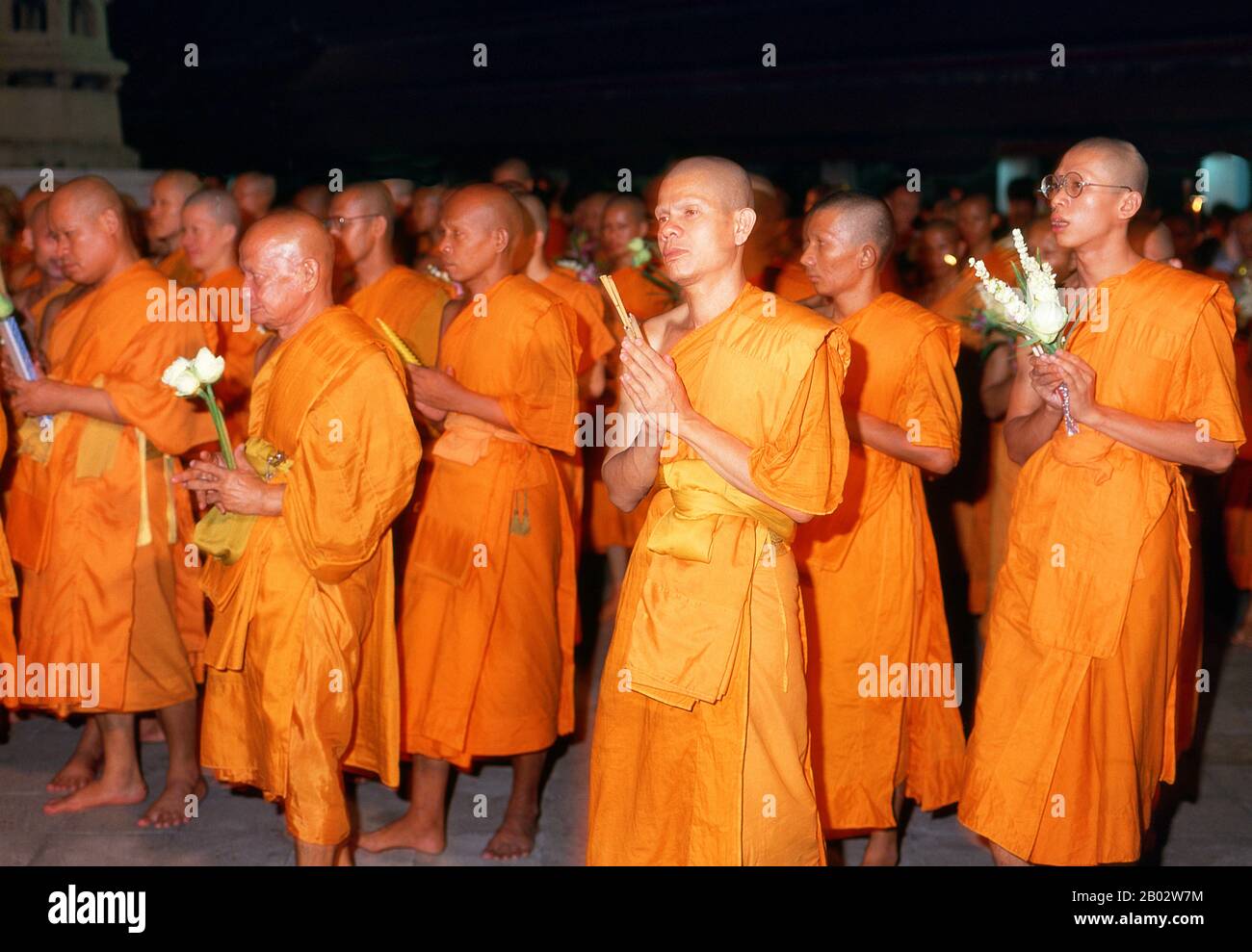 Beginning on the 15th day of the sixth lunar month, the Visakha Puja festival celebrates the Buddha’s birth, enlightenment and passing away, and is marked at Buddhist temples by chanting and preaching, and candlelit processions in the evening. Wat Suthat Thepphawararam is a royal temple of the first grade, one of six such temples in Thailand. Construction was begun by King Buddha Yodfa Chulaloke (Rama I) in 1807. Further construction and decorations were carried out by King Buddha Loetla Nabhalai (Rama II) who helped carve the wooden doors, but the temple was not completed until the reign of Stock Photohttps://www.alamy.com/image-license-details/?v=1https://www.alamy.com/beginning-on-the-15th-day-of-the-sixth-lunar-month-the-visakha-puja-festival-celebrates-the-buddhas-birth-enlightenment-and-passing-away-and-is-marked-at-buddhist-temples-by-chanting-and-preaching-and-candlelit-processions-in-the-evening-wat-suthat-thepphawararam-is-a-royal-temple-of-the-first-grade-one-of-six-such-temples-in-thailand-construction-was-begun-by-king-buddha-yodfa-chulaloke-rama-i-in-1807-further-construction-and-decorations-were-carried-out-by-king-buddha-loetla-nabhalai-rama-ii-who-helped-carve-the-wooden-doors-but-the-temple-was-not-completed-until-the-reign-of-image344271080.html
Beginning on the 15th day of the sixth lunar month, the Visakha Puja festival celebrates the Buddha’s birth, enlightenment and passing away, and is marked at Buddhist temples by chanting and preaching, and candlelit processions in the evening. Wat Suthat Thepphawararam is a royal temple of the first grade, one of six such temples in Thailand. Construction was begun by King Buddha Yodfa Chulaloke (Rama I) in 1807. Further construction and decorations were carried out by King Buddha Loetla Nabhalai (Rama II) who helped carve the wooden doors, but the temple was not completed until the reign of Stock Photohttps://www.alamy.com/image-license-details/?v=1https://www.alamy.com/beginning-on-the-15th-day-of-the-sixth-lunar-month-the-visakha-puja-festival-celebrates-the-buddhas-birth-enlightenment-and-passing-away-and-is-marked-at-buddhist-temples-by-chanting-and-preaching-and-candlelit-processions-in-the-evening-wat-suthat-thepphawararam-is-a-royal-temple-of-the-first-grade-one-of-six-such-temples-in-thailand-construction-was-begun-by-king-buddha-yodfa-chulaloke-rama-i-in-1807-further-construction-and-decorations-were-carried-out-by-king-buddha-loetla-nabhalai-rama-ii-who-helped-carve-the-wooden-doors-but-the-temple-was-not-completed-until-the-reign-of-image344271080.htmlRM2B02W7M–Beginning on the 15th day of the sixth lunar month, the Visakha Puja festival celebrates the Buddha’s birth, enlightenment and passing away, and is marked at Buddhist temples by chanting and preaching, and candlelit processions in the evening. Wat Suthat Thepphawararam is a royal temple of the first grade, one of six such temples in Thailand. Construction was begun by King Buddha Yodfa Chulaloke (Rama I) in 1807. Further construction and decorations were carried out by King Buddha Loetla Nabhalai (Rama II) who helped carve the wooden doors, but the temple was not completed until the reign of
 Beginning on the 15th day of the sixth lunar month, the Visakha Puja festival celebrates the Buddha’s birth, enlightenment and passing away, and is marked at Buddhist temples by chanting and preaching, and candlelit processions in the evening. Wat Suthat Thepphawararam is a royal temple of the first grade, one of six such temples in Thailand. Construction was begun by King Buddha Yodfa Chulaloke (Rama I) in 1807. Further construction and decorations were carried out by King Buddha Loetla Nabhalai (Rama II) who helped carve the wooden doors, but the temple was not completed until the reign of Stock Photohttps://www.alamy.com/image-license-details/?v=1https://www.alamy.com/beginning-on-the-15th-day-of-the-sixth-lunar-month-the-visakha-puja-festival-celebrates-the-buddhas-birth-enlightenment-and-passing-away-and-is-marked-at-buddhist-temples-by-chanting-and-preaching-and-candlelit-processions-in-the-evening-wat-suthat-thepphawararam-is-a-royal-temple-of-the-first-grade-one-of-six-such-temples-in-thailand-construction-was-begun-by-king-buddha-yodfa-chulaloke-rama-i-in-1807-further-construction-and-decorations-were-carried-out-by-king-buddha-loetla-nabhalai-rama-ii-who-helped-carve-the-wooden-doors-but-the-temple-was-not-completed-until-the-reign-of-image344271083.html
Beginning on the 15th day of the sixth lunar month, the Visakha Puja festival celebrates the Buddha’s birth, enlightenment and passing away, and is marked at Buddhist temples by chanting and preaching, and candlelit processions in the evening. Wat Suthat Thepphawararam is a royal temple of the first grade, one of six such temples in Thailand. Construction was begun by King Buddha Yodfa Chulaloke (Rama I) in 1807. Further construction and decorations were carried out by King Buddha Loetla Nabhalai (Rama II) who helped carve the wooden doors, but the temple was not completed until the reign of Stock Photohttps://www.alamy.com/image-license-details/?v=1https://www.alamy.com/beginning-on-the-15th-day-of-the-sixth-lunar-month-the-visakha-puja-festival-celebrates-the-buddhas-birth-enlightenment-and-passing-away-and-is-marked-at-buddhist-temples-by-chanting-and-preaching-and-candlelit-processions-in-the-evening-wat-suthat-thepphawararam-is-a-royal-temple-of-the-first-grade-one-of-six-such-temples-in-thailand-construction-was-begun-by-king-buddha-yodfa-chulaloke-rama-i-in-1807-further-construction-and-decorations-were-carried-out-by-king-buddha-loetla-nabhalai-rama-ii-who-helped-carve-the-wooden-doors-but-the-temple-was-not-completed-until-the-reign-of-image344271083.htmlRM2B02W7R–Beginning on the 15th day of the sixth lunar month, the Visakha Puja festival celebrates the Buddha’s birth, enlightenment and passing away, and is marked at Buddhist temples by chanting and preaching, and candlelit processions in the evening. Wat Suthat Thepphawararam is a royal temple of the first grade, one of six such temples in Thailand. Construction was begun by King Buddha Yodfa Chulaloke (Rama I) in 1807. Further construction and decorations were carried out by King Buddha Loetla Nabhalai (Rama II) who helped carve the wooden doors, but the temple was not completed until the reign of
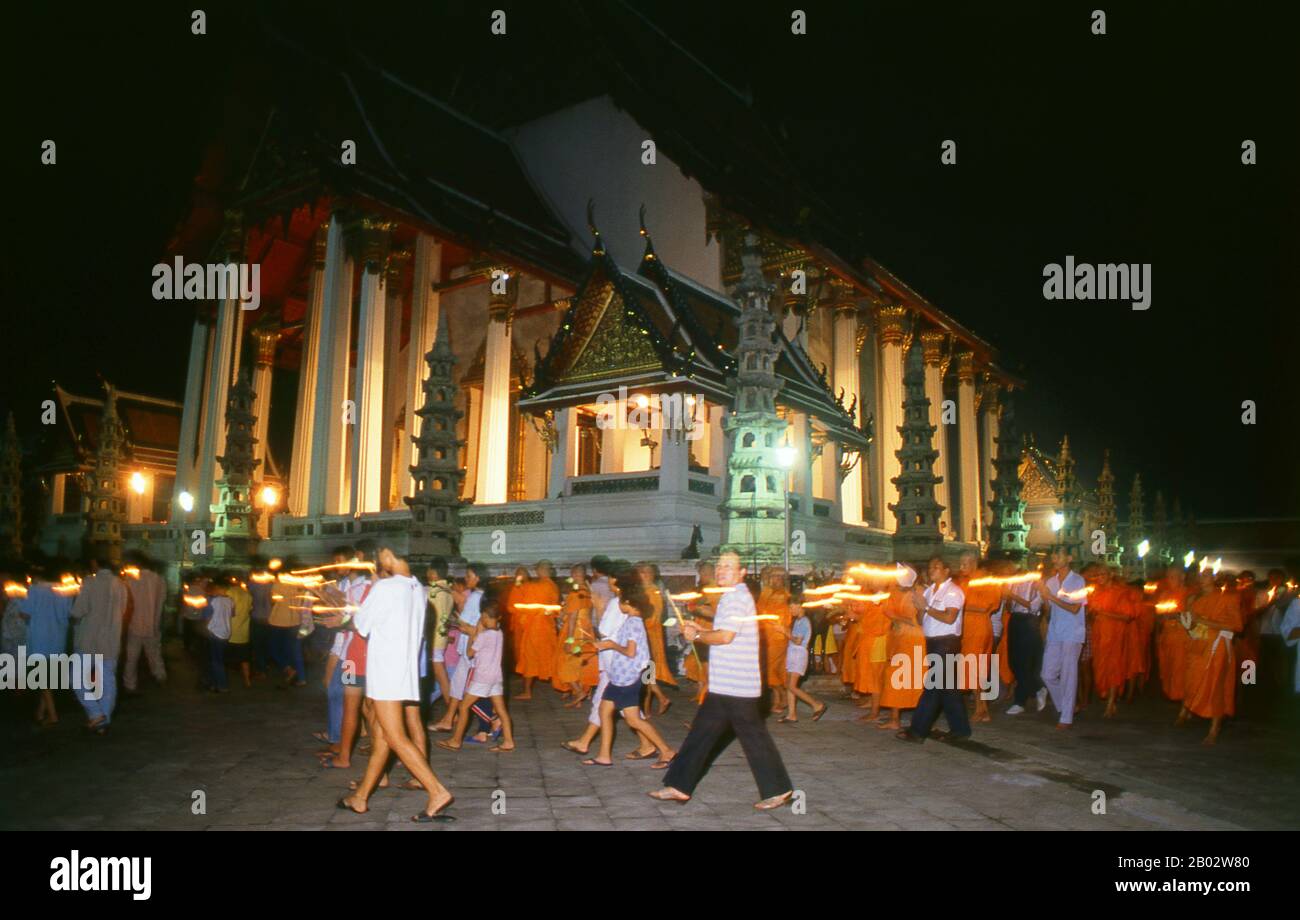 Beginning on the 15th day of the sixth lunar month, the Visakha Puja festival celebrates the Buddha’s birth, enlightenment and passing away, and is marked at Buddhist temples by chanting and preaching, and candlelit processions in the evening. Wat Suthat Thepphawararam is a royal temple of the first grade, one of six such temples in Thailand. Construction was begun by King Buddha Yodfa Chulaloke (Rama I) in 1807. Further construction and decorations were carried out by King Buddha Loetla Nabhalai (Rama II) who helped carve the wooden doors, but the temple was not completed until the reign of Stock Photohttps://www.alamy.com/image-license-details/?v=1https://www.alamy.com/beginning-on-the-15th-day-of-the-sixth-lunar-month-the-visakha-puja-festival-celebrates-the-buddhas-birth-enlightenment-and-passing-away-and-is-marked-at-buddhist-temples-by-chanting-and-preaching-and-candlelit-processions-in-the-evening-wat-suthat-thepphawararam-is-a-royal-temple-of-the-first-grade-one-of-six-such-temples-in-thailand-construction-was-begun-by-king-buddha-yodfa-chulaloke-rama-i-in-1807-further-construction-and-decorations-were-carried-out-by-king-buddha-loetla-nabhalai-rama-ii-who-helped-carve-the-wooden-doors-but-the-temple-was-not-completed-until-the-reign-of-image344271088.html
Beginning on the 15th day of the sixth lunar month, the Visakha Puja festival celebrates the Buddha’s birth, enlightenment and passing away, and is marked at Buddhist temples by chanting and preaching, and candlelit processions in the evening. Wat Suthat Thepphawararam is a royal temple of the first grade, one of six such temples in Thailand. Construction was begun by King Buddha Yodfa Chulaloke (Rama I) in 1807. Further construction and decorations were carried out by King Buddha Loetla Nabhalai (Rama II) who helped carve the wooden doors, but the temple was not completed until the reign of Stock Photohttps://www.alamy.com/image-license-details/?v=1https://www.alamy.com/beginning-on-the-15th-day-of-the-sixth-lunar-month-the-visakha-puja-festival-celebrates-the-buddhas-birth-enlightenment-and-passing-away-and-is-marked-at-buddhist-temples-by-chanting-and-preaching-and-candlelit-processions-in-the-evening-wat-suthat-thepphawararam-is-a-royal-temple-of-the-first-grade-one-of-six-such-temples-in-thailand-construction-was-begun-by-king-buddha-yodfa-chulaloke-rama-i-in-1807-further-construction-and-decorations-were-carried-out-by-king-buddha-loetla-nabhalai-rama-ii-who-helped-carve-the-wooden-doors-but-the-temple-was-not-completed-until-the-reign-of-image344271088.htmlRM2B02W80–Beginning on the 15th day of the sixth lunar month, the Visakha Puja festival celebrates the Buddha’s birth, enlightenment and passing away, and is marked at Buddhist temples by chanting and preaching, and candlelit processions in the evening. Wat Suthat Thepphawararam is a royal temple of the first grade, one of six such temples in Thailand. Construction was begun by King Buddha Yodfa Chulaloke (Rama I) in 1807. Further construction and decorations were carried out by King Buddha Loetla Nabhalai (Rama II) who helped carve the wooden doors, but the temple was not completed until the reign of
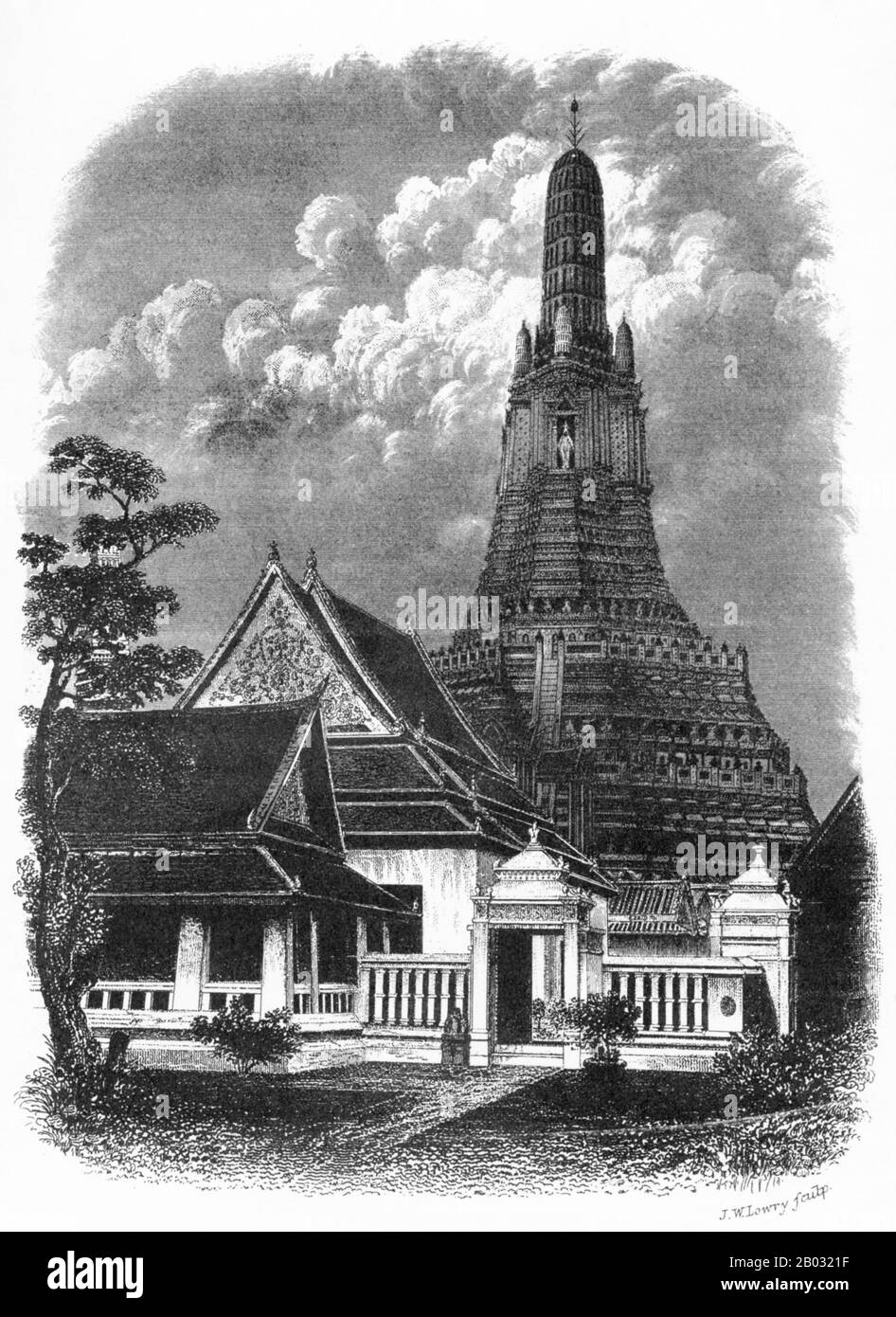 Wat Arun Rajwararam (Temple of the Dawn), full name Wat Arunratchawararam Ratchaworamahawihan, is a Thai Buddhist temple on the Thonburi west bank side of the Chao Phraya River in Bangkok. It is named after Aruna, the Indian God of Dawn. A monastery has stood here since the Ayutthayan period (1351 - 1767), but the temple's outstanding feature, the Khmer-style central prang, was not begun until 1809, during the reign of King Buddha Loetla Nabhalai (Rama II). Stock Photohttps://www.alamy.com/image-license-details/?v=1https://www.alamy.com/wat-arun-rajwararam-temple-of-the-dawn-full-name-wat-arunratchawararam-ratchaworamahawihan-is-a-thai-buddhist-temple-on-the-thonburi-west-bank-side-of-the-chao-phraya-river-in-bangkok-it-is-named-after-aruna-the-indian-god-of-dawn-a-monastery-has-stood-here-since-the-ayutthayan-period-1351-1767-but-the-temples-outstanding-feature-the-khmer-style-central-prang-was-not-begun-until-1809-during-the-reign-of-king-buddha-loetla-nabhalai-rama-ii-image344274827.html
Wat Arun Rajwararam (Temple of the Dawn), full name Wat Arunratchawararam Ratchaworamahawihan, is a Thai Buddhist temple on the Thonburi west bank side of the Chao Phraya River in Bangkok. It is named after Aruna, the Indian God of Dawn. A monastery has stood here since the Ayutthayan period (1351 - 1767), but the temple's outstanding feature, the Khmer-style central prang, was not begun until 1809, during the reign of King Buddha Loetla Nabhalai (Rama II). Stock Photohttps://www.alamy.com/image-license-details/?v=1https://www.alamy.com/wat-arun-rajwararam-temple-of-the-dawn-full-name-wat-arunratchawararam-ratchaworamahawihan-is-a-thai-buddhist-temple-on-the-thonburi-west-bank-side-of-the-chao-phraya-river-in-bangkok-it-is-named-after-aruna-the-indian-god-of-dawn-a-monastery-has-stood-here-since-the-ayutthayan-period-1351-1767-but-the-temples-outstanding-feature-the-khmer-style-central-prang-was-not-begun-until-1809-during-the-reign-of-king-buddha-loetla-nabhalai-rama-ii-image344274827.htmlRM2B0321F–Wat Arun Rajwararam (Temple of the Dawn), full name Wat Arunratchawararam Ratchaworamahawihan, is a Thai Buddhist temple on the Thonburi west bank side of the Chao Phraya River in Bangkok. It is named after Aruna, the Indian God of Dawn. A monastery has stood here since the Ayutthayan period (1351 - 1767), but the temple's outstanding feature, the Khmer-style central prang, was not begun until 1809, during the reign of King Buddha Loetla Nabhalai (Rama II).
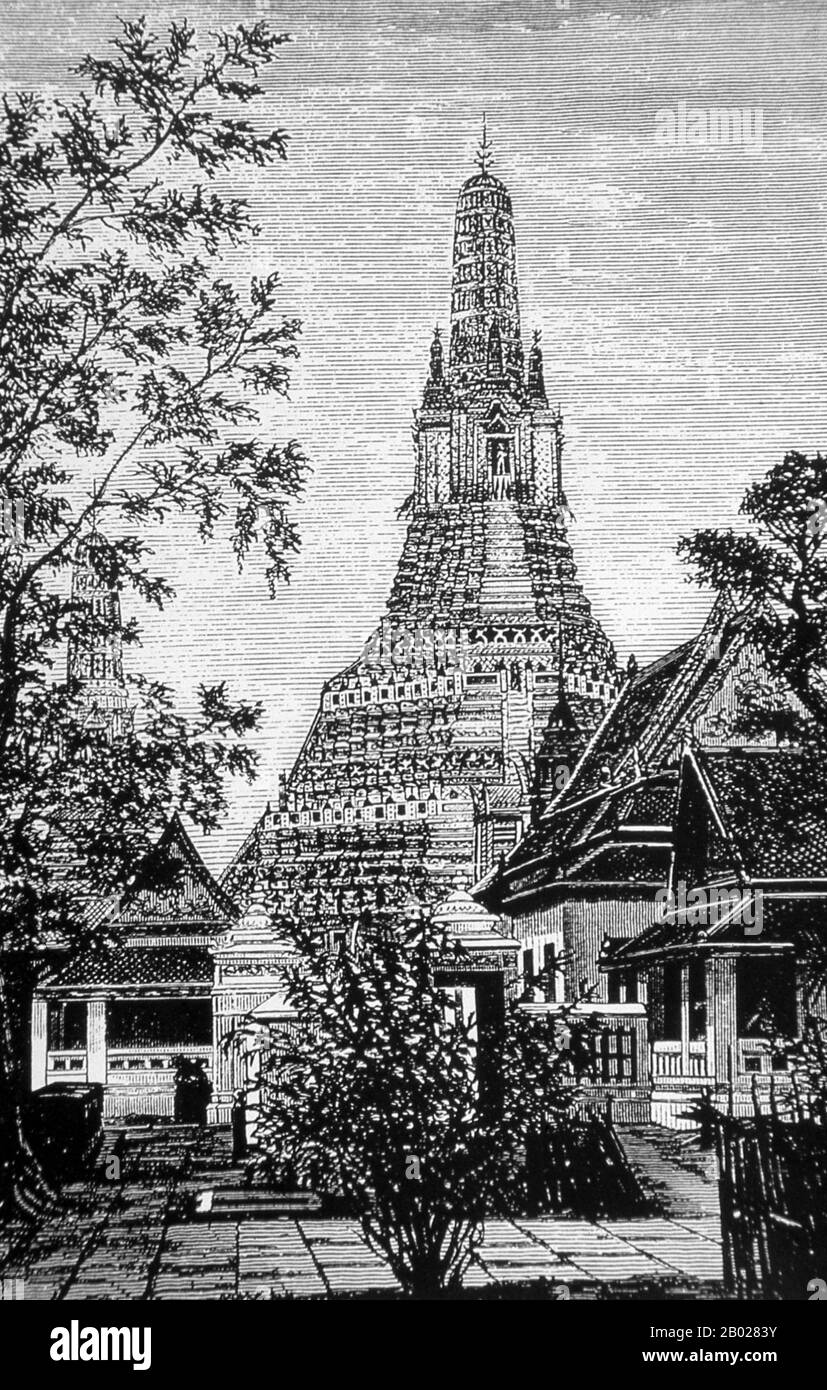 Wat Arun Rajwararam (Temple of the Dawn), full name Wat Arunratchawararam Ratchaworamahawihan, is a Thai Buddhist temple on the Thonburi west bank side of the Chao Phraya River in Bangkok. It is named after Aruna, the Indian God of Dawn. A monastery has stood here since the Ayutthayan period (1351 - 1767), but the temple's outstanding feature, the Khmer-style central prang, was not begun until 1809, during the reign of King Buddha Loetla Nabhalai (Rama II). Stock Photohttps://www.alamy.com/image-license-details/?v=1https://www.alamy.com/wat-arun-rajwararam-temple-of-the-dawn-full-name-wat-arunratchawararam-ratchaworamahawihan-is-a-thai-buddhist-temple-on-the-thonburi-west-bank-side-of-the-chao-phraya-river-in-bangkok-it-is-named-after-aruna-the-indian-god-of-dawn-a-monastery-has-stood-here-since-the-ayutthayan-period-1351-1767-but-the-temples-outstanding-feature-the-khmer-style-central-prang-was-not-begun-until-1809-during-the-reign-of-king-buddha-loetla-nabhalai-rama-ii-image344257647.html
Wat Arun Rajwararam (Temple of the Dawn), full name Wat Arunratchawararam Ratchaworamahawihan, is a Thai Buddhist temple on the Thonburi west bank side of the Chao Phraya River in Bangkok. It is named after Aruna, the Indian God of Dawn. A monastery has stood here since the Ayutthayan period (1351 - 1767), but the temple's outstanding feature, the Khmer-style central prang, was not begun until 1809, during the reign of King Buddha Loetla Nabhalai (Rama II). Stock Photohttps://www.alamy.com/image-license-details/?v=1https://www.alamy.com/wat-arun-rajwararam-temple-of-the-dawn-full-name-wat-arunratchawararam-ratchaworamahawihan-is-a-thai-buddhist-temple-on-the-thonburi-west-bank-side-of-the-chao-phraya-river-in-bangkok-it-is-named-after-aruna-the-indian-god-of-dawn-a-monastery-has-stood-here-since-the-ayutthayan-period-1351-1767-but-the-temples-outstanding-feature-the-khmer-style-central-prang-was-not-begun-until-1809-during-the-reign-of-king-buddha-loetla-nabhalai-rama-ii-image344257647.htmlRM2B0283Y–Wat Arun Rajwararam (Temple of the Dawn), full name Wat Arunratchawararam Ratchaworamahawihan, is a Thai Buddhist temple on the Thonburi west bank side of the Chao Phraya River in Bangkok. It is named after Aruna, the Indian God of Dawn. A monastery has stood here since the Ayutthayan period (1351 - 1767), but the temple's outstanding feature, the Khmer-style central prang, was not begun until 1809, during the reign of King Buddha Loetla Nabhalai (Rama II).
 Wat Arun Rajwararam (Temple of the Dawn), full name Wat Arunratchawararam Ratchaworamahawihan, is a Thai Buddhist temple on the Thonburi west bank side of the Chao Phraya River in Bangkok. It is named after Aruna, the Indian God of Dawn. A monastery has stood here since the Ayutthayan period (1351 - 1767), but the temple's outstanding feature, the Khmer-style central prang, was not begun until 1809, during the reign of King Buddha Loetla Nabhalai (Rama II). Stock Photohttps://www.alamy.com/image-license-details/?v=1https://www.alamy.com/wat-arun-rajwararam-temple-of-the-dawn-full-name-wat-arunratchawararam-ratchaworamahawihan-is-a-thai-buddhist-temple-on-the-thonburi-west-bank-side-of-the-chao-phraya-river-in-bangkok-it-is-named-after-aruna-the-indian-god-of-dawn-a-monastery-has-stood-here-since-the-ayutthayan-period-1351-1767-but-the-temples-outstanding-feature-the-khmer-style-central-prang-was-not-begun-until-1809-during-the-reign-of-king-buddha-loetla-nabhalai-rama-ii-image344257646.html
Wat Arun Rajwararam (Temple of the Dawn), full name Wat Arunratchawararam Ratchaworamahawihan, is a Thai Buddhist temple on the Thonburi west bank side of the Chao Phraya River in Bangkok. It is named after Aruna, the Indian God of Dawn. A monastery has stood here since the Ayutthayan period (1351 - 1767), but the temple's outstanding feature, the Khmer-style central prang, was not begun until 1809, during the reign of King Buddha Loetla Nabhalai (Rama II). Stock Photohttps://www.alamy.com/image-license-details/?v=1https://www.alamy.com/wat-arun-rajwararam-temple-of-the-dawn-full-name-wat-arunratchawararam-ratchaworamahawihan-is-a-thai-buddhist-temple-on-the-thonburi-west-bank-side-of-the-chao-phraya-river-in-bangkok-it-is-named-after-aruna-the-indian-god-of-dawn-a-monastery-has-stood-here-since-the-ayutthayan-period-1351-1767-but-the-temples-outstanding-feature-the-khmer-style-central-prang-was-not-begun-until-1809-during-the-reign-of-king-buddha-loetla-nabhalai-rama-ii-image344257646.htmlRM2B0283X–Wat Arun Rajwararam (Temple of the Dawn), full name Wat Arunratchawararam Ratchaworamahawihan, is a Thai Buddhist temple on the Thonburi west bank side of the Chao Phraya River in Bangkok. It is named after Aruna, the Indian God of Dawn. A monastery has stood here since the Ayutthayan period (1351 - 1767), but the temple's outstanding feature, the Khmer-style central prang, was not begun until 1809, during the reign of King Buddha Loetla Nabhalai (Rama II).
 Thailand: Wat Arun (Temple of Dawn), Bangkok. Wat Arun Rajwararam (Temple of the Dawn), full name Wat Arunratchawararam Ratchaworamahawihan, is a Thai Buddhist temple on the Thonburi west bank side of the Chao Phraya River in Bangkok. It is named after Aruna, the Indian God of Dawn. A monastery has stood here since the Ayutthayan period (1351 - 1767), but the temple's outstanding feature, the Khmer-style central prang, was not begun until 1809, during the reign of King Buddha Loetla Nabhalai (Rama II). Stock Photohttps://www.alamy.com/image-license-details/?v=1https://www.alamy.com/thailand-wat-arun-temple-of-dawn-bangkok-wat-arun-rajwararam-temple-of-the-dawn-full-name-wat-arunratchawararam-ratchaworamahawihan-is-a-thai-buddhist-temple-on-the-thonburi-west-bank-side-of-the-chao-phraya-river-in-bangkok-it-is-named-after-aruna-the-indian-god-of-dawn-a-monastery-has-stood-here-since-the-ayutthayan-period-1351-1767-but-the-temples-outstanding-feature-the-khmer-style-central-prang-was-not-begun-until-1809-during-the-reign-of-king-buddha-loetla-nabhalai-rama-ii-image344235329.html
Thailand: Wat Arun (Temple of Dawn), Bangkok. Wat Arun Rajwararam (Temple of the Dawn), full name Wat Arunratchawararam Ratchaworamahawihan, is a Thai Buddhist temple on the Thonburi west bank side of the Chao Phraya River in Bangkok. It is named after Aruna, the Indian God of Dawn. A monastery has stood here since the Ayutthayan period (1351 - 1767), but the temple's outstanding feature, the Khmer-style central prang, was not begun until 1809, during the reign of King Buddha Loetla Nabhalai (Rama II). Stock Photohttps://www.alamy.com/image-license-details/?v=1https://www.alamy.com/thailand-wat-arun-temple-of-dawn-bangkok-wat-arun-rajwararam-temple-of-the-dawn-full-name-wat-arunratchawararam-ratchaworamahawihan-is-a-thai-buddhist-temple-on-the-thonburi-west-bank-side-of-the-chao-phraya-river-in-bangkok-it-is-named-after-aruna-the-indian-god-of-dawn-a-monastery-has-stood-here-since-the-ayutthayan-period-1351-1767-but-the-temples-outstanding-feature-the-khmer-style-central-prang-was-not-begun-until-1809-during-the-reign-of-king-buddha-loetla-nabhalai-rama-ii-image344235329.htmlRM2B017JW–Thailand: Wat Arun (Temple of Dawn), Bangkok. Wat Arun Rajwararam (Temple of the Dawn), full name Wat Arunratchawararam Ratchaworamahawihan, is a Thai Buddhist temple on the Thonburi west bank side of the Chao Phraya River in Bangkok. It is named after Aruna, the Indian God of Dawn. A monastery has stood here since the Ayutthayan period (1351 - 1767), but the temple's outstanding feature, the Khmer-style central prang, was not begun until 1809, during the reign of King Buddha Loetla Nabhalai (Rama II).
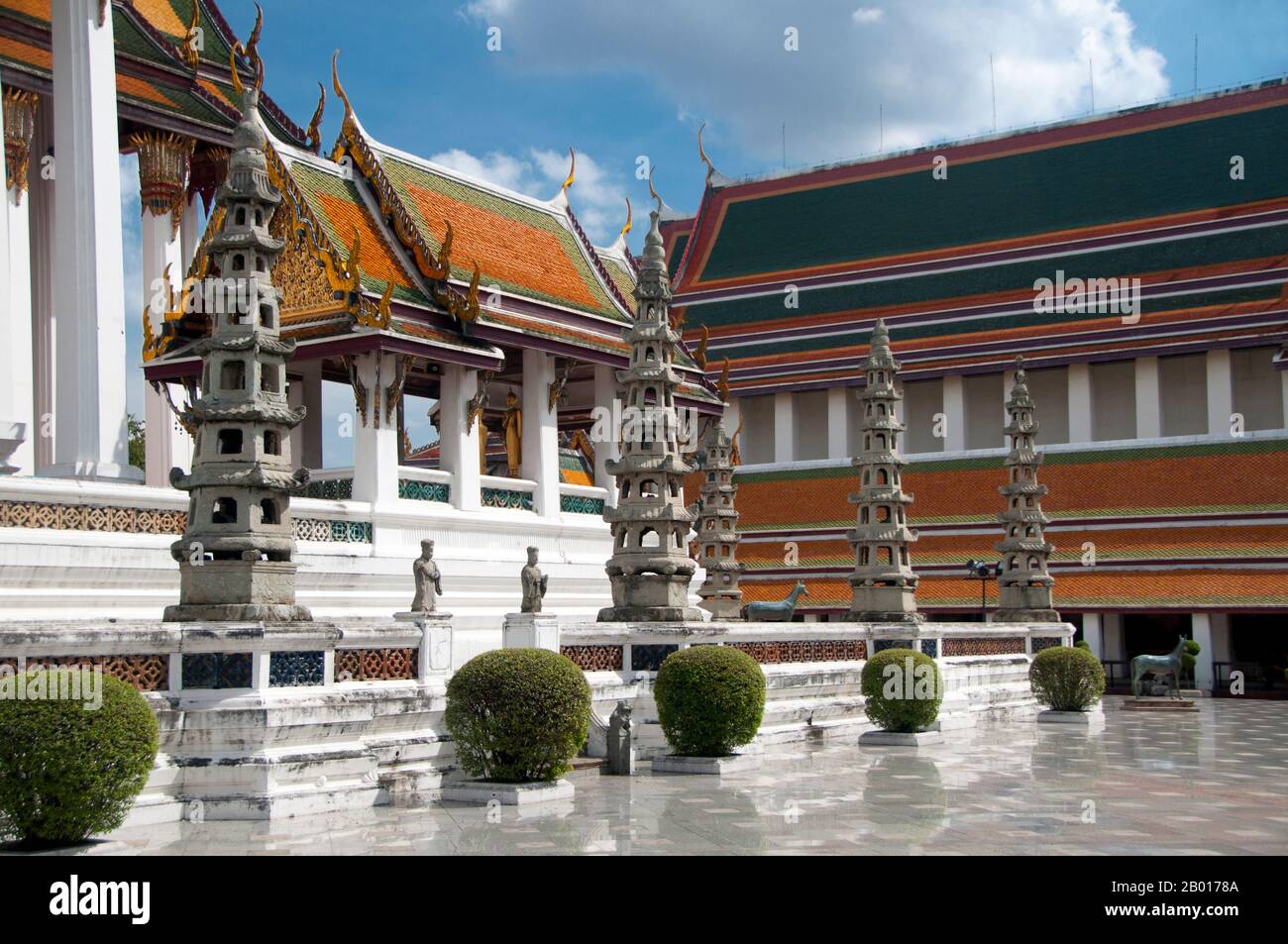 Thailand: Some of the 28 Chinese pagodas that surround the terrace of the viharn, Wat Suthat, Bangkok. Wat Suthat Thepphawararam is a royal temple of the first grade, one of six such temples in Thailand. Construction was begun by King Buddha Yodfa Chulaloke (Rama I) in 1807. Further construction and decorations were carried out by King Buddha Loetla Nabhalai (Rama II) who helped carve the wooden doors, but the temple was not completed until the reign of King Jessadabodindra (Rama III) in 1847. The temple is a fine example of the Rattanakosin architectural style. Stock Photohttps://www.alamy.com/image-license-details/?v=1https://www.alamy.com/thailand-some-of-the-28-chinese-pagodas-that-surround-the-terrace-of-the-viharn-wat-suthat-bangkok-wat-suthat-thepphawararam-is-a-royal-temple-of-the-first-grade-one-of-six-such-temples-in-thailand-construction-was-begun-by-king-buddha-yodfa-chulaloke-rama-i-in-1807-further-construction-and-decorations-were-carried-out-by-king-buddha-loetla-nabhalai-rama-ii-who-helped-carve-the-wooden-doors-but-the-temple-was-not-completed-until-the-reign-of-king-jessadabodindra-rama-iii-in-1847-the-temple-is-a-fine-example-of-the-rattanakosin-architectural-style-image344235034.html
Thailand: Some of the 28 Chinese pagodas that surround the terrace of the viharn, Wat Suthat, Bangkok. Wat Suthat Thepphawararam is a royal temple of the first grade, one of six such temples in Thailand. Construction was begun by King Buddha Yodfa Chulaloke (Rama I) in 1807. Further construction and decorations were carried out by King Buddha Loetla Nabhalai (Rama II) who helped carve the wooden doors, but the temple was not completed until the reign of King Jessadabodindra (Rama III) in 1847. The temple is a fine example of the Rattanakosin architectural style. Stock Photohttps://www.alamy.com/image-license-details/?v=1https://www.alamy.com/thailand-some-of-the-28-chinese-pagodas-that-surround-the-terrace-of-the-viharn-wat-suthat-bangkok-wat-suthat-thepphawararam-is-a-royal-temple-of-the-first-grade-one-of-six-such-temples-in-thailand-construction-was-begun-by-king-buddha-yodfa-chulaloke-rama-i-in-1807-further-construction-and-decorations-were-carried-out-by-king-buddha-loetla-nabhalai-rama-ii-who-helped-carve-the-wooden-doors-but-the-temple-was-not-completed-until-the-reign-of-king-jessadabodindra-rama-iii-in-1847-the-temple-is-a-fine-example-of-the-rattanakosin-architectural-style-image344235034.htmlRM2B0178A–Thailand: Some of the 28 Chinese pagodas that surround the terrace of the viharn, Wat Suthat, Bangkok. Wat Suthat Thepphawararam is a royal temple of the first grade, one of six such temples in Thailand. Construction was begun by King Buddha Yodfa Chulaloke (Rama I) in 1807. Further construction and decorations were carried out by King Buddha Loetla Nabhalai (Rama II) who helped carve the wooden doors, but the temple was not completed until the reign of King Jessadabodindra (Rama III) in 1847. The temple is a fine example of the Rattanakosin architectural style.
 Thailand: Statuary in front of the main viharn, Wat Suthat, Bangkok. Wat Suthat Thepphawararam is a royal temple of the first grade, one of six such temples in Thailand. Construction was begun by King Buddha Yodfa Chulaloke (Rama I) in 1807. Further construction and decorations were carried out by King Buddha Loetla Nabhalai (Rama II) who helped carve the wooden doors, but the temple was not completed until the reign of King Jessadabodindra (Rama III) in 1847. The temple is a fine example of the Rattanakosin architectural style. Stock Photohttps://www.alamy.com/image-license-details/?v=1https://www.alamy.com/thailand-statuary-in-front-of-the-main-viharn-wat-suthat-bangkok-wat-suthat-thepphawararam-is-a-royal-temple-of-the-first-grade-one-of-six-such-temples-in-thailand-construction-was-begun-by-king-buddha-yodfa-chulaloke-rama-i-in-1807-further-construction-and-decorations-were-carried-out-by-king-buddha-loetla-nabhalai-rama-ii-who-helped-carve-the-wooden-doors-but-the-temple-was-not-completed-until-the-reign-of-king-jessadabodindra-rama-iii-in-1847-the-temple-is-a-fine-example-of-the-rattanakosin-architectural-style-image344235039.html
Thailand: Statuary in front of the main viharn, Wat Suthat, Bangkok. Wat Suthat Thepphawararam is a royal temple of the first grade, one of six such temples in Thailand. Construction was begun by King Buddha Yodfa Chulaloke (Rama I) in 1807. Further construction and decorations were carried out by King Buddha Loetla Nabhalai (Rama II) who helped carve the wooden doors, but the temple was not completed until the reign of King Jessadabodindra (Rama III) in 1847. The temple is a fine example of the Rattanakosin architectural style. Stock Photohttps://www.alamy.com/image-license-details/?v=1https://www.alamy.com/thailand-statuary-in-front-of-the-main-viharn-wat-suthat-bangkok-wat-suthat-thepphawararam-is-a-royal-temple-of-the-first-grade-one-of-six-such-temples-in-thailand-construction-was-begun-by-king-buddha-yodfa-chulaloke-rama-i-in-1807-further-construction-and-decorations-were-carried-out-by-king-buddha-loetla-nabhalai-rama-ii-who-helped-carve-the-wooden-doors-but-the-temple-was-not-completed-until-the-reign-of-king-jessadabodindra-rama-iii-in-1847-the-temple-is-a-fine-example-of-the-rattanakosin-architectural-style-image344235039.htmlRM2B0178F–Thailand: Statuary in front of the main viharn, Wat Suthat, Bangkok. Wat Suthat Thepphawararam is a royal temple of the first grade, one of six such temples in Thailand. Construction was begun by King Buddha Yodfa Chulaloke (Rama I) in 1807. Further construction and decorations were carried out by King Buddha Loetla Nabhalai (Rama II) who helped carve the wooden doors, but the temple was not completed until the reign of King Jessadabodindra (Rama III) in 1847. The temple is a fine example of the Rattanakosin architectural style.
 Thailand: Some of the 28 Chinese pagodas that surround the terrace of the viharn, Wat Suthat, Bangkok. Wat Suthat Thepphawararam is a royal temple of the first grade, one of six such temples in Thailand. Construction was begun by King Buddha Yodfa Chulaloke (Rama I) in 1807. Further construction and decorations were carried out by King Buddha Loetla Nabhalai (Rama II) who helped carve the wooden doors, but the temple was not completed until the reign of King Jessadabodindra (Rama III) in 1847. The temple is a fine example of the Rattanakosin architectural style. Stock Photohttps://www.alamy.com/image-license-details/?v=1https://www.alamy.com/thailand-some-of-the-28-chinese-pagodas-that-surround-the-terrace-of-the-viharn-wat-suthat-bangkok-wat-suthat-thepphawararam-is-a-royal-temple-of-the-first-grade-one-of-six-such-temples-in-thailand-construction-was-begun-by-king-buddha-yodfa-chulaloke-rama-i-in-1807-further-construction-and-decorations-were-carried-out-by-king-buddha-loetla-nabhalai-rama-ii-who-helped-carve-the-wooden-doors-but-the-temple-was-not-completed-until-the-reign-of-king-jessadabodindra-rama-iii-in-1847-the-temple-is-a-fine-example-of-the-rattanakosin-architectural-style-image344235037.html
Thailand: Some of the 28 Chinese pagodas that surround the terrace of the viharn, Wat Suthat, Bangkok. Wat Suthat Thepphawararam is a royal temple of the first grade, one of six such temples in Thailand. Construction was begun by King Buddha Yodfa Chulaloke (Rama I) in 1807. Further construction and decorations were carried out by King Buddha Loetla Nabhalai (Rama II) who helped carve the wooden doors, but the temple was not completed until the reign of King Jessadabodindra (Rama III) in 1847. The temple is a fine example of the Rattanakosin architectural style. Stock Photohttps://www.alamy.com/image-license-details/?v=1https://www.alamy.com/thailand-some-of-the-28-chinese-pagodas-that-surround-the-terrace-of-the-viharn-wat-suthat-bangkok-wat-suthat-thepphawararam-is-a-royal-temple-of-the-first-grade-one-of-six-such-temples-in-thailand-construction-was-begun-by-king-buddha-yodfa-chulaloke-rama-i-in-1807-further-construction-and-decorations-were-carried-out-by-king-buddha-loetla-nabhalai-rama-ii-who-helped-carve-the-wooden-doors-but-the-temple-was-not-completed-until-the-reign-of-king-jessadabodindra-rama-iii-in-1847-the-temple-is-a-fine-example-of-the-rattanakosin-architectural-style-image344235037.htmlRM2B0178D–Thailand: Some of the 28 Chinese pagodas that surround the terrace of the viharn, Wat Suthat, Bangkok. Wat Suthat Thepphawararam is a royal temple of the first grade, one of six such temples in Thailand. Construction was begun by King Buddha Yodfa Chulaloke (Rama I) in 1807. Further construction and decorations were carried out by King Buddha Loetla Nabhalai (Rama II) who helped carve the wooden doors, but the temple was not completed until the reign of King Jessadabodindra (Rama III) in 1847. The temple is a fine example of the Rattanakosin architectural style.
 Thailand: Some of the 28 Chinese pagodas that surround the terrace of the viharn, Wat Suthat, Bangkok. Wat Suthat Thepphawararam is a royal temple of the first grade, one of six such temples in Thailand. Construction was begun by King Buddha Yodfa Chulaloke (Rama I) in 1807. Further construction and decorations were carried out by King Buddha Loetla Nabhalai (Rama II) who helped carve the wooden doors, but the temple was not completed until the reign of King Jessadabodindra (Rama III) in 1847. The temple is a fine example of the Rattanakosin architectural style. Stock Photohttps://www.alamy.com/image-license-details/?v=1https://www.alamy.com/thailand-some-of-the-28-chinese-pagodas-that-surround-the-terrace-of-the-viharn-wat-suthat-bangkok-wat-suthat-thepphawararam-is-a-royal-temple-of-the-first-grade-one-of-six-such-temples-in-thailand-construction-was-begun-by-king-buddha-yodfa-chulaloke-rama-i-in-1807-further-construction-and-decorations-were-carried-out-by-king-buddha-loetla-nabhalai-rama-ii-who-helped-carve-the-wooden-doors-but-the-temple-was-not-completed-until-the-reign-of-king-jessadabodindra-rama-iii-in-1847-the-temple-is-a-fine-example-of-the-rattanakosin-architectural-style-image344235038.html
Thailand: Some of the 28 Chinese pagodas that surround the terrace of the viharn, Wat Suthat, Bangkok. Wat Suthat Thepphawararam is a royal temple of the first grade, one of six such temples in Thailand. Construction was begun by King Buddha Yodfa Chulaloke (Rama I) in 1807. Further construction and decorations were carried out by King Buddha Loetla Nabhalai (Rama II) who helped carve the wooden doors, but the temple was not completed until the reign of King Jessadabodindra (Rama III) in 1847. The temple is a fine example of the Rattanakosin architectural style. Stock Photohttps://www.alamy.com/image-license-details/?v=1https://www.alamy.com/thailand-some-of-the-28-chinese-pagodas-that-surround-the-terrace-of-the-viharn-wat-suthat-bangkok-wat-suthat-thepphawararam-is-a-royal-temple-of-the-first-grade-one-of-six-such-temples-in-thailand-construction-was-begun-by-king-buddha-yodfa-chulaloke-rama-i-in-1807-further-construction-and-decorations-were-carried-out-by-king-buddha-loetla-nabhalai-rama-ii-who-helped-carve-the-wooden-doors-but-the-temple-was-not-completed-until-the-reign-of-king-jessadabodindra-rama-iii-in-1847-the-temple-is-a-fine-example-of-the-rattanakosin-architectural-style-image344235038.htmlRM2B0178E–Thailand: Some of the 28 Chinese pagodas that surround the terrace of the viharn, Wat Suthat, Bangkok. Wat Suthat Thepphawararam is a royal temple of the first grade, one of six such temples in Thailand. Construction was begun by King Buddha Yodfa Chulaloke (Rama I) in 1807. Further construction and decorations were carried out by King Buddha Loetla Nabhalai (Rama II) who helped carve the wooden doors, but the temple was not completed until the reign of King Jessadabodindra (Rama III) in 1847. The temple is a fine example of the Rattanakosin architectural style.
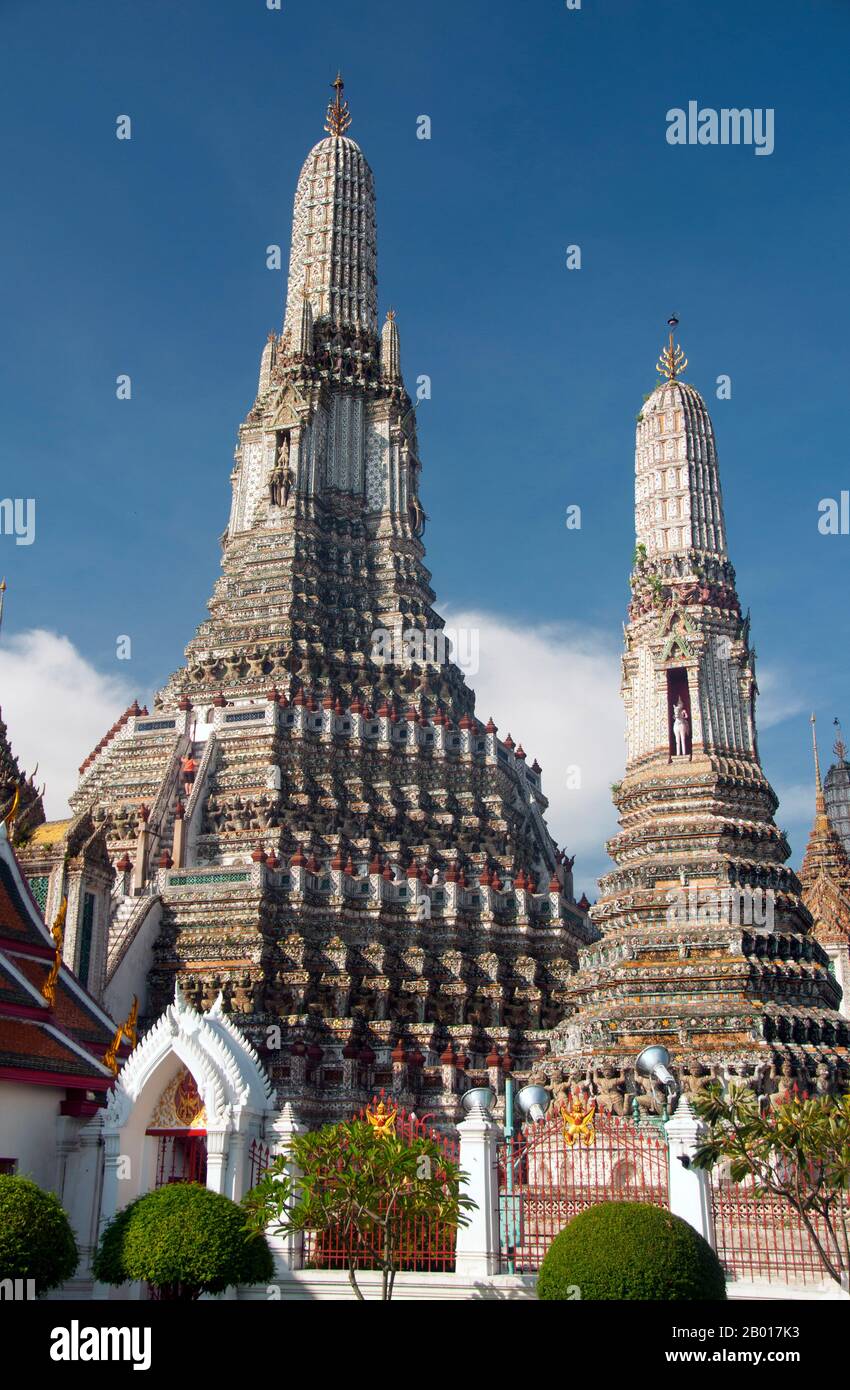 Thailand: The Khmer-style central prang at Wat Arun (Temple of Dawn), Bangkok. Wat Arun Rajwararam (Temple of the Dawn), full name Wat Arunratchawararam Ratchaworamahawihan, is a Thai Buddhist temple on the Thonburi west bank side of the Chao Phraya River in Bangkok. It is named after Aruna, the Indian God of Dawn. A monastery has stood here since the Ayutthayan period (1351 - 1767), but the temple's outstanding feature, the Khmer-style central prang, was not begun until 1809, during the reign of King Buddha Loetla Nabhalai (Rama II). Stock Photohttps://www.alamy.com/image-license-details/?v=1https://www.alamy.com/thailand-the-khmer-style-central-prang-at-wat-arun-temple-of-dawn-bangkok-wat-arun-rajwararam-temple-of-the-dawn-full-name-wat-arunratchawararam-ratchaworamahawihan-is-a-thai-buddhist-temple-on-the-thonburi-west-bank-side-of-the-chao-phraya-river-in-bangkok-it-is-named-after-aruna-the-indian-god-of-dawn-a-monastery-has-stood-here-since-the-ayutthayan-period-1351-1767-but-the-temples-outstanding-feature-the-khmer-style-central-prang-was-not-begun-until-1809-during-the-reign-of-king-buddha-loetla-nabhalai-rama-ii-image344235335.html
Thailand: The Khmer-style central prang at Wat Arun (Temple of Dawn), Bangkok. Wat Arun Rajwararam (Temple of the Dawn), full name Wat Arunratchawararam Ratchaworamahawihan, is a Thai Buddhist temple on the Thonburi west bank side of the Chao Phraya River in Bangkok. It is named after Aruna, the Indian God of Dawn. A monastery has stood here since the Ayutthayan period (1351 - 1767), but the temple's outstanding feature, the Khmer-style central prang, was not begun until 1809, during the reign of King Buddha Loetla Nabhalai (Rama II). Stock Photohttps://www.alamy.com/image-license-details/?v=1https://www.alamy.com/thailand-the-khmer-style-central-prang-at-wat-arun-temple-of-dawn-bangkok-wat-arun-rajwararam-temple-of-the-dawn-full-name-wat-arunratchawararam-ratchaworamahawihan-is-a-thai-buddhist-temple-on-the-thonburi-west-bank-side-of-the-chao-phraya-river-in-bangkok-it-is-named-after-aruna-the-indian-god-of-dawn-a-monastery-has-stood-here-since-the-ayutthayan-period-1351-1767-but-the-temples-outstanding-feature-the-khmer-style-central-prang-was-not-begun-until-1809-during-the-reign-of-king-buddha-loetla-nabhalai-rama-ii-image344235335.htmlRM2B017K3–Thailand: The Khmer-style central prang at Wat Arun (Temple of Dawn), Bangkok. Wat Arun Rajwararam (Temple of the Dawn), full name Wat Arunratchawararam Ratchaworamahawihan, is a Thai Buddhist temple on the Thonburi west bank side of the Chao Phraya River in Bangkok. It is named after Aruna, the Indian God of Dawn. A monastery has stood here since the Ayutthayan period (1351 - 1767), but the temple's outstanding feature, the Khmer-style central prang, was not begun until 1809, during the reign of King Buddha Loetla Nabhalai (Rama II).
 Thailand: Giving alms to novice monks at Wat Arun (Temple of Dawn), Bangkok. Wat Arun Rajwararam (Temple of the Dawn), full name Wat Arunratchawararam Ratchaworamahawihan, is a Thai Buddhist temple on the Thonburi west bank side of the Chao Phraya River in Bangkok. It is named after Aruna, the Indian God of Dawn. A monastery has stood here since the Ayutthayan period (1351 - 1767), but the temple's outstanding feature, the Khmer-style central prang, was not begun until 1809, during the reign of King Buddha Loetla Nabhalai (Rama II). Stock Photohttps://www.alamy.com/image-license-details/?v=1https://www.alamy.com/thailand-giving-alms-to-novice-monks-at-wat-arun-temple-of-dawn-bangkok-wat-arun-rajwararam-temple-of-the-dawn-full-name-wat-arunratchawararam-ratchaworamahawihan-is-a-thai-buddhist-temple-on-the-thonburi-west-bank-side-of-the-chao-phraya-river-in-bangkok-it-is-named-after-aruna-the-indian-god-of-dawn-a-monastery-has-stood-here-since-the-ayutthayan-period-1351-1767-but-the-temples-outstanding-feature-the-khmer-style-central-prang-was-not-begun-until-1809-during-the-reign-of-king-buddha-loetla-nabhalai-rama-ii-image344235319.html
Thailand: Giving alms to novice monks at Wat Arun (Temple of Dawn), Bangkok. Wat Arun Rajwararam (Temple of the Dawn), full name Wat Arunratchawararam Ratchaworamahawihan, is a Thai Buddhist temple on the Thonburi west bank side of the Chao Phraya River in Bangkok. It is named after Aruna, the Indian God of Dawn. A monastery has stood here since the Ayutthayan period (1351 - 1767), but the temple's outstanding feature, the Khmer-style central prang, was not begun until 1809, during the reign of King Buddha Loetla Nabhalai (Rama II). Stock Photohttps://www.alamy.com/image-license-details/?v=1https://www.alamy.com/thailand-giving-alms-to-novice-monks-at-wat-arun-temple-of-dawn-bangkok-wat-arun-rajwararam-temple-of-the-dawn-full-name-wat-arunratchawararam-ratchaworamahawihan-is-a-thai-buddhist-temple-on-the-thonburi-west-bank-side-of-the-chao-phraya-river-in-bangkok-it-is-named-after-aruna-the-indian-god-of-dawn-a-monastery-has-stood-here-since-the-ayutthayan-period-1351-1767-but-the-temples-outstanding-feature-the-khmer-style-central-prang-was-not-begun-until-1809-during-the-reign-of-king-buddha-loetla-nabhalai-rama-ii-image344235319.htmlRM2B017JF–Thailand: Giving alms to novice monks at Wat Arun (Temple of Dawn), Bangkok. Wat Arun Rajwararam (Temple of the Dawn), full name Wat Arunratchawararam Ratchaworamahawihan, is a Thai Buddhist temple on the Thonburi west bank side of the Chao Phraya River in Bangkok. It is named after Aruna, the Indian God of Dawn. A monastery has stood here since the Ayutthayan period (1351 - 1767), but the temple's outstanding feature, the Khmer-style central prang, was not begun until 1809, during the reign of King Buddha Loetla Nabhalai (Rama II).
 Thailand: The Khmer-style central prang at Wat Arun (Temple of Dawn), Bangkok. Wat Arun Rajwararam (Temple of the Dawn), full name Wat Arunratchawararam Ratchaworamahawihan, is a Thai Buddhist temple on the Thonburi west bank side of the Chao Phraya River in Bangkok. It is named after Aruna, the Indian God of Dawn. A monastery has stood here since the Ayutthayan period (1351 - 1767), but the temple's outstanding feature, the Khmer-style central prang, was not begun until 1809, during the reign of King Buddha Loetla Nabhalai (Rama II). Stock Photohttps://www.alamy.com/image-license-details/?v=1https://www.alamy.com/thailand-the-khmer-style-central-prang-at-wat-arun-temple-of-dawn-bangkok-wat-arun-rajwararam-temple-of-the-dawn-full-name-wat-arunratchawararam-ratchaworamahawihan-is-a-thai-buddhist-temple-on-the-thonburi-west-bank-side-of-the-chao-phraya-river-in-bangkok-it-is-named-after-aruna-the-indian-god-of-dawn-a-monastery-has-stood-here-since-the-ayutthayan-period-1351-1767-but-the-temples-outstanding-feature-the-khmer-style-central-prang-was-not-begun-until-1809-during-the-reign-of-king-buddha-loetla-nabhalai-rama-ii-image344235341.html
Thailand: The Khmer-style central prang at Wat Arun (Temple of Dawn), Bangkok. Wat Arun Rajwararam (Temple of the Dawn), full name Wat Arunratchawararam Ratchaworamahawihan, is a Thai Buddhist temple on the Thonburi west bank side of the Chao Phraya River in Bangkok. It is named after Aruna, the Indian God of Dawn. A monastery has stood here since the Ayutthayan period (1351 - 1767), but the temple's outstanding feature, the Khmer-style central prang, was not begun until 1809, during the reign of King Buddha Loetla Nabhalai (Rama II). Stock Photohttps://www.alamy.com/image-license-details/?v=1https://www.alamy.com/thailand-the-khmer-style-central-prang-at-wat-arun-temple-of-dawn-bangkok-wat-arun-rajwararam-temple-of-the-dawn-full-name-wat-arunratchawararam-ratchaworamahawihan-is-a-thai-buddhist-temple-on-the-thonburi-west-bank-side-of-the-chao-phraya-river-in-bangkok-it-is-named-after-aruna-the-indian-god-of-dawn-a-monastery-has-stood-here-since-the-ayutthayan-period-1351-1767-but-the-temples-outstanding-feature-the-khmer-style-central-prang-was-not-begun-until-1809-during-the-reign-of-king-buddha-loetla-nabhalai-rama-ii-image344235341.htmlRM2B017K9–Thailand: The Khmer-style central prang at Wat Arun (Temple of Dawn), Bangkok. Wat Arun Rajwararam (Temple of the Dawn), full name Wat Arunratchawararam Ratchaworamahawihan, is a Thai Buddhist temple on the Thonburi west bank side of the Chao Phraya River in Bangkok. It is named after Aruna, the Indian God of Dawn. A monastery has stood here since the Ayutthayan period (1351 - 1767), but the temple's outstanding feature, the Khmer-style central prang, was not begun until 1809, during the reign of King Buddha Loetla Nabhalai (Rama II).
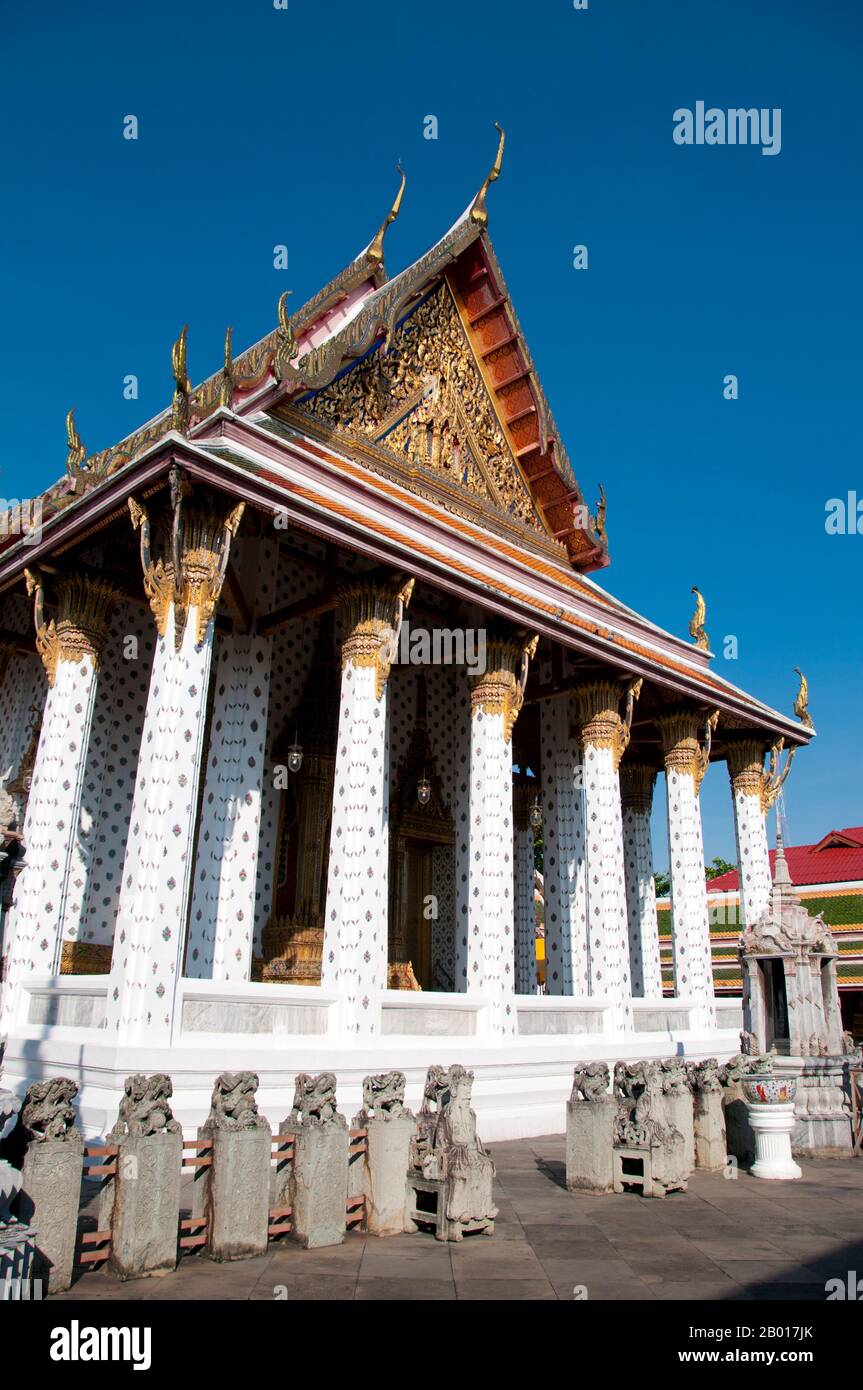 Thailand: The Ubosot (Bot) or ordination hall at Wat Arun (Temple of Dawn), Bangkok. Wat Arun Rajwararam (Temple of the Dawn), full name Wat Arunratchawararam Ratchaworamahawihan, is a Thai Buddhist temple on the Thonburi west bank side of the Chao Phraya River in Bangkok. It is named after Aruna, the Indian God of Dawn. A monastery has stood here since the Ayutthayan period (1351 - 1767), but the temple's outstanding feature, the Khmer-style central prang, was not begun until 1809, during the reign of King Buddha Loetla Nabhalai (Rama II). Stock Photohttps://www.alamy.com/image-license-details/?v=1https://www.alamy.com/thailand-the-ubosot-bot-or-ordination-hall-at-wat-arun-temple-of-dawn-bangkok-wat-arun-rajwararam-temple-of-the-dawn-full-name-wat-arunratchawararam-ratchaworamahawihan-is-a-thai-buddhist-temple-on-the-thonburi-west-bank-side-of-the-chao-phraya-river-in-bangkok-it-is-named-after-aruna-the-indian-god-of-dawn-a-monastery-has-stood-here-since-the-ayutthayan-period-1351-1767-but-the-temples-outstanding-feature-the-khmer-style-central-prang-was-not-begun-until-1809-during-the-reign-of-king-buddha-loetla-nabhalai-rama-ii-image344235323.html
Thailand: The Ubosot (Bot) or ordination hall at Wat Arun (Temple of Dawn), Bangkok. Wat Arun Rajwararam (Temple of the Dawn), full name Wat Arunratchawararam Ratchaworamahawihan, is a Thai Buddhist temple on the Thonburi west bank side of the Chao Phraya River in Bangkok. It is named after Aruna, the Indian God of Dawn. A monastery has stood here since the Ayutthayan period (1351 - 1767), but the temple's outstanding feature, the Khmer-style central prang, was not begun until 1809, during the reign of King Buddha Loetla Nabhalai (Rama II). Stock Photohttps://www.alamy.com/image-license-details/?v=1https://www.alamy.com/thailand-the-ubosot-bot-or-ordination-hall-at-wat-arun-temple-of-dawn-bangkok-wat-arun-rajwararam-temple-of-the-dawn-full-name-wat-arunratchawararam-ratchaworamahawihan-is-a-thai-buddhist-temple-on-the-thonburi-west-bank-side-of-the-chao-phraya-river-in-bangkok-it-is-named-after-aruna-the-indian-god-of-dawn-a-monastery-has-stood-here-since-the-ayutthayan-period-1351-1767-but-the-temples-outstanding-feature-the-khmer-style-central-prang-was-not-begun-until-1809-during-the-reign-of-king-buddha-loetla-nabhalai-rama-ii-image344235323.htmlRM2B017JK–Thailand: The Ubosot (Bot) or ordination hall at Wat Arun (Temple of Dawn), Bangkok. Wat Arun Rajwararam (Temple of the Dawn), full name Wat Arunratchawararam Ratchaworamahawihan, is a Thai Buddhist temple on the Thonburi west bank side of the Chao Phraya River in Bangkok. It is named after Aruna, the Indian God of Dawn. A monastery has stood here since the Ayutthayan period (1351 - 1767), but the temple's outstanding feature, the Khmer-style central prang, was not begun until 1809, during the reign of King Buddha Loetla Nabhalai (Rama II).
 Thailand: Wat Arun (Temple of Dawn) from the Chao Phraya River, Bangkok. Wat Arun Rajwararam (Temple of the Dawn), full name Wat Arunratchawararam Ratchaworamahawihan, is a Thai Buddhist temple on the Thonburi west bank side of the Chao Phraya River in Bangkok. It is named after Aruna, the Indian God of Dawn. A monastery has stood here since the Ayutthayan period (1351 - 1767), but the temple's outstanding feature, the Khmer-style central prang, was not begun until 1809, during the reign of King Buddha Loetla Nabhalai (Rama II). Stock Photohttps://www.alamy.com/image-license-details/?v=1https://www.alamy.com/thailand-wat-arun-temple-of-dawn-from-the-chao-phraya-river-bangkok-wat-arun-rajwararam-temple-of-the-dawn-full-name-wat-arunratchawararam-ratchaworamahawihan-is-a-thai-buddhist-temple-on-the-thonburi-west-bank-side-of-the-chao-phraya-river-in-bangkok-it-is-named-after-aruna-the-indian-god-of-dawn-a-monastery-has-stood-here-since-the-ayutthayan-period-1351-1767-but-the-temples-outstanding-feature-the-khmer-style-central-prang-was-not-begun-until-1809-during-the-reign-of-king-buddha-loetla-nabhalai-rama-ii-image344235315.html
Thailand: Wat Arun (Temple of Dawn) from the Chao Phraya River, Bangkok. Wat Arun Rajwararam (Temple of the Dawn), full name Wat Arunratchawararam Ratchaworamahawihan, is a Thai Buddhist temple on the Thonburi west bank side of the Chao Phraya River in Bangkok. It is named after Aruna, the Indian God of Dawn. A monastery has stood here since the Ayutthayan period (1351 - 1767), but the temple's outstanding feature, the Khmer-style central prang, was not begun until 1809, during the reign of King Buddha Loetla Nabhalai (Rama II). Stock Photohttps://www.alamy.com/image-license-details/?v=1https://www.alamy.com/thailand-wat-arun-temple-of-dawn-from-the-chao-phraya-river-bangkok-wat-arun-rajwararam-temple-of-the-dawn-full-name-wat-arunratchawararam-ratchaworamahawihan-is-a-thai-buddhist-temple-on-the-thonburi-west-bank-side-of-the-chao-phraya-river-in-bangkok-it-is-named-after-aruna-the-indian-god-of-dawn-a-monastery-has-stood-here-since-the-ayutthayan-period-1351-1767-but-the-temples-outstanding-feature-the-khmer-style-central-prang-was-not-begun-until-1809-during-the-reign-of-king-buddha-loetla-nabhalai-rama-ii-image344235315.htmlRM2B017JB–Thailand: Wat Arun (Temple of Dawn) from the Chao Phraya River, Bangkok. Wat Arun Rajwararam (Temple of the Dawn), full name Wat Arunratchawararam Ratchaworamahawihan, is a Thai Buddhist temple on the Thonburi west bank side of the Chao Phraya River in Bangkok. It is named after Aruna, the Indian God of Dawn. A monastery has stood here since the Ayutthayan period (1351 - 1767), but the temple's outstanding feature, the Khmer-style central prang, was not begun until 1809, during the reign of King Buddha Loetla Nabhalai (Rama II).
 Thailand: The Khmer-style central prang at Wat Arun (Temple of Dawn), Bangkok. Wat Arun Rajwararam (Temple of the Dawn), full name Wat Arunratchawararam Ratchaworamahawihan, is a Thai Buddhist temple on the Thonburi west bank side of the Chao Phraya River in Bangkok. It is named after Aruna, the Indian God of Dawn. A monastery has stood here since the Ayutthayan period (1351 - 1767), but the temple's outstanding feature, the Khmer-style central prang, was not begun until 1809, during the reign of King Buddha Loetla Nabhalai (Rama II). Stock Photohttps://www.alamy.com/image-license-details/?v=1https://www.alamy.com/thailand-the-khmer-style-central-prang-at-wat-arun-temple-of-dawn-bangkok-wat-arun-rajwararam-temple-of-the-dawn-full-name-wat-arunratchawararam-ratchaworamahawihan-is-a-thai-buddhist-temple-on-the-thonburi-west-bank-side-of-the-chao-phraya-river-in-bangkok-it-is-named-after-aruna-the-indian-god-of-dawn-a-monastery-has-stood-here-since-the-ayutthayan-period-1351-1767-but-the-temples-outstanding-feature-the-khmer-style-central-prang-was-not-begun-until-1809-during-the-reign-of-king-buddha-loetla-nabhalai-rama-ii-image344235338.html
Thailand: The Khmer-style central prang at Wat Arun (Temple of Dawn), Bangkok. Wat Arun Rajwararam (Temple of the Dawn), full name Wat Arunratchawararam Ratchaworamahawihan, is a Thai Buddhist temple on the Thonburi west bank side of the Chao Phraya River in Bangkok. It is named after Aruna, the Indian God of Dawn. A monastery has stood here since the Ayutthayan period (1351 - 1767), but the temple's outstanding feature, the Khmer-style central prang, was not begun until 1809, during the reign of King Buddha Loetla Nabhalai (Rama II). Stock Photohttps://www.alamy.com/image-license-details/?v=1https://www.alamy.com/thailand-the-khmer-style-central-prang-at-wat-arun-temple-of-dawn-bangkok-wat-arun-rajwararam-temple-of-the-dawn-full-name-wat-arunratchawararam-ratchaworamahawihan-is-a-thai-buddhist-temple-on-the-thonburi-west-bank-side-of-the-chao-phraya-river-in-bangkok-it-is-named-after-aruna-the-indian-god-of-dawn-a-monastery-has-stood-here-since-the-ayutthayan-period-1351-1767-but-the-temples-outstanding-feature-the-khmer-style-central-prang-was-not-begun-until-1809-during-the-reign-of-king-buddha-loetla-nabhalai-rama-ii-image344235338.htmlRM2B017K6–Thailand: The Khmer-style central prang at Wat Arun (Temple of Dawn), Bangkok. Wat Arun Rajwararam (Temple of the Dawn), full name Wat Arunratchawararam Ratchaworamahawihan, is a Thai Buddhist temple on the Thonburi west bank side of the Chao Phraya River in Bangkok. It is named after Aruna, the Indian God of Dawn. A monastery has stood here since the Ayutthayan period (1351 - 1767), but the temple's outstanding feature, the Khmer-style central prang, was not begun until 1809, during the reign of King Buddha Loetla Nabhalai (Rama II).
 Thailand: Giving alms to novice monks at Wat Arun (Temple of Dawn), Bangkok. Wat Arun Rajwararam (Temple of the Dawn), full name Wat Arunratchawararam Ratchaworamahawihan, is a Thai Buddhist temple on the Thonburi west bank side of the Chao Phraya River in Bangkok. It is named after Aruna, the Indian God of Dawn. A monastery has stood here since the Ayutthayan period (1351 - 1767), but the temple's outstanding feature, the Khmer-style central prang, was not begun until 1809, during the reign of King Buddha Loetla Nabhalai (Rama II). Stock Photohttps://www.alamy.com/image-license-details/?v=1https://www.alamy.com/thailand-giving-alms-to-novice-monks-at-wat-arun-temple-of-dawn-bangkok-wat-arun-rajwararam-temple-of-the-dawn-full-name-wat-arunratchawararam-ratchaworamahawihan-is-a-thai-buddhist-temple-on-the-thonburi-west-bank-side-of-the-chao-phraya-river-in-bangkok-it-is-named-after-aruna-the-indian-god-of-dawn-a-monastery-has-stood-here-since-the-ayutthayan-period-1351-1767-but-the-temples-outstanding-feature-the-khmer-style-central-prang-was-not-begun-until-1809-during-the-reign-of-king-buddha-loetla-nabhalai-rama-ii-image344235318.html
Thailand: Giving alms to novice monks at Wat Arun (Temple of Dawn), Bangkok. Wat Arun Rajwararam (Temple of the Dawn), full name Wat Arunratchawararam Ratchaworamahawihan, is a Thai Buddhist temple on the Thonburi west bank side of the Chao Phraya River in Bangkok. It is named after Aruna, the Indian God of Dawn. A monastery has stood here since the Ayutthayan period (1351 - 1767), but the temple's outstanding feature, the Khmer-style central prang, was not begun until 1809, during the reign of King Buddha Loetla Nabhalai (Rama II). Stock Photohttps://www.alamy.com/image-license-details/?v=1https://www.alamy.com/thailand-giving-alms-to-novice-monks-at-wat-arun-temple-of-dawn-bangkok-wat-arun-rajwararam-temple-of-the-dawn-full-name-wat-arunratchawararam-ratchaworamahawihan-is-a-thai-buddhist-temple-on-the-thonburi-west-bank-side-of-the-chao-phraya-river-in-bangkok-it-is-named-after-aruna-the-indian-god-of-dawn-a-monastery-has-stood-here-since-the-ayutthayan-period-1351-1767-but-the-temples-outstanding-feature-the-khmer-style-central-prang-was-not-begun-until-1809-during-the-reign-of-king-buddha-loetla-nabhalai-rama-ii-image344235318.htmlRM2B017JE–Thailand: Giving alms to novice monks at Wat Arun (Temple of Dawn), Bangkok. Wat Arun Rajwararam (Temple of the Dawn), full name Wat Arunratchawararam Ratchaworamahawihan, is a Thai Buddhist temple on the Thonburi west bank side of the Chao Phraya River in Bangkok. It is named after Aruna, the Indian God of Dawn. A monastery has stood here since the Ayutthayan period (1351 - 1767), but the temple's outstanding feature, the Khmer-style central prang, was not begun until 1809, during the reign of King Buddha Loetla Nabhalai (Rama II).
 Thailand: The Khmer-style central prang at Wat Arun (Temple of Dawn), Bangkok. Wat Arun Rajwararam (Temple of the Dawn), full name Wat Arunratchawararam Ratchaworamahawihan, is a Thai Buddhist temple on the Thonburi west bank side of the Chao Phraya River in Bangkok. It is named after Aruna, the Indian God of Dawn. A monastery has stood here since the Ayutthayan period (1351 - 1767), but the temple's outstanding feature, the Khmer-style central prang, was not begun until 1809, during the reign of King Buddha Loetla Nabhalai (Rama II). Stock Photohttps://www.alamy.com/image-license-details/?v=1https://www.alamy.com/thailand-the-khmer-style-central-prang-at-wat-arun-temple-of-dawn-bangkok-wat-arun-rajwararam-temple-of-the-dawn-full-name-wat-arunratchawararam-ratchaworamahawihan-is-a-thai-buddhist-temple-on-the-thonburi-west-bank-side-of-the-chao-phraya-river-in-bangkok-it-is-named-after-aruna-the-indian-god-of-dawn-a-monastery-has-stood-here-since-the-ayutthayan-period-1351-1767-but-the-temples-outstanding-feature-the-khmer-style-central-prang-was-not-begun-until-1809-during-the-reign-of-king-buddha-loetla-nabhalai-rama-ii-image344235345.html
Thailand: The Khmer-style central prang at Wat Arun (Temple of Dawn), Bangkok. Wat Arun Rajwararam (Temple of the Dawn), full name Wat Arunratchawararam Ratchaworamahawihan, is a Thai Buddhist temple on the Thonburi west bank side of the Chao Phraya River in Bangkok. It is named after Aruna, the Indian God of Dawn. A monastery has stood here since the Ayutthayan period (1351 - 1767), but the temple's outstanding feature, the Khmer-style central prang, was not begun until 1809, during the reign of King Buddha Loetla Nabhalai (Rama II). Stock Photohttps://www.alamy.com/image-license-details/?v=1https://www.alamy.com/thailand-the-khmer-style-central-prang-at-wat-arun-temple-of-dawn-bangkok-wat-arun-rajwararam-temple-of-the-dawn-full-name-wat-arunratchawararam-ratchaworamahawihan-is-a-thai-buddhist-temple-on-the-thonburi-west-bank-side-of-the-chao-phraya-river-in-bangkok-it-is-named-after-aruna-the-indian-god-of-dawn-a-monastery-has-stood-here-since-the-ayutthayan-period-1351-1767-but-the-temples-outstanding-feature-the-khmer-style-central-prang-was-not-begun-until-1809-during-the-reign-of-king-buddha-loetla-nabhalai-rama-ii-image344235345.htmlRM2B017KD–Thailand: The Khmer-style central prang at Wat Arun (Temple of Dawn), Bangkok. Wat Arun Rajwararam (Temple of the Dawn), full name Wat Arunratchawararam Ratchaworamahawihan, is a Thai Buddhist temple on the Thonburi west bank side of the Chao Phraya River in Bangkok. It is named after Aruna, the Indian God of Dawn. A monastery has stood here since the Ayutthayan period (1351 - 1767), but the temple's outstanding feature, the Khmer-style central prang, was not begun until 1809, during the reign of King Buddha Loetla Nabhalai (Rama II).
 Thailand: Tourists at the Khmer-style central prang at Wat Arun (Temple of Dawn), Bangkok. Wat Arun Rajwararam (Temple of the Dawn), full name Wat Arunratchawararam Ratchaworamahawihan, is a Thai Buddhist temple on the Thonburi west bank side of the Chao Phraya River in Bangkok. It is named after Aruna, the Indian God of Dawn. A monastery has stood here since the Ayutthayan period (1351 - 1767), but the temple's outstanding feature, the Khmer-style central prang, was not begun until 1809, during the reign of King Buddha Loetla Nabhalai (Rama II). Stock Photohttps://www.alamy.com/image-license-details/?v=1https://www.alamy.com/thailand-tourists-at-the-khmer-style-central-prang-at-wat-arun-temple-of-dawn-bangkok-wat-arun-rajwararam-temple-of-the-dawn-full-name-wat-arunratchawararam-ratchaworamahawihan-is-a-thai-buddhist-temple-on-the-thonburi-west-bank-side-of-the-chao-phraya-river-in-bangkok-it-is-named-after-aruna-the-indian-god-of-dawn-a-monastery-has-stood-here-since-the-ayutthayan-period-1351-1767-but-the-temples-outstanding-feature-the-khmer-style-central-prang-was-not-begun-until-1809-during-the-reign-of-king-buddha-loetla-nabhalai-rama-ii-image344235346.html
Thailand: Tourists at the Khmer-style central prang at Wat Arun (Temple of Dawn), Bangkok. Wat Arun Rajwararam (Temple of the Dawn), full name Wat Arunratchawararam Ratchaworamahawihan, is a Thai Buddhist temple on the Thonburi west bank side of the Chao Phraya River in Bangkok. It is named after Aruna, the Indian God of Dawn. A monastery has stood here since the Ayutthayan period (1351 - 1767), but the temple's outstanding feature, the Khmer-style central prang, was not begun until 1809, during the reign of King Buddha Loetla Nabhalai (Rama II). Stock Photohttps://www.alamy.com/image-license-details/?v=1https://www.alamy.com/thailand-tourists-at-the-khmer-style-central-prang-at-wat-arun-temple-of-dawn-bangkok-wat-arun-rajwararam-temple-of-the-dawn-full-name-wat-arunratchawararam-ratchaworamahawihan-is-a-thai-buddhist-temple-on-the-thonburi-west-bank-side-of-the-chao-phraya-river-in-bangkok-it-is-named-after-aruna-the-indian-god-of-dawn-a-monastery-has-stood-here-since-the-ayutthayan-period-1351-1767-but-the-temples-outstanding-feature-the-khmer-style-central-prang-was-not-begun-until-1809-during-the-reign-of-king-buddha-loetla-nabhalai-rama-ii-image344235346.htmlRM2B017KE–Thailand: Tourists at the Khmer-style central prang at Wat Arun (Temple of Dawn), Bangkok. Wat Arun Rajwararam (Temple of the Dawn), full name Wat Arunratchawararam Ratchaworamahawihan, is a Thai Buddhist temple on the Thonburi west bank side of the Chao Phraya River in Bangkok. It is named after Aruna, the Indian God of Dawn. A monastery has stood here since the Ayutthayan period (1351 - 1767), but the temple's outstanding feature, the Khmer-style central prang, was not begun until 1809, during the reign of King Buddha Loetla Nabhalai (Rama II).
 Thailand: Wat Arun (Temple of Dawn) from the Chao Phraya River, Bangkok. Wat Arun Rajwararam (Temple of the Dawn), full name Wat Arunratchawararam Ratchaworamahawihan, is a Thai Buddhist temple on the Thonburi west bank side of the Chao Phraya River in Bangkok. It is named after Aruna, the Indian God of Dawn. A monastery has stood here since the Ayutthayan period (1351 - 1767), but the temple's outstanding feature, the Khmer-style central prang, was not begun until 1809, during the reign of King Buddha Loetla Nabhalai (Rama II). Stock Photohttps://www.alamy.com/image-license-details/?v=1https://www.alamy.com/thailand-wat-arun-temple-of-dawn-from-the-chao-phraya-river-bangkok-wat-arun-rajwararam-temple-of-the-dawn-full-name-wat-arunratchawararam-ratchaworamahawihan-is-a-thai-buddhist-temple-on-the-thonburi-west-bank-side-of-the-chao-phraya-river-in-bangkok-it-is-named-after-aruna-the-indian-god-of-dawn-a-monastery-has-stood-here-since-the-ayutthayan-period-1351-1767-but-the-temples-outstanding-feature-the-khmer-style-central-prang-was-not-begun-until-1809-during-the-reign-of-king-buddha-loetla-nabhalai-rama-ii-image344235316.html
Thailand: Wat Arun (Temple of Dawn) from the Chao Phraya River, Bangkok. Wat Arun Rajwararam (Temple of the Dawn), full name Wat Arunratchawararam Ratchaworamahawihan, is a Thai Buddhist temple on the Thonburi west bank side of the Chao Phraya River in Bangkok. It is named after Aruna, the Indian God of Dawn. A monastery has stood here since the Ayutthayan period (1351 - 1767), but the temple's outstanding feature, the Khmer-style central prang, was not begun until 1809, during the reign of King Buddha Loetla Nabhalai (Rama II). Stock Photohttps://www.alamy.com/image-license-details/?v=1https://www.alamy.com/thailand-wat-arun-temple-of-dawn-from-the-chao-phraya-river-bangkok-wat-arun-rajwararam-temple-of-the-dawn-full-name-wat-arunratchawararam-ratchaworamahawihan-is-a-thai-buddhist-temple-on-the-thonburi-west-bank-side-of-the-chao-phraya-river-in-bangkok-it-is-named-after-aruna-the-indian-god-of-dawn-a-monastery-has-stood-here-since-the-ayutthayan-period-1351-1767-but-the-temples-outstanding-feature-the-khmer-style-central-prang-was-not-begun-until-1809-during-the-reign-of-king-buddha-loetla-nabhalai-rama-ii-image344235316.htmlRM2B017JC–Thailand: Wat Arun (Temple of Dawn) from the Chao Phraya River, Bangkok. Wat Arun Rajwararam (Temple of the Dawn), full name Wat Arunratchawararam Ratchaworamahawihan, is a Thai Buddhist temple on the Thonburi west bank side of the Chao Phraya River in Bangkok. It is named after Aruna, the Indian God of Dawn. A monastery has stood here since the Ayutthayan period (1351 - 1767), but the temple's outstanding feature, the Khmer-style central prang, was not begun until 1809, during the reign of King Buddha Loetla Nabhalai (Rama II).
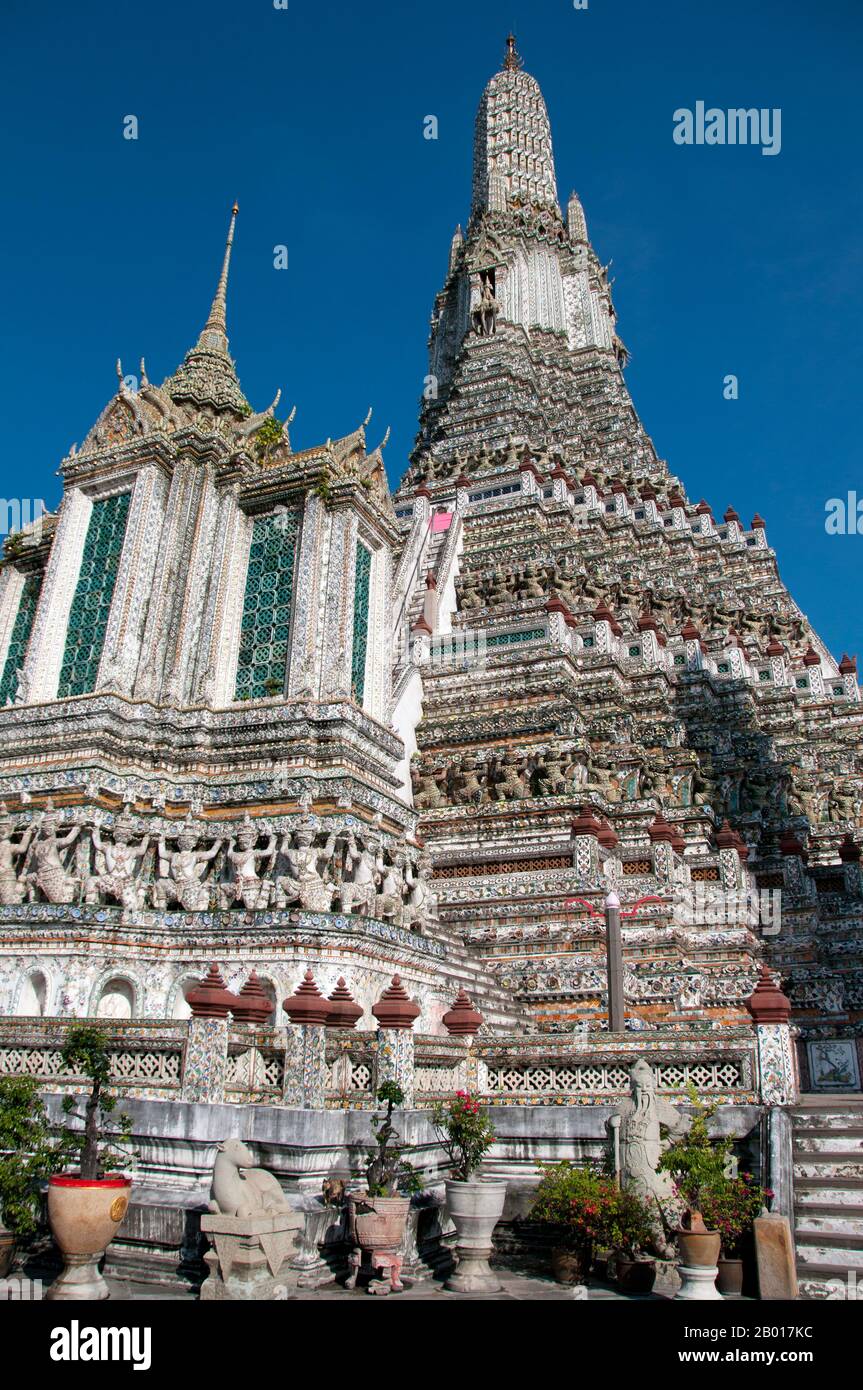 Thailand: The Khmer-style central prang at Wat Arun (Temple of Dawn), Bangkok. Wat Arun Rajwararam (Temple of the Dawn), full name Wat Arunratchawararam Ratchaworamahawihan, is a Thai Buddhist temple on the Thonburi west bank side of the Chao Phraya River in Bangkok. It is named after Aruna, the Indian God of Dawn. A monastery has stood here since the Ayutthayan period (1351 - 1767), but the temple's outstanding feature, the Khmer-style central prang, was not begun until 1809, during the reign of King Buddha Loetla Nabhalai (Rama II). Stock Photohttps://www.alamy.com/image-license-details/?v=1https://www.alamy.com/thailand-the-khmer-style-central-prang-at-wat-arun-temple-of-dawn-bangkok-wat-arun-rajwararam-temple-of-the-dawn-full-name-wat-arunratchawararam-ratchaworamahawihan-is-a-thai-buddhist-temple-on-the-thonburi-west-bank-side-of-the-chao-phraya-river-in-bangkok-it-is-named-after-aruna-the-indian-god-of-dawn-a-monastery-has-stood-here-since-the-ayutthayan-period-1351-1767-but-the-temples-outstanding-feature-the-khmer-style-central-prang-was-not-begun-until-1809-during-the-reign-of-king-buddha-loetla-nabhalai-rama-ii-image344235344.html
Thailand: The Khmer-style central prang at Wat Arun (Temple of Dawn), Bangkok. Wat Arun Rajwararam (Temple of the Dawn), full name Wat Arunratchawararam Ratchaworamahawihan, is a Thai Buddhist temple on the Thonburi west bank side of the Chao Phraya River in Bangkok. It is named after Aruna, the Indian God of Dawn. A monastery has stood here since the Ayutthayan period (1351 - 1767), but the temple's outstanding feature, the Khmer-style central prang, was not begun until 1809, during the reign of King Buddha Loetla Nabhalai (Rama II). Stock Photohttps://www.alamy.com/image-license-details/?v=1https://www.alamy.com/thailand-the-khmer-style-central-prang-at-wat-arun-temple-of-dawn-bangkok-wat-arun-rajwararam-temple-of-the-dawn-full-name-wat-arunratchawararam-ratchaworamahawihan-is-a-thai-buddhist-temple-on-the-thonburi-west-bank-side-of-the-chao-phraya-river-in-bangkok-it-is-named-after-aruna-the-indian-god-of-dawn-a-monastery-has-stood-here-since-the-ayutthayan-period-1351-1767-but-the-temples-outstanding-feature-the-khmer-style-central-prang-was-not-begun-until-1809-during-the-reign-of-king-buddha-loetla-nabhalai-rama-ii-image344235344.htmlRM2B017KC–Thailand: The Khmer-style central prang at Wat Arun (Temple of Dawn), Bangkok. Wat Arun Rajwararam (Temple of the Dawn), full name Wat Arunratchawararam Ratchaworamahawihan, is a Thai Buddhist temple on the Thonburi west bank side of the Chao Phraya River in Bangkok. It is named after Aruna, the Indian God of Dawn. A monastery has stood here since the Ayutthayan period (1351 - 1767), but the temple's outstanding feature, the Khmer-style central prang, was not begun until 1809, during the reign of King Buddha Loetla Nabhalai (Rama II).
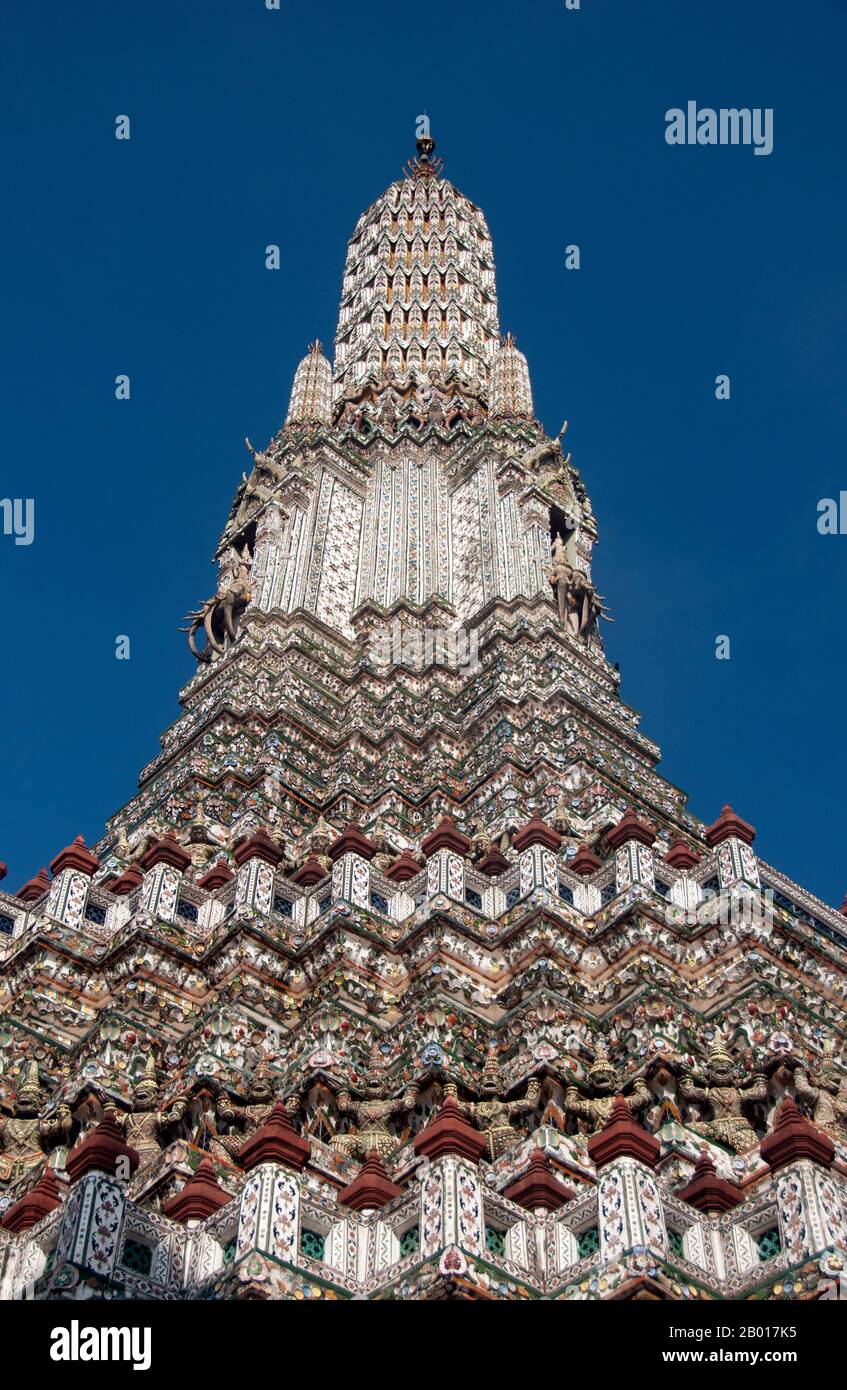 Thailand: The Khmer-style central prang at Wat Arun (Temple of Dawn), Bangkok. Wat Arun Rajwararam (Temple of the Dawn), full name Wat Arunratchawararam Ratchaworamahawihan, is a Thai Buddhist temple on the Thonburi west bank side of the Chao Phraya River in Bangkok. It is named after Aruna, the Indian God of Dawn. A monastery has stood here since the Ayutthayan period (1351 - 1767), but the temple's outstanding feature, the Khmer-style central prang, was not begun until 1809, during the reign of King Buddha Loetla Nabhalai (Rama II). Stock Photohttps://www.alamy.com/image-license-details/?v=1https://www.alamy.com/thailand-the-khmer-style-central-prang-at-wat-arun-temple-of-dawn-bangkok-wat-arun-rajwararam-temple-of-the-dawn-full-name-wat-arunratchawararam-ratchaworamahawihan-is-a-thai-buddhist-temple-on-the-thonburi-west-bank-side-of-the-chao-phraya-river-in-bangkok-it-is-named-after-aruna-the-indian-god-of-dawn-a-monastery-has-stood-here-since-the-ayutthayan-period-1351-1767-but-the-temples-outstanding-feature-the-khmer-style-central-prang-was-not-begun-until-1809-during-the-reign-of-king-buddha-loetla-nabhalai-rama-ii-image344235337.html
Thailand: The Khmer-style central prang at Wat Arun (Temple of Dawn), Bangkok. Wat Arun Rajwararam (Temple of the Dawn), full name Wat Arunratchawararam Ratchaworamahawihan, is a Thai Buddhist temple on the Thonburi west bank side of the Chao Phraya River in Bangkok. It is named after Aruna, the Indian God of Dawn. A monastery has stood here since the Ayutthayan period (1351 - 1767), but the temple's outstanding feature, the Khmer-style central prang, was not begun until 1809, during the reign of King Buddha Loetla Nabhalai (Rama II). Stock Photohttps://www.alamy.com/image-license-details/?v=1https://www.alamy.com/thailand-the-khmer-style-central-prang-at-wat-arun-temple-of-dawn-bangkok-wat-arun-rajwararam-temple-of-the-dawn-full-name-wat-arunratchawararam-ratchaworamahawihan-is-a-thai-buddhist-temple-on-the-thonburi-west-bank-side-of-the-chao-phraya-river-in-bangkok-it-is-named-after-aruna-the-indian-god-of-dawn-a-monastery-has-stood-here-since-the-ayutthayan-period-1351-1767-but-the-temples-outstanding-feature-the-khmer-style-central-prang-was-not-begun-until-1809-during-the-reign-of-king-buddha-loetla-nabhalai-rama-ii-image344235337.htmlRM2B017K5–Thailand: The Khmer-style central prang at Wat Arun (Temple of Dawn), Bangkok. Wat Arun Rajwararam (Temple of the Dawn), full name Wat Arunratchawararam Ratchaworamahawihan, is a Thai Buddhist temple on the Thonburi west bank side of the Chao Phraya River in Bangkok. It is named after Aruna, the Indian God of Dawn. A monastery has stood here since the Ayutthayan period (1351 - 1767), but the temple's outstanding feature, the Khmer-style central prang, was not begun until 1809, during the reign of King Buddha Loetla Nabhalai (Rama II).
 Thailand: The Khmer-style central prang at Wat Arun (Temple of Dawn), Bangkok. Wat Arun Rajwararam (Temple of the Dawn), full name Wat Arunratchawararam Ratchaworamahawihan, is a Thai Buddhist temple on the Thonburi west bank side of the Chao Phraya River in Bangkok. It is named after Aruna, the Indian God of Dawn. A monastery has stood here since the Ayutthayan period (1351 - 1767), but the temple's outstanding feature, the Khmer-style central prang, was not begun until 1809, during the reign of King Buddha Loetla Nabhalai (Rama II). Stock Photohttps://www.alamy.com/image-license-details/?v=1https://www.alamy.com/thailand-the-khmer-style-central-prang-at-wat-arun-temple-of-dawn-bangkok-wat-arun-rajwararam-temple-of-the-dawn-full-name-wat-arunratchawararam-ratchaworamahawihan-is-a-thai-buddhist-temple-on-the-thonburi-west-bank-side-of-the-chao-phraya-river-in-bangkok-it-is-named-after-aruna-the-indian-god-of-dawn-a-monastery-has-stood-here-since-the-ayutthayan-period-1351-1767-but-the-temples-outstanding-feature-the-khmer-style-central-prang-was-not-begun-until-1809-during-the-reign-of-king-buddha-loetla-nabhalai-rama-ii-image344235339.html
Thailand: The Khmer-style central prang at Wat Arun (Temple of Dawn), Bangkok. Wat Arun Rajwararam (Temple of the Dawn), full name Wat Arunratchawararam Ratchaworamahawihan, is a Thai Buddhist temple on the Thonburi west bank side of the Chao Phraya River in Bangkok. It is named after Aruna, the Indian God of Dawn. A monastery has stood here since the Ayutthayan period (1351 - 1767), but the temple's outstanding feature, the Khmer-style central prang, was not begun until 1809, during the reign of King Buddha Loetla Nabhalai (Rama II). Stock Photohttps://www.alamy.com/image-license-details/?v=1https://www.alamy.com/thailand-the-khmer-style-central-prang-at-wat-arun-temple-of-dawn-bangkok-wat-arun-rajwararam-temple-of-the-dawn-full-name-wat-arunratchawararam-ratchaworamahawihan-is-a-thai-buddhist-temple-on-the-thonburi-west-bank-side-of-the-chao-phraya-river-in-bangkok-it-is-named-after-aruna-the-indian-god-of-dawn-a-monastery-has-stood-here-since-the-ayutthayan-period-1351-1767-but-the-temples-outstanding-feature-the-khmer-style-central-prang-was-not-begun-until-1809-during-the-reign-of-king-buddha-loetla-nabhalai-rama-ii-image344235339.htmlRM2B017K7–Thailand: The Khmer-style central prang at Wat Arun (Temple of Dawn), Bangkok. Wat Arun Rajwararam (Temple of the Dawn), full name Wat Arunratchawararam Ratchaworamahawihan, is a Thai Buddhist temple on the Thonburi west bank side of the Chao Phraya River in Bangkok. It is named after Aruna, the Indian God of Dawn. A monastery has stood here since the Ayutthayan period (1351 - 1767), but the temple's outstanding feature, the Khmer-style central prang, was not begun until 1809, during the reign of King Buddha Loetla Nabhalai (Rama II).
 Thailand: Tourists at the Khmer-style central prang at Wat Arun (Temple of Dawn), Bangkok. Wat Arun Rajwararam (Temple of the Dawn), full name Wat Arunratchawararam Ratchaworamahawihan, is a Thai Buddhist temple on the Thonburi west bank side of the Chao Phraya River in Bangkok. It is named after Aruna, the Indian God of Dawn. A monastery has stood here since the Ayutthayan period (1351 - 1767), but the temple's outstanding feature, the Khmer-style central prang, was not begun until 1809, during the reign of King Buddha Loetla Nabhalai (Rama II). Stock Photohttps://www.alamy.com/image-license-details/?v=1https://www.alamy.com/thailand-tourists-at-the-khmer-style-central-prang-at-wat-arun-temple-of-dawn-bangkok-wat-arun-rajwararam-temple-of-the-dawn-full-name-wat-arunratchawararam-ratchaworamahawihan-is-a-thai-buddhist-temple-on-the-thonburi-west-bank-side-of-the-chao-phraya-river-in-bangkok-it-is-named-after-aruna-the-indian-god-of-dawn-a-monastery-has-stood-here-since-the-ayutthayan-period-1351-1767-but-the-temples-outstanding-feature-the-khmer-style-central-prang-was-not-begun-until-1809-during-the-reign-of-king-buddha-loetla-nabhalai-rama-ii-image344235347.html
Thailand: Tourists at the Khmer-style central prang at Wat Arun (Temple of Dawn), Bangkok. Wat Arun Rajwararam (Temple of the Dawn), full name Wat Arunratchawararam Ratchaworamahawihan, is a Thai Buddhist temple on the Thonburi west bank side of the Chao Phraya River in Bangkok. It is named after Aruna, the Indian God of Dawn. A monastery has stood here since the Ayutthayan period (1351 - 1767), but the temple's outstanding feature, the Khmer-style central prang, was not begun until 1809, during the reign of King Buddha Loetla Nabhalai (Rama II). Stock Photohttps://www.alamy.com/image-license-details/?v=1https://www.alamy.com/thailand-tourists-at-the-khmer-style-central-prang-at-wat-arun-temple-of-dawn-bangkok-wat-arun-rajwararam-temple-of-the-dawn-full-name-wat-arunratchawararam-ratchaworamahawihan-is-a-thai-buddhist-temple-on-the-thonburi-west-bank-side-of-the-chao-phraya-river-in-bangkok-it-is-named-after-aruna-the-indian-god-of-dawn-a-monastery-has-stood-here-since-the-ayutthayan-period-1351-1767-but-the-temples-outstanding-feature-the-khmer-style-central-prang-was-not-begun-until-1809-during-the-reign-of-king-buddha-loetla-nabhalai-rama-ii-image344235347.htmlRM2B017KF–Thailand: Tourists at the Khmer-style central prang at Wat Arun (Temple of Dawn), Bangkok. Wat Arun Rajwararam (Temple of the Dawn), full name Wat Arunratchawararam Ratchaworamahawihan, is a Thai Buddhist temple on the Thonburi west bank side of the Chao Phraya River in Bangkok. It is named after Aruna, the Indian God of Dawn. A monastery has stood here since the Ayutthayan period (1351 - 1767), but the temple's outstanding feature, the Khmer-style central prang, was not begun until 1809, during the reign of King Buddha Loetla Nabhalai (Rama II).
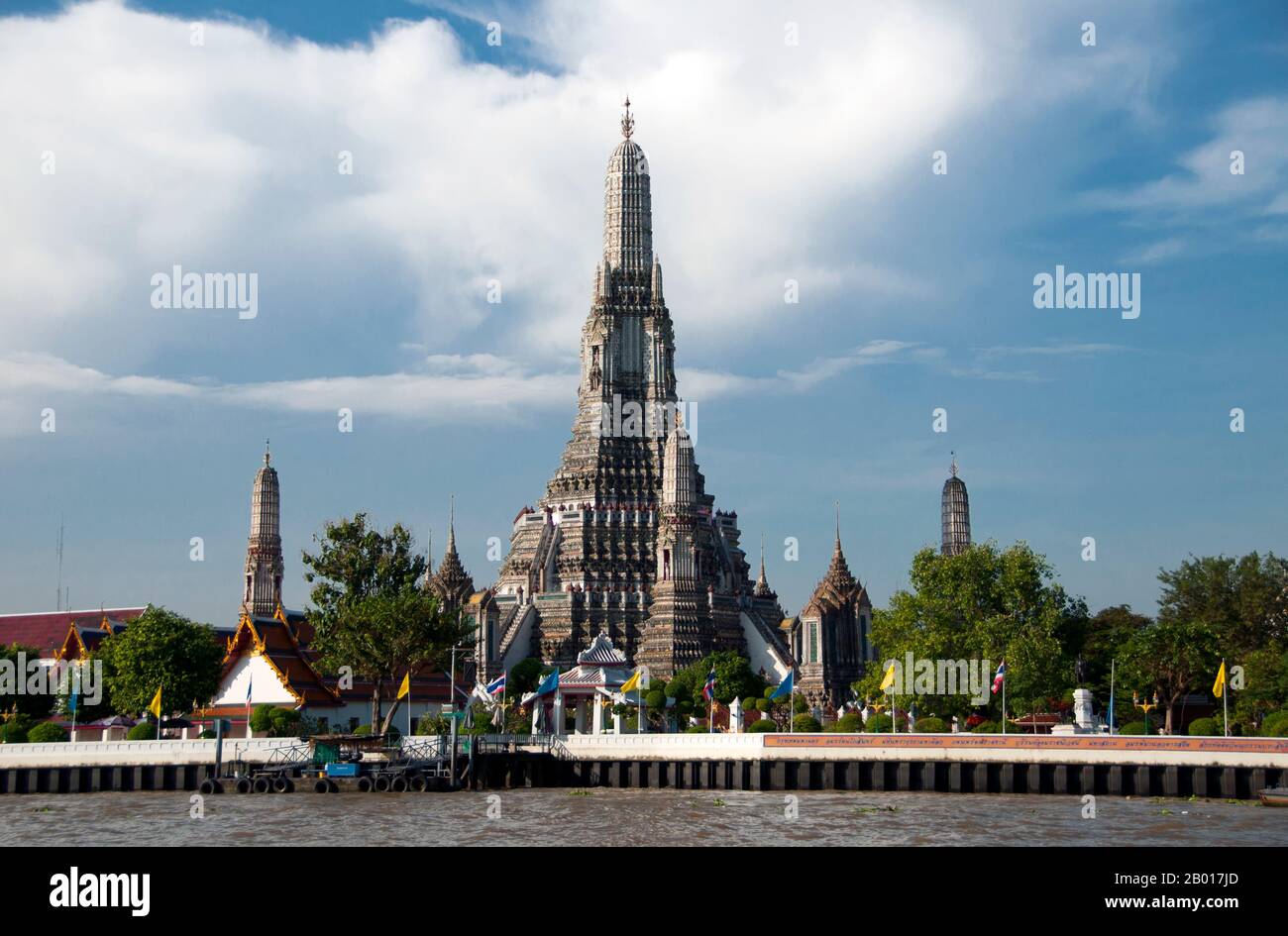 Thailand: Wat Arun (Temple of Dawn) from the Chao Phraya River, Bangkok. Wat Arun Rajwararam (Temple of the Dawn), full name Wat Arunratchawararam Ratchaworamahawihan, is a Thai Buddhist temple on the Thonburi west bank side of the Chao Phraya River in Bangkok. It is named after Aruna, the Indian God of Dawn. A monastery has stood here since the Ayutthayan period (1351 - 1767), but the temple's outstanding feature, the Khmer-style central prang, was not begun until 1809, during the reign of King Buddha Loetla Nabhalai (Rama II). Stock Photohttps://www.alamy.com/image-license-details/?v=1https://www.alamy.com/thailand-wat-arun-temple-of-dawn-from-the-chao-phraya-river-bangkok-wat-arun-rajwararam-temple-of-the-dawn-full-name-wat-arunratchawararam-ratchaworamahawihan-is-a-thai-buddhist-temple-on-the-thonburi-west-bank-side-of-the-chao-phraya-river-in-bangkok-it-is-named-after-aruna-the-indian-god-of-dawn-a-monastery-has-stood-here-since-the-ayutthayan-period-1351-1767-but-the-temples-outstanding-feature-the-khmer-style-central-prang-was-not-begun-until-1809-during-the-reign-of-king-buddha-loetla-nabhalai-rama-ii-image344235317.html
Thailand: Wat Arun (Temple of Dawn) from the Chao Phraya River, Bangkok. Wat Arun Rajwararam (Temple of the Dawn), full name Wat Arunratchawararam Ratchaworamahawihan, is a Thai Buddhist temple on the Thonburi west bank side of the Chao Phraya River in Bangkok. It is named after Aruna, the Indian God of Dawn. A monastery has stood here since the Ayutthayan period (1351 - 1767), but the temple's outstanding feature, the Khmer-style central prang, was not begun until 1809, during the reign of King Buddha Loetla Nabhalai (Rama II). Stock Photohttps://www.alamy.com/image-license-details/?v=1https://www.alamy.com/thailand-wat-arun-temple-of-dawn-from-the-chao-phraya-river-bangkok-wat-arun-rajwararam-temple-of-the-dawn-full-name-wat-arunratchawararam-ratchaworamahawihan-is-a-thai-buddhist-temple-on-the-thonburi-west-bank-side-of-the-chao-phraya-river-in-bangkok-it-is-named-after-aruna-the-indian-god-of-dawn-a-monastery-has-stood-here-since-the-ayutthayan-period-1351-1767-but-the-temples-outstanding-feature-the-khmer-style-central-prang-was-not-begun-until-1809-during-the-reign-of-king-buddha-loetla-nabhalai-rama-ii-image344235317.htmlRM2B017JD–Thailand: Wat Arun (Temple of Dawn) from the Chao Phraya River, Bangkok. Wat Arun Rajwararam (Temple of the Dawn), full name Wat Arunratchawararam Ratchaworamahawihan, is a Thai Buddhist temple on the Thonburi west bank side of the Chao Phraya River in Bangkok. It is named after Aruna, the Indian God of Dawn. A monastery has stood here since the Ayutthayan period (1351 - 1767), but the temple's outstanding feature, the Khmer-style central prang, was not begun until 1809, during the reign of King Buddha Loetla Nabhalai (Rama II).
 Thailand: Wat Arun (Temple of Dawn) from the Chao Phraya River, Bangkok. Wat Arun Rajwararam (Temple of the Dawn), full name Wat Arunratchawararam Ratchaworamahawihan, is a Thai Buddhist temple on the Thonburi west bank side of the Chao Phraya River in Bangkok. It is named after Aruna, the Indian God of Dawn. A monastery has stood here since the Ayutthayan period (1351 - 1767), but the temple's outstanding feature, the Khmer-style central prang, was not begun until 1809, during the reign of King Buddha Loetla Nabhalai (Rama II). Stock Photohttps://www.alamy.com/image-license-details/?v=1https://www.alamy.com/thailand-wat-arun-temple-of-dawn-from-the-chao-phraya-river-bangkok-wat-arun-rajwararam-temple-of-the-dawn-full-name-wat-arunratchawararam-ratchaworamahawihan-is-a-thai-buddhist-temple-on-the-thonburi-west-bank-side-of-the-chao-phraya-river-in-bangkok-it-is-named-after-aruna-the-indian-god-of-dawn-a-monastery-has-stood-here-since-the-ayutthayan-period-1351-1767-but-the-temples-outstanding-feature-the-khmer-style-central-prang-was-not-begun-until-1809-during-the-reign-of-king-buddha-loetla-nabhalai-rama-ii-image344235313.html
Thailand: Wat Arun (Temple of Dawn) from the Chao Phraya River, Bangkok. Wat Arun Rajwararam (Temple of the Dawn), full name Wat Arunratchawararam Ratchaworamahawihan, is a Thai Buddhist temple on the Thonburi west bank side of the Chao Phraya River in Bangkok. It is named after Aruna, the Indian God of Dawn. A monastery has stood here since the Ayutthayan period (1351 - 1767), but the temple's outstanding feature, the Khmer-style central prang, was not begun until 1809, during the reign of King Buddha Loetla Nabhalai (Rama II). Stock Photohttps://www.alamy.com/image-license-details/?v=1https://www.alamy.com/thailand-wat-arun-temple-of-dawn-from-the-chao-phraya-river-bangkok-wat-arun-rajwararam-temple-of-the-dawn-full-name-wat-arunratchawararam-ratchaworamahawihan-is-a-thai-buddhist-temple-on-the-thonburi-west-bank-side-of-the-chao-phraya-river-in-bangkok-it-is-named-after-aruna-the-indian-god-of-dawn-a-monastery-has-stood-here-since-the-ayutthayan-period-1351-1767-but-the-temples-outstanding-feature-the-khmer-style-central-prang-was-not-begun-until-1809-during-the-reign-of-king-buddha-loetla-nabhalai-rama-ii-image344235313.htmlRM2B017J9–Thailand: Wat Arun (Temple of Dawn) from the Chao Phraya River, Bangkok. Wat Arun Rajwararam (Temple of the Dawn), full name Wat Arunratchawararam Ratchaworamahawihan, is a Thai Buddhist temple on the Thonburi west bank side of the Chao Phraya River in Bangkok. It is named after Aruna, the Indian God of Dawn. A monastery has stood here since the Ayutthayan period (1351 - 1767), but the temple's outstanding feature, the Khmer-style central prang, was not begun until 1809, during the reign of King Buddha Loetla Nabhalai (Rama II).
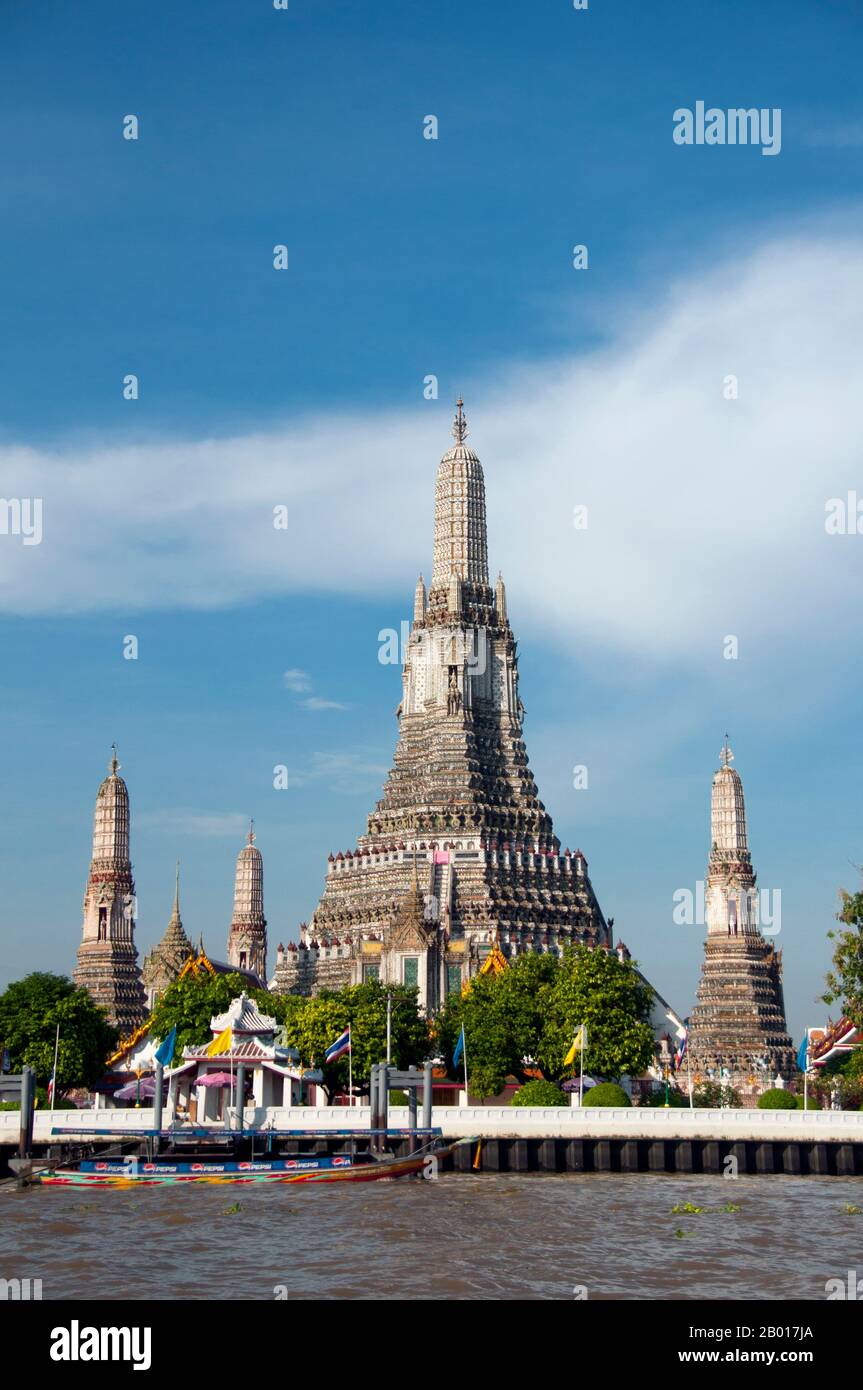 Thailand: Wat Arun (Temple of Dawn) from the Chao Phraya River, Bangkok. Wat Arun Rajwararam (Temple of the Dawn), full name Wat Arunratchawararam Ratchaworamahawihan, is a Thai Buddhist temple on the Thonburi west bank side of the Chao Phraya River in Bangkok. It is named after Aruna, the Indian God of Dawn. A monastery has stood here since the Ayutthayan period (1351 - 1767), but the temple's outstanding feature, the Khmer-style central prang, was not begun until 1809, during the reign of King Buddha Loetla Nabhalai (Rama II). Stock Photohttps://www.alamy.com/image-license-details/?v=1https://www.alamy.com/thailand-wat-arun-temple-of-dawn-from-the-chao-phraya-river-bangkok-wat-arun-rajwararam-temple-of-the-dawn-full-name-wat-arunratchawararam-ratchaworamahawihan-is-a-thai-buddhist-temple-on-the-thonburi-west-bank-side-of-the-chao-phraya-river-in-bangkok-it-is-named-after-aruna-the-indian-god-of-dawn-a-monastery-has-stood-here-since-the-ayutthayan-period-1351-1767-but-the-temples-outstanding-feature-the-khmer-style-central-prang-was-not-begun-until-1809-during-the-reign-of-king-buddha-loetla-nabhalai-rama-ii-image344235314.html
Thailand: Wat Arun (Temple of Dawn) from the Chao Phraya River, Bangkok. Wat Arun Rajwararam (Temple of the Dawn), full name Wat Arunratchawararam Ratchaworamahawihan, is a Thai Buddhist temple on the Thonburi west bank side of the Chao Phraya River in Bangkok. It is named after Aruna, the Indian God of Dawn. A monastery has stood here since the Ayutthayan period (1351 - 1767), but the temple's outstanding feature, the Khmer-style central prang, was not begun until 1809, during the reign of King Buddha Loetla Nabhalai (Rama II). Stock Photohttps://www.alamy.com/image-license-details/?v=1https://www.alamy.com/thailand-wat-arun-temple-of-dawn-from-the-chao-phraya-river-bangkok-wat-arun-rajwararam-temple-of-the-dawn-full-name-wat-arunratchawararam-ratchaworamahawihan-is-a-thai-buddhist-temple-on-the-thonburi-west-bank-side-of-the-chao-phraya-river-in-bangkok-it-is-named-after-aruna-the-indian-god-of-dawn-a-monastery-has-stood-here-since-the-ayutthayan-period-1351-1767-but-the-temples-outstanding-feature-the-khmer-style-central-prang-was-not-begun-until-1809-during-the-reign-of-king-buddha-loetla-nabhalai-rama-ii-image344235314.htmlRM2B017JA–Thailand: Wat Arun (Temple of Dawn) from the Chao Phraya River, Bangkok. Wat Arun Rajwararam (Temple of the Dawn), full name Wat Arunratchawararam Ratchaworamahawihan, is a Thai Buddhist temple on the Thonburi west bank side of the Chao Phraya River in Bangkok. It is named after Aruna, the Indian God of Dawn. A monastery has stood here since the Ayutthayan period (1351 - 1767), but the temple's outstanding feature, the Khmer-style central prang, was not begun until 1809, during the reign of King Buddha Loetla Nabhalai (Rama II).
 Thailand: The Khmer-style central prang at Wat Arun (Temple of Dawn), Bangkok. Wat Arun Rajwararam (Temple of the Dawn), full name Wat Arunratchawararam Ratchaworamahawihan, is a Thai Buddhist temple on the Thonburi west bank side of the Chao Phraya River in Bangkok. It is named after Aruna, the Indian God of Dawn. A monastery has stood here since the Ayutthayan period (1351 - 1767), but the temple's outstanding feature, the Khmer-style central prang, was not begun until 1809, during the reign of King Buddha Loetla Nabhalai (Rama II). Stock Photohttps://www.alamy.com/image-license-details/?v=1https://www.alamy.com/thailand-the-khmer-style-central-prang-at-wat-arun-temple-of-dawn-bangkok-wat-arun-rajwararam-temple-of-the-dawn-full-name-wat-arunratchawararam-ratchaworamahawihan-is-a-thai-buddhist-temple-on-the-thonburi-west-bank-side-of-the-chao-phraya-river-in-bangkok-it-is-named-after-aruna-the-indian-god-of-dawn-a-monastery-has-stood-here-since-the-ayutthayan-period-1351-1767-but-the-temples-outstanding-feature-the-khmer-style-central-prang-was-not-begun-until-1809-during-the-reign-of-king-buddha-loetla-nabhalai-rama-ii-image344235336.html
Thailand: The Khmer-style central prang at Wat Arun (Temple of Dawn), Bangkok. Wat Arun Rajwararam (Temple of the Dawn), full name Wat Arunratchawararam Ratchaworamahawihan, is a Thai Buddhist temple on the Thonburi west bank side of the Chao Phraya River in Bangkok. It is named after Aruna, the Indian God of Dawn. A monastery has stood here since the Ayutthayan period (1351 - 1767), but the temple's outstanding feature, the Khmer-style central prang, was not begun until 1809, during the reign of King Buddha Loetla Nabhalai (Rama II). Stock Photohttps://www.alamy.com/image-license-details/?v=1https://www.alamy.com/thailand-the-khmer-style-central-prang-at-wat-arun-temple-of-dawn-bangkok-wat-arun-rajwararam-temple-of-the-dawn-full-name-wat-arunratchawararam-ratchaworamahawihan-is-a-thai-buddhist-temple-on-the-thonburi-west-bank-side-of-the-chao-phraya-river-in-bangkok-it-is-named-after-aruna-the-indian-god-of-dawn-a-monastery-has-stood-here-since-the-ayutthayan-period-1351-1767-but-the-temples-outstanding-feature-the-khmer-style-central-prang-was-not-begun-until-1809-during-the-reign-of-king-buddha-loetla-nabhalai-rama-ii-image344235336.htmlRM2B017K4–Thailand: The Khmer-style central prang at Wat Arun (Temple of Dawn), Bangkok. Wat Arun Rajwararam (Temple of the Dawn), full name Wat Arunratchawararam Ratchaworamahawihan, is a Thai Buddhist temple on the Thonburi west bank side of the Chao Phraya River in Bangkok. It is named after Aruna, the Indian God of Dawn. A monastery has stood here since the Ayutthayan period (1351 - 1767), but the temple's outstanding feature, the Khmer-style central prang, was not begun until 1809, during the reign of King Buddha Loetla Nabhalai (Rama II).
 Thailand: The main viharn containing the Phra Sri Sakyamuni Buddha image, Wat Suthat, Bangkok. Wat Suthat Thepphawararam is a royal temple of the first grade, one of six such temples in Thailand. Construction was begun by King Buddha Yodfa Chulaloke (Rama I) in 1807. Further construction and decorations were carried out by King Buddha Loetla Nabhalai (Rama II) who helped carve the wooden doors, but the temple was not completed until the reign of King Jessadabodindra (Rama III) in 1847. The temple is a fine example of the Rattanakosin architectural style. Stock Photohttps://www.alamy.com/image-license-details/?v=1https://www.alamy.com/thailand-the-main-viharn-containing-the-phra-sri-sakyamuni-buddha-image-wat-suthat-bangkok-wat-suthat-thepphawararam-is-a-royal-temple-of-the-first-grade-one-of-six-such-temples-in-thailand-construction-was-begun-by-king-buddha-yodfa-chulaloke-rama-i-in-1807-further-construction-and-decorations-were-carried-out-by-king-buddha-loetla-nabhalai-rama-ii-who-helped-carve-the-wooden-doors-but-the-temple-was-not-completed-until-the-reign-of-king-jessadabodindra-rama-iii-in-1847-the-temple-is-a-fine-example-of-the-rattanakosin-architectural-style-image344235036.html
Thailand: The main viharn containing the Phra Sri Sakyamuni Buddha image, Wat Suthat, Bangkok. Wat Suthat Thepphawararam is a royal temple of the first grade, one of six such temples in Thailand. Construction was begun by King Buddha Yodfa Chulaloke (Rama I) in 1807. Further construction and decorations were carried out by King Buddha Loetla Nabhalai (Rama II) who helped carve the wooden doors, but the temple was not completed until the reign of King Jessadabodindra (Rama III) in 1847. The temple is a fine example of the Rattanakosin architectural style. Stock Photohttps://www.alamy.com/image-license-details/?v=1https://www.alamy.com/thailand-the-main-viharn-containing-the-phra-sri-sakyamuni-buddha-image-wat-suthat-bangkok-wat-suthat-thepphawararam-is-a-royal-temple-of-the-first-grade-one-of-six-such-temples-in-thailand-construction-was-begun-by-king-buddha-yodfa-chulaloke-rama-i-in-1807-further-construction-and-decorations-were-carried-out-by-king-buddha-loetla-nabhalai-rama-ii-who-helped-carve-the-wooden-doors-but-the-temple-was-not-completed-until-the-reign-of-king-jessadabodindra-rama-iii-in-1847-the-temple-is-a-fine-example-of-the-rattanakosin-architectural-style-image344235036.htmlRM2B0178C–Thailand: The main viharn containing the Phra Sri Sakyamuni Buddha image, Wat Suthat, Bangkok. Wat Suthat Thepphawararam is a royal temple of the first grade, one of six such temples in Thailand. Construction was begun by King Buddha Yodfa Chulaloke (Rama I) in 1807. Further construction and decorations were carried out by King Buddha Loetla Nabhalai (Rama II) who helped carve the wooden doors, but the temple was not completed until the reign of King Jessadabodindra (Rama III) in 1847. The temple is a fine example of the Rattanakosin architectural style.
 Thailand: The main viharn containing the Phra Sri Sakyamuni Buddha image, Wat Suthat, Bangkok. Wat Suthat Thepphawararam is a royal temple of the first grade, one of six such temples in Thailand. Construction was begun by King Buddha Yodfa Chulaloke (Rama I) in 1807. Further construction and decorations were carried out by King Buddha Loetla Nabhalai (Rama II) who helped carve the wooden doors, but the temple was not completed until the reign of King Jessadabodindra (Rama III) in 1847. The temple is a fine example of the Rattanakosin architectural style. Stock Photohttps://www.alamy.com/image-license-details/?v=1https://www.alamy.com/thailand-the-main-viharn-containing-the-phra-sri-sakyamuni-buddha-image-wat-suthat-bangkok-wat-suthat-thepphawararam-is-a-royal-temple-of-the-first-grade-one-of-six-such-temples-in-thailand-construction-was-begun-by-king-buddha-yodfa-chulaloke-rama-i-in-1807-further-construction-and-decorations-were-carried-out-by-king-buddha-loetla-nabhalai-rama-ii-who-helped-carve-the-wooden-doors-but-the-temple-was-not-completed-until-the-reign-of-king-jessadabodindra-rama-iii-in-1847-the-temple-is-a-fine-example-of-the-rattanakosin-architectural-style-image344235035.html
Thailand: The main viharn containing the Phra Sri Sakyamuni Buddha image, Wat Suthat, Bangkok. Wat Suthat Thepphawararam is a royal temple of the first grade, one of six such temples in Thailand. Construction was begun by King Buddha Yodfa Chulaloke (Rama I) in 1807. Further construction and decorations were carried out by King Buddha Loetla Nabhalai (Rama II) who helped carve the wooden doors, but the temple was not completed until the reign of King Jessadabodindra (Rama III) in 1847. The temple is a fine example of the Rattanakosin architectural style. Stock Photohttps://www.alamy.com/image-license-details/?v=1https://www.alamy.com/thailand-the-main-viharn-containing-the-phra-sri-sakyamuni-buddha-image-wat-suthat-bangkok-wat-suthat-thepphawararam-is-a-royal-temple-of-the-first-grade-one-of-six-such-temples-in-thailand-construction-was-begun-by-king-buddha-yodfa-chulaloke-rama-i-in-1807-further-construction-and-decorations-were-carried-out-by-king-buddha-loetla-nabhalai-rama-ii-who-helped-carve-the-wooden-doors-but-the-temple-was-not-completed-until-the-reign-of-king-jessadabodindra-rama-iii-in-1847-the-temple-is-a-fine-example-of-the-rattanakosin-architectural-style-image344235035.htmlRM2B0178B–Thailand: The main viharn containing the Phra Sri Sakyamuni Buddha image, Wat Suthat, Bangkok. Wat Suthat Thepphawararam is a royal temple of the first grade, one of six such temples in Thailand. Construction was begun by King Buddha Yodfa Chulaloke (Rama I) in 1807. Further construction and decorations were carried out by King Buddha Loetla Nabhalai (Rama II) who helped carve the wooden doors, but the temple was not completed until the reign of King Jessadabodindra (Rama III) in 1847. The temple is a fine example of the Rattanakosin architectural style.
 Thailand: Statuary and Chinese pagoda in front of the main viharn, Wat Suthat, Bangkok. Wat Suthat Thepphawararam is a royal temple of the first grade, one of six such temples in Thailand. Construction was begun by King Buddha Yodfa Chulaloke (Rama I) in 1807. Further construction and decorations were carried out by King Buddha Loetla Nabhalai (Rama II) who helped carve the wooden doors, but the temple was not completed until the reign of King Jessadabodindra (Rama III) in 1847. The temple is a fine example of the Rattanakosin architectural style. Stock Photohttps://www.alamy.com/image-license-details/?v=1https://www.alamy.com/thailand-statuary-and-chinese-pagoda-in-front-of-the-main-viharn-wat-suthat-bangkok-wat-suthat-thepphawararam-is-a-royal-temple-of-the-first-grade-one-of-six-such-temples-in-thailand-construction-was-begun-by-king-buddha-yodfa-chulaloke-rama-i-in-1807-further-construction-and-decorations-were-carried-out-by-king-buddha-loetla-nabhalai-rama-ii-who-helped-carve-the-wooden-doors-but-the-temple-was-not-completed-until-the-reign-of-king-jessadabodindra-rama-iii-in-1847-the-temple-is-a-fine-example-of-the-rattanakosin-architectural-style-image344235040.html
Thailand: Statuary and Chinese pagoda in front of the main viharn, Wat Suthat, Bangkok. Wat Suthat Thepphawararam is a royal temple of the first grade, one of six such temples in Thailand. Construction was begun by King Buddha Yodfa Chulaloke (Rama I) in 1807. Further construction and decorations were carried out by King Buddha Loetla Nabhalai (Rama II) who helped carve the wooden doors, but the temple was not completed until the reign of King Jessadabodindra (Rama III) in 1847. The temple is a fine example of the Rattanakosin architectural style. Stock Photohttps://www.alamy.com/image-license-details/?v=1https://www.alamy.com/thailand-statuary-and-chinese-pagoda-in-front-of-the-main-viharn-wat-suthat-bangkok-wat-suthat-thepphawararam-is-a-royal-temple-of-the-first-grade-one-of-six-such-temples-in-thailand-construction-was-begun-by-king-buddha-yodfa-chulaloke-rama-i-in-1807-further-construction-and-decorations-were-carried-out-by-king-buddha-loetla-nabhalai-rama-ii-who-helped-carve-the-wooden-doors-but-the-temple-was-not-completed-until-the-reign-of-king-jessadabodindra-rama-iii-in-1847-the-temple-is-a-fine-example-of-the-rattanakosin-architectural-style-image344235040.htmlRM2B0178G–Thailand: Statuary and Chinese pagoda in front of the main viharn, Wat Suthat, Bangkok. Wat Suthat Thepphawararam is a royal temple of the first grade, one of six such temples in Thailand. Construction was begun by King Buddha Yodfa Chulaloke (Rama I) in 1807. Further construction and decorations were carried out by King Buddha Loetla Nabhalai (Rama II) who helped carve the wooden doors, but the temple was not completed until the reign of King Jessadabodindra (Rama III) in 1847. The temple is a fine example of the Rattanakosin architectural style.
 Thailand: Chinese figure in the main temple complex, Wat Arun (Temple of Dawn), Bangkok. Wat Arun Rajwararam (Temple of the Dawn), full name Wat Arunratchawararam Ratchaworamahawihan, is a Thai Buddhist temple on the Thonburi west bank side of the Chao Phraya River in Bangkok. It is named after Aruna, the Indian God of Dawn. A monastery has stood here since the Ayutthayan period (1351 - 1767), but the temple's outstanding feature, the Khmer-style central prang, was not begun until 1809, during the reign of King Buddha Loetla Nabhalai (Rama II). Stock Photohttps://www.alamy.com/image-license-details/?v=1https://www.alamy.com/thailand-chinese-figure-in-the-main-temple-complex-wat-arun-temple-of-dawn-bangkok-wat-arun-rajwararam-temple-of-the-dawn-full-name-wat-arunratchawararam-ratchaworamahawihan-is-a-thai-buddhist-temple-on-the-thonburi-west-bank-side-of-the-chao-phraya-river-in-bangkok-it-is-named-after-aruna-the-indian-god-of-dawn-a-monastery-has-stood-here-since-the-ayutthayan-period-1351-1767-but-the-temples-outstanding-feature-the-khmer-style-central-prang-was-not-begun-until-1809-during-the-reign-of-king-buddha-loetla-nabhalai-rama-ii-image344235322.html
Thailand: Chinese figure in the main temple complex, Wat Arun (Temple of Dawn), Bangkok. Wat Arun Rajwararam (Temple of the Dawn), full name Wat Arunratchawararam Ratchaworamahawihan, is a Thai Buddhist temple on the Thonburi west bank side of the Chao Phraya River in Bangkok. It is named after Aruna, the Indian God of Dawn. A monastery has stood here since the Ayutthayan period (1351 - 1767), but the temple's outstanding feature, the Khmer-style central prang, was not begun until 1809, during the reign of King Buddha Loetla Nabhalai (Rama II). Stock Photohttps://www.alamy.com/image-license-details/?v=1https://www.alamy.com/thailand-chinese-figure-in-the-main-temple-complex-wat-arun-temple-of-dawn-bangkok-wat-arun-rajwararam-temple-of-the-dawn-full-name-wat-arunratchawararam-ratchaworamahawihan-is-a-thai-buddhist-temple-on-the-thonburi-west-bank-side-of-the-chao-phraya-river-in-bangkok-it-is-named-after-aruna-the-indian-god-of-dawn-a-monastery-has-stood-here-since-the-ayutthayan-period-1351-1767-but-the-temples-outstanding-feature-the-khmer-style-central-prang-was-not-begun-until-1809-during-the-reign-of-king-buddha-loetla-nabhalai-rama-ii-image344235322.htmlRM2B017JJ–Thailand: Chinese figure in the main temple complex, Wat Arun (Temple of Dawn), Bangkok. Wat Arun Rajwararam (Temple of the Dawn), full name Wat Arunratchawararam Ratchaworamahawihan, is a Thai Buddhist temple on the Thonburi west bank side of the Chao Phraya River in Bangkok. It is named after Aruna, the Indian God of Dawn. A monastery has stood here since the Ayutthayan period (1351 - 1767), but the temple's outstanding feature, the Khmer-style central prang, was not begun until 1809, during the reign of King Buddha Loetla Nabhalai (Rama II).
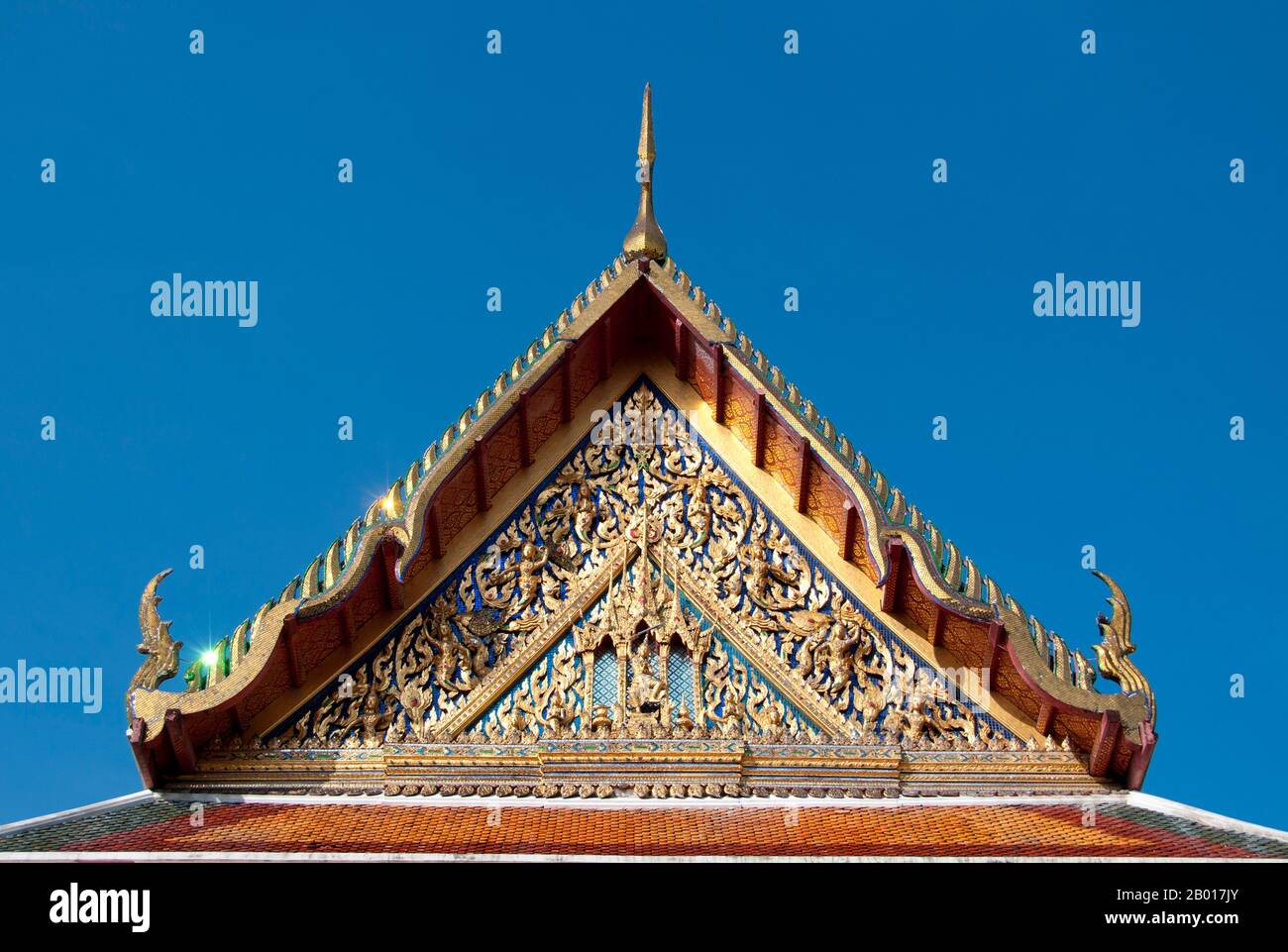 Thailand: The main gable of the Ubosot (Bot) or ordination hall at Wat Arun (Temple of Dawn), Bangkok. Wat Arun Rajwararam (Temple of the Dawn), full name Wat Arunratchawararam Ratchaworamahawihan, is a Thai Buddhist temple on the Thonburi west bank side of the Chao Phraya River in Bangkok. It is named after Aruna, the Indian God of Dawn. A monastery has stood here since the Ayutthayan period (1351 - 1767), but the temple's outstanding feature, the Khmer-style central prang, was not begun until 1809, during the reign of King Buddha Loetla Nabhalai (Rama II). Stock Photohttps://www.alamy.com/image-license-details/?v=1https://www.alamy.com/thailand-the-main-gable-of-the-ubosot-bot-or-ordination-hall-at-wat-arun-temple-of-dawn-bangkok-wat-arun-rajwararam-temple-of-the-dawn-full-name-wat-arunratchawararam-ratchaworamahawihan-is-a-thai-buddhist-temple-on-the-thonburi-west-bank-side-of-the-chao-phraya-river-in-bangkok-it-is-named-after-aruna-the-indian-god-of-dawn-a-monastery-has-stood-here-since-the-ayutthayan-period-1351-1767-but-the-temples-outstanding-feature-the-khmer-style-central-prang-was-not-begun-until-1809-during-the-reign-of-king-buddha-loetla-nabhalai-rama-ii-image344235331.html
Thailand: The main gable of the Ubosot (Bot) or ordination hall at Wat Arun (Temple of Dawn), Bangkok. Wat Arun Rajwararam (Temple of the Dawn), full name Wat Arunratchawararam Ratchaworamahawihan, is a Thai Buddhist temple on the Thonburi west bank side of the Chao Phraya River in Bangkok. It is named after Aruna, the Indian God of Dawn. A monastery has stood here since the Ayutthayan period (1351 - 1767), but the temple's outstanding feature, the Khmer-style central prang, was not begun until 1809, during the reign of King Buddha Loetla Nabhalai (Rama II). Stock Photohttps://www.alamy.com/image-license-details/?v=1https://www.alamy.com/thailand-the-main-gable-of-the-ubosot-bot-or-ordination-hall-at-wat-arun-temple-of-dawn-bangkok-wat-arun-rajwararam-temple-of-the-dawn-full-name-wat-arunratchawararam-ratchaworamahawihan-is-a-thai-buddhist-temple-on-the-thonburi-west-bank-side-of-the-chao-phraya-river-in-bangkok-it-is-named-after-aruna-the-indian-god-of-dawn-a-monastery-has-stood-here-since-the-ayutthayan-period-1351-1767-but-the-temples-outstanding-feature-the-khmer-style-central-prang-was-not-begun-until-1809-during-the-reign-of-king-buddha-loetla-nabhalai-rama-ii-image344235331.htmlRM2B017JY–Thailand: The main gable of the Ubosot (Bot) or ordination hall at Wat Arun (Temple of Dawn), Bangkok. Wat Arun Rajwararam (Temple of the Dawn), full name Wat Arunratchawararam Ratchaworamahawihan, is a Thai Buddhist temple on the Thonburi west bank side of the Chao Phraya River in Bangkok. It is named after Aruna, the Indian God of Dawn. A monastery has stood here since the Ayutthayan period (1351 - 1767), but the temple's outstanding feature, the Khmer-style central prang, was not begun until 1809, during the reign of King Buddha Loetla Nabhalai (Rama II).
 Thailand: Chinese figure in the main temple complex, Wat Arun (Temple of Dawn), Bangkok. Wat Arun Rajwararam (Temple of the Dawn), full name Wat Arunratchawararam Ratchaworamahawihan, is a Thai Buddhist temple on the Thonburi west bank side of the Chao Phraya River in Bangkok. It is named after Aruna, the Indian God of Dawn. A monastery has stood here since the Ayutthayan period (1351 - 1767), but the temple's outstanding feature, the Khmer-style central prang, was not begun until 1809, during the reign of King Buddha Loetla Nabhalai (Rama II). Stock Photohttps://www.alamy.com/image-license-details/?v=1https://www.alamy.com/thailand-chinese-figure-in-the-main-temple-complex-wat-arun-temple-of-dawn-bangkok-wat-arun-rajwararam-temple-of-the-dawn-full-name-wat-arunratchawararam-ratchaworamahawihan-is-a-thai-buddhist-temple-on-the-thonburi-west-bank-side-of-the-chao-phraya-river-in-bangkok-it-is-named-after-aruna-the-indian-god-of-dawn-a-monastery-has-stood-here-since-the-ayutthayan-period-1351-1767-but-the-temples-outstanding-feature-the-khmer-style-central-prang-was-not-begun-until-1809-during-the-reign-of-king-buddha-loetla-nabhalai-rama-ii-image344235327.html
Thailand: Chinese figure in the main temple complex, Wat Arun (Temple of Dawn), Bangkok. Wat Arun Rajwararam (Temple of the Dawn), full name Wat Arunratchawararam Ratchaworamahawihan, is a Thai Buddhist temple on the Thonburi west bank side of the Chao Phraya River in Bangkok. It is named after Aruna, the Indian God of Dawn. A monastery has stood here since the Ayutthayan period (1351 - 1767), but the temple's outstanding feature, the Khmer-style central prang, was not begun until 1809, during the reign of King Buddha Loetla Nabhalai (Rama II). Stock Photohttps://www.alamy.com/image-license-details/?v=1https://www.alamy.com/thailand-chinese-figure-in-the-main-temple-complex-wat-arun-temple-of-dawn-bangkok-wat-arun-rajwararam-temple-of-the-dawn-full-name-wat-arunratchawararam-ratchaworamahawihan-is-a-thai-buddhist-temple-on-the-thonburi-west-bank-side-of-the-chao-phraya-river-in-bangkok-it-is-named-after-aruna-the-indian-god-of-dawn-a-monastery-has-stood-here-since-the-ayutthayan-period-1351-1767-but-the-temples-outstanding-feature-the-khmer-style-central-prang-was-not-begun-until-1809-during-the-reign-of-king-buddha-loetla-nabhalai-rama-ii-image344235327.htmlRM2B017JR–Thailand: Chinese figure in the main temple complex, Wat Arun (Temple of Dawn), Bangkok. Wat Arun Rajwararam (Temple of the Dawn), full name Wat Arunratchawararam Ratchaworamahawihan, is a Thai Buddhist temple on the Thonburi west bank side of the Chao Phraya River in Bangkok. It is named after Aruna, the Indian God of Dawn. A monastery has stood here since the Ayutthayan period (1351 - 1767), but the temple's outstanding feature, the Khmer-style central prang, was not begun until 1809, during the reign of King Buddha Loetla Nabhalai (Rama II).
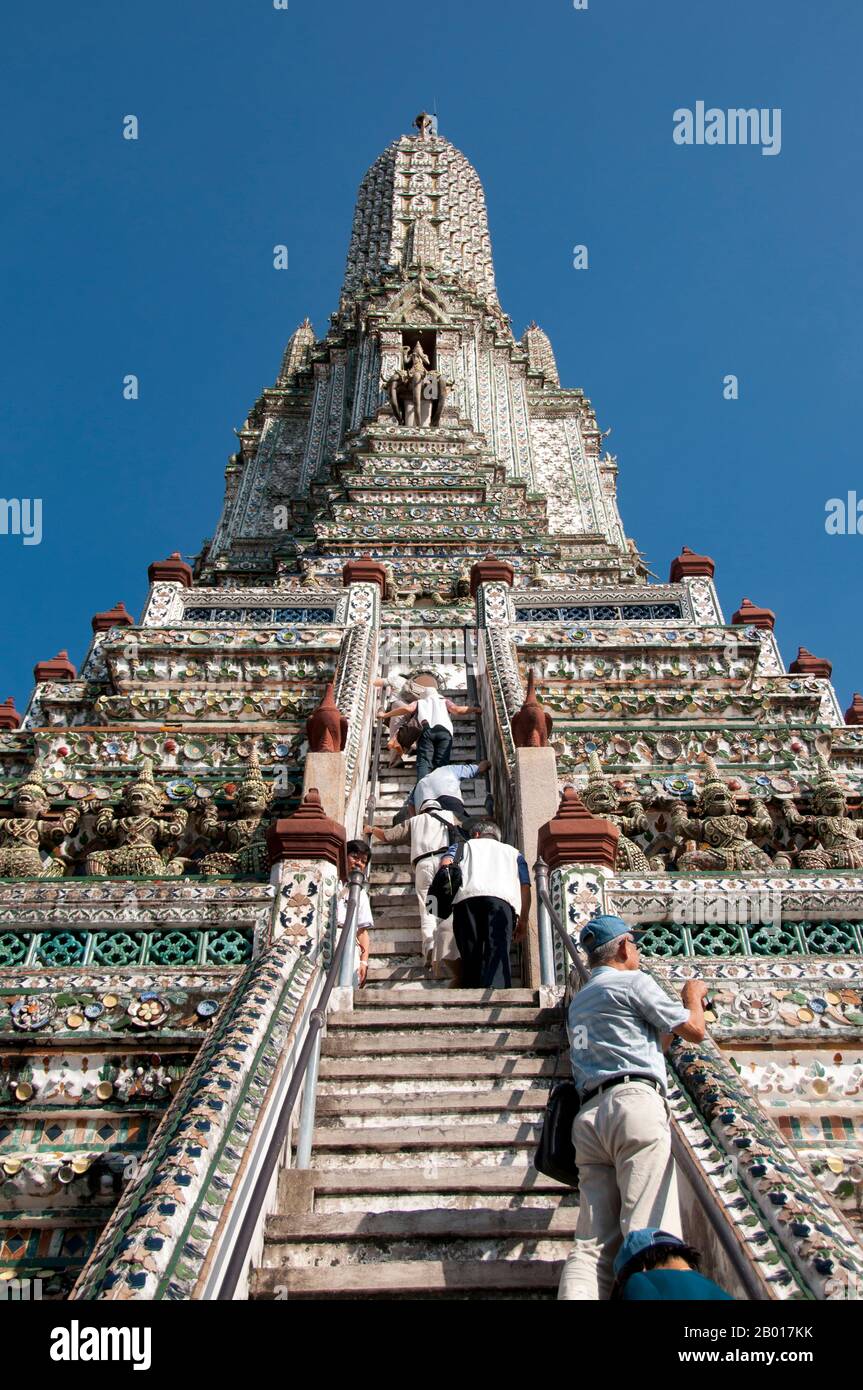 Thailand: Visitors climb the Khmer-style central prang at Wat Arun (Temple of Dawn), Bangkok. Wat Arun Rajwararam (Temple of the Dawn), full name Wat Arunratchawararam Ratchaworamahawihan, is a Thai Buddhist temple on the Thonburi west bank side of the Chao Phraya River in Bangkok. It is named after Aruna, the Indian God of Dawn. A monastery has stood here since the Ayutthayan period (1351 - 1767), but the temple's outstanding feature, the Khmer-style central prang, was not begun until 1809, during the reign of King Buddha Loetla Nabhalai (Rama II). Stock Photohttps://www.alamy.com/image-license-details/?v=1https://www.alamy.com/thailand-visitors-climb-the-khmer-style-central-prang-at-wat-arun-temple-of-dawn-bangkok-wat-arun-rajwararam-temple-of-the-dawn-full-name-wat-arunratchawararam-ratchaworamahawihan-is-a-thai-buddhist-temple-on-the-thonburi-west-bank-side-of-the-chao-phraya-river-in-bangkok-it-is-named-after-aruna-the-indian-god-of-dawn-a-monastery-has-stood-here-since-the-ayutthayan-period-1351-1767-but-the-temples-outstanding-feature-the-khmer-style-central-prang-was-not-begun-until-1809-during-the-reign-of-king-buddha-loetla-nabhalai-rama-ii-image344235351.html
Thailand: Visitors climb the Khmer-style central prang at Wat Arun (Temple of Dawn), Bangkok. Wat Arun Rajwararam (Temple of the Dawn), full name Wat Arunratchawararam Ratchaworamahawihan, is a Thai Buddhist temple on the Thonburi west bank side of the Chao Phraya River in Bangkok. It is named after Aruna, the Indian God of Dawn. A monastery has stood here since the Ayutthayan period (1351 - 1767), but the temple's outstanding feature, the Khmer-style central prang, was not begun until 1809, during the reign of King Buddha Loetla Nabhalai (Rama II). Stock Photohttps://www.alamy.com/image-license-details/?v=1https://www.alamy.com/thailand-visitors-climb-the-khmer-style-central-prang-at-wat-arun-temple-of-dawn-bangkok-wat-arun-rajwararam-temple-of-the-dawn-full-name-wat-arunratchawararam-ratchaworamahawihan-is-a-thai-buddhist-temple-on-the-thonburi-west-bank-side-of-the-chao-phraya-river-in-bangkok-it-is-named-after-aruna-the-indian-god-of-dawn-a-monastery-has-stood-here-since-the-ayutthayan-period-1351-1767-but-the-temples-outstanding-feature-the-khmer-style-central-prang-was-not-begun-until-1809-during-the-reign-of-king-buddha-loetla-nabhalai-rama-ii-image344235351.htmlRM2B017KK–Thailand: Visitors climb the Khmer-style central prang at Wat Arun (Temple of Dawn), Bangkok. Wat Arun Rajwararam (Temple of the Dawn), full name Wat Arunratchawararam Ratchaworamahawihan, is a Thai Buddhist temple on the Thonburi west bank side of the Chao Phraya River in Bangkok. It is named after Aruna, the Indian God of Dawn. A monastery has stood here since the Ayutthayan period (1351 - 1767), but the temple's outstanding feature, the Khmer-style central prang, was not begun until 1809, during the reign of King Buddha Loetla Nabhalai (Rama II).
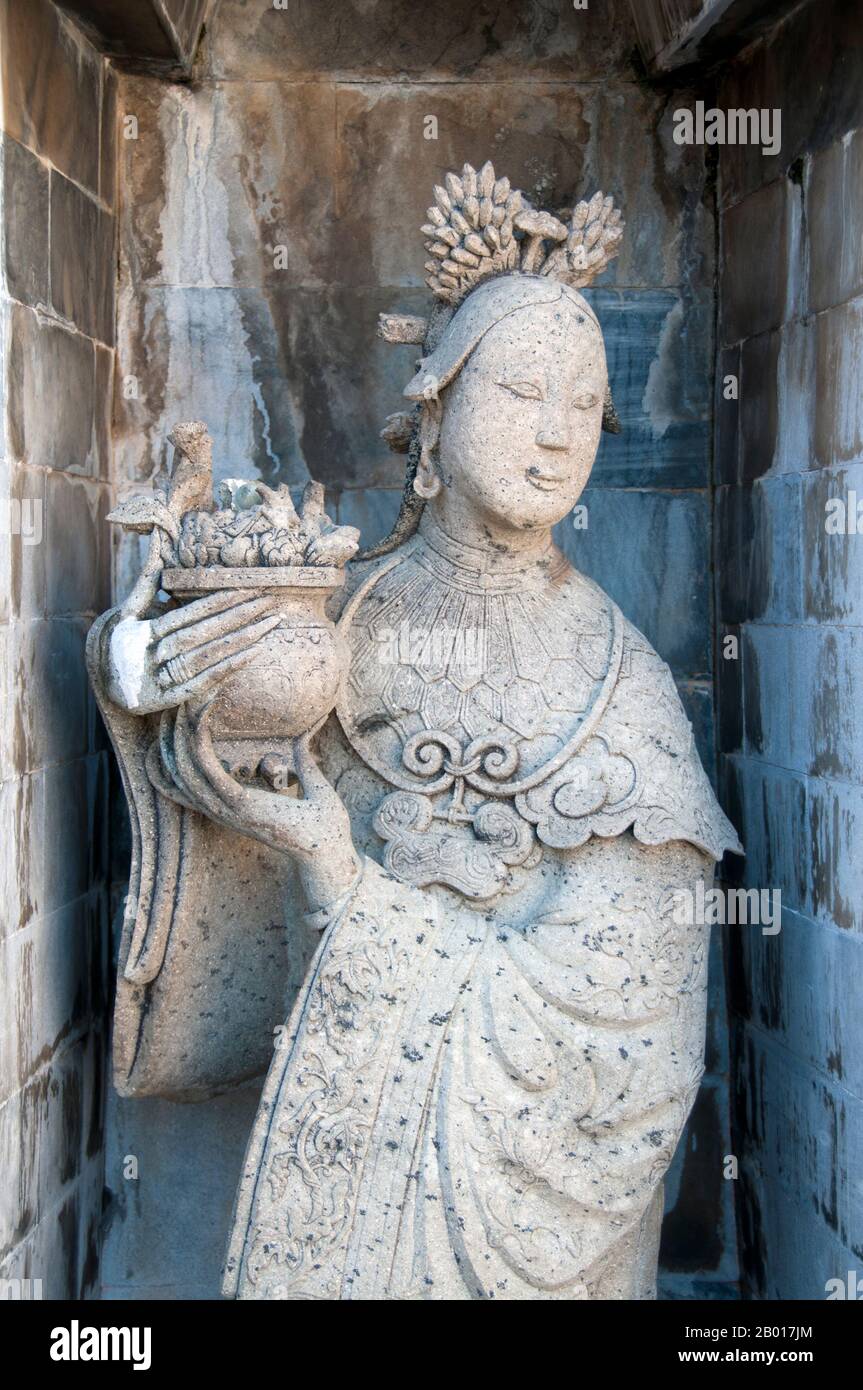 Thailand: Chinese figure in the main temple complex, Wat Arun (Temple of Dawn), Bangkok. Wat Arun Rajwararam (Temple of the Dawn), full name Wat Arunratchawararam Ratchaworamahawihan, is a Thai Buddhist temple on the Thonburi west bank side of the Chao Phraya River in Bangkok. It is named after Aruna, the Indian God of Dawn. A monastery has stood here since the Ayutthayan period (1351 - 1767), but the temple's outstanding feature, the Khmer-style central prang, was not begun until 1809, during the reign of King Buddha Loetla Nabhalai (Rama II). Stock Photohttps://www.alamy.com/image-license-details/?v=1https://www.alamy.com/thailand-chinese-figure-in-the-main-temple-complex-wat-arun-temple-of-dawn-bangkok-wat-arun-rajwararam-temple-of-the-dawn-full-name-wat-arunratchawararam-ratchaworamahawihan-is-a-thai-buddhist-temple-on-the-thonburi-west-bank-side-of-the-chao-phraya-river-in-bangkok-it-is-named-after-aruna-the-indian-god-of-dawn-a-monastery-has-stood-here-since-the-ayutthayan-period-1351-1767-but-the-temples-outstanding-feature-the-khmer-style-central-prang-was-not-begun-until-1809-during-the-reign-of-king-buddha-loetla-nabhalai-rama-ii-image344235324.html
Thailand: Chinese figure in the main temple complex, Wat Arun (Temple of Dawn), Bangkok. Wat Arun Rajwararam (Temple of the Dawn), full name Wat Arunratchawararam Ratchaworamahawihan, is a Thai Buddhist temple on the Thonburi west bank side of the Chao Phraya River in Bangkok. It is named after Aruna, the Indian God of Dawn. A monastery has stood here since the Ayutthayan period (1351 - 1767), but the temple's outstanding feature, the Khmer-style central prang, was not begun until 1809, during the reign of King Buddha Loetla Nabhalai (Rama II). Stock Photohttps://www.alamy.com/image-license-details/?v=1https://www.alamy.com/thailand-chinese-figure-in-the-main-temple-complex-wat-arun-temple-of-dawn-bangkok-wat-arun-rajwararam-temple-of-the-dawn-full-name-wat-arunratchawararam-ratchaworamahawihan-is-a-thai-buddhist-temple-on-the-thonburi-west-bank-side-of-the-chao-phraya-river-in-bangkok-it-is-named-after-aruna-the-indian-god-of-dawn-a-monastery-has-stood-here-since-the-ayutthayan-period-1351-1767-but-the-temples-outstanding-feature-the-khmer-style-central-prang-was-not-begun-until-1809-during-the-reign-of-king-buddha-loetla-nabhalai-rama-ii-image344235324.htmlRM2B017JM–Thailand: Chinese figure in the main temple complex, Wat Arun (Temple of Dawn), Bangkok. Wat Arun Rajwararam (Temple of the Dawn), full name Wat Arunratchawararam Ratchaworamahawihan, is a Thai Buddhist temple on the Thonburi west bank side of the Chao Phraya River in Bangkok. It is named after Aruna, the Indian God of Dawn. A monastery has stood here since the Ayutthayan period (1351 - 1767), but the temple's outstanding feature, the Khmer-style central prang, was not begun until 1809, during the reign of King Buddha Loetla Nabhalai (Rama II).
 Thailand: Chinese warrior figure next to the Khmer-style central prang at Wat Arun (Temple of Dawn), Bangkok. Wat Arun Rajwararam (Temple of the Dawn), full name Wat Arunratchawararam Ratchaworamahawihan, is a Thai Buddhist temple on the Thonburi west bank side of the Chao Phraya River in Bangkok. It is named after Aruna, the Indian God of Dawn. A monastery has stood here since the Ayutthayan period (1351 - 1767), but the temple's outstanding feature, the Khmer-style central prang, was not begun until 1809, during the reign of King Buddha Loetla Nabhalai (Rama II). Stock Photohttps://www.alamy.com/image-license-details/?v=1https://www.alamy.com/thailand-chinese-warrior-figure-next-to-the-khmer-style-central-prang-at-wat-arun-temple-of-dawn-bangkok-wat-arun-rajwararam-temple-of-the-dawn-full-name-wat-arunratchawararam-ratchaworamahawihan-is-a-thai-buddhist-temple-on-the-thonburi-west-bank-side-of-the-chao-phraya-river-in-bangkok-it-is-named-after-aruna-the-indian-god-of-dawn-a-monastery-has-stood-here-since-the-ayutthayan-period-1351-1767-but-the-temples-outstanding-feature-the-khmer-style-central-prang-was-not-begun-until-1809-during-the-reign-of-king-buddha-loetla-nabhalai-rama-ii-image344235348.html
Thailand: Chinese warrior figure next to the Khmer-style central prang at Wat Arun (Temple of Dawn), Bangkok. Wat Arun Rajwararam (Temple of the Dawn), full name Wat Arunratchawararam Ratchaworamahawihan, is a Thai Buddhist temple on the Thonburi west bank side of the Chao Phraya River in Bangkok. It is named after Aruna, the Indian God of Dawn. A monastery has stood here since the Ayutthayan period (1351 - 1767), but the temple's outstanding feature, the Khmer-style central prang, was not begun until 1809, during the reign of King Buddha Loetla Nabhalai (Rama II). Stock Photohttps://www.alamy.com/image-license-details/?v=1https://www.alamy.com/thailand-chinese-warrior-figure-next-to-the-khmer-style-central-prang-at-wat-arun-temple-of-dawn-bangkok-wat-arun-rajwararam-temple-of-the-dawn-full-name-wat-arunratchawararam-ratchaworamahawihan-is-a-thai-buddhist-temple-on-the-thonburi-west-bank-side-of-the-chao-phraya-river-in-bangkok-it-is-named-after-aruna-the-indian-god-of-dawn-a-monastery-has-stood-here-since-the-ayutthayan-period-1351-1767-but-the-temples-outstanding-feature-the-khmer-style-central-prang-was-not-begun-until-1809-during-the-reign-of-king-buddha-loetla-nabhalai-rama-ii-image344235348.htmlRM2B017KG–Thailand: Chinese warrior figure next to the Khmer-style central prang at Wat Arun (Temple of Dawn), Bangkok. Wat Arun Rajwararam (Temple of the Dawn), full name Wat Arunratchawararam Ratchaworamahawihan, is a Thai Buddhist temple on the Thonburi west bank side of the Chao Phraya River in Bangkok. It is named after Aruna, the Indian God of Dawn. A monastery has stood here since the Ayutthayan period (1351 - 1767), but the temple's outstanding feature, the Khmer-style central prang, was not begun until 1809, during the reign of King Buddha Loetla Nabhalai (Rama II).
 Thailand: Chinese figure in the main temple complex, Wat Arun (Temple of Dawn), Bangkok. Wat Arun Rajwararam (Temple of the Dawn), full name Wat Arunratchawararam Ratchaworamahawihan, is a Thai Buddhist temple on the Thonburi west bank side of the Chao Phraya River in Bangkok. It is named after Aruna, the Indian God of Dawn. A monastery has stood here since the Ayutthayan period (1351 - 1767), but the temple's outstanding feature, the Khmer-style central prang, was not begun until 1809, during the reign of King Buddha Loetla Nabhalai (Rama II). Stock Photohttps://www.alamy.com/image-license-details/?v=1https://www.alamy.com/thailand-chinese-figure-in-the-main-temple-complex-wat-arun-temple-of-dawn-bangkok-wat-arun-rajwararam-temple-of-the-dawn-full-name-wat-arunratchawararam-ratchaworamahawihan-is-a-thai-buddhist-temple-on-the-thonburi-west-bank-side-of-the-chao-phraya-river-in-bangkok-it-is-named-after-aruna-the-indian-god-of-dawn-a-monastery-has-stood-here-since-the-ayutthayan-period-1351-1767-but-the-temples-outstanding-feature-the-khmer-style-central-prang-was-not-begun-until-1809-during-the-reign-of-king-buddha-loetla-nabhalai-rama-ii-image344235330.html
Thailand: Chinese figure in the main temple complex, Wat Arun (Temple of Dawn), Bangkok. Wat Arun Rajwararam (Temple of the Dawn), full name Wat Arunratchawararam Ratchaworamahawihan, is a Thai Buddhist temple on the Thonburi west bank side of the Chao Phraya River in Bangkok. It is named after Aruna, the Indian God of Dawn. A monastery has stood here since the Ayutthayan period (1351 - 1767), but the temple's outstanding feature, the Khmer-style central prang, was not begun until 1809, during the reign of King Buddha Loetla Nabhalai (Rama II). Stock Photohttps://www.alamy.com/image-license-details/?v=1https://www.alamy.com/thailand-chinese-figure-in-the-main-temple-complex-wat-arun-temple-of-dawn-bangkok-wat-arun-rajwararam-temple-of-the-dawn-full-name-wat-arunratchawararam-ratchaworamahawihan-is-a-thai-buddhist-temple-on-the-thonburi-west-bank-side-of-the-chao-phraya-river-in-bangkok-it-is-named-after-aruna-the-indian-god-of-dawn-a-monastery-has-stood-here-since-the-ayutthayan-period-1351-1767-but-the-temples-outstanding-feature-the-khmer-style-central-prang-was-not-begun-until-1809-during-the-reign-of-king-buddha-loetla-nabhalai-rama-ii-image344235330.htmlRM2B017JX–Thailand: Chinese figure in the main temple complex, Wat Arun (Temple of Dawn), Bangkok. Wat Arun Rajwararam (Temple of the Dawn), full name Wat Arunratchawararam Ratchaworamahawihan, is a Thai Buddhist temple on the Thonburi west bank side of the Chao Phraya River in Bangkok. It is named after Aruna, the Indian God of Dawn. A monastery has stood here since the Ayutthayan period (1351 - 1767), but the temple's outstanding feature, the Khmer-style central prang, was not begun until 1809, during the reign of King Buddha Loetla Nabhalai (Rama II).
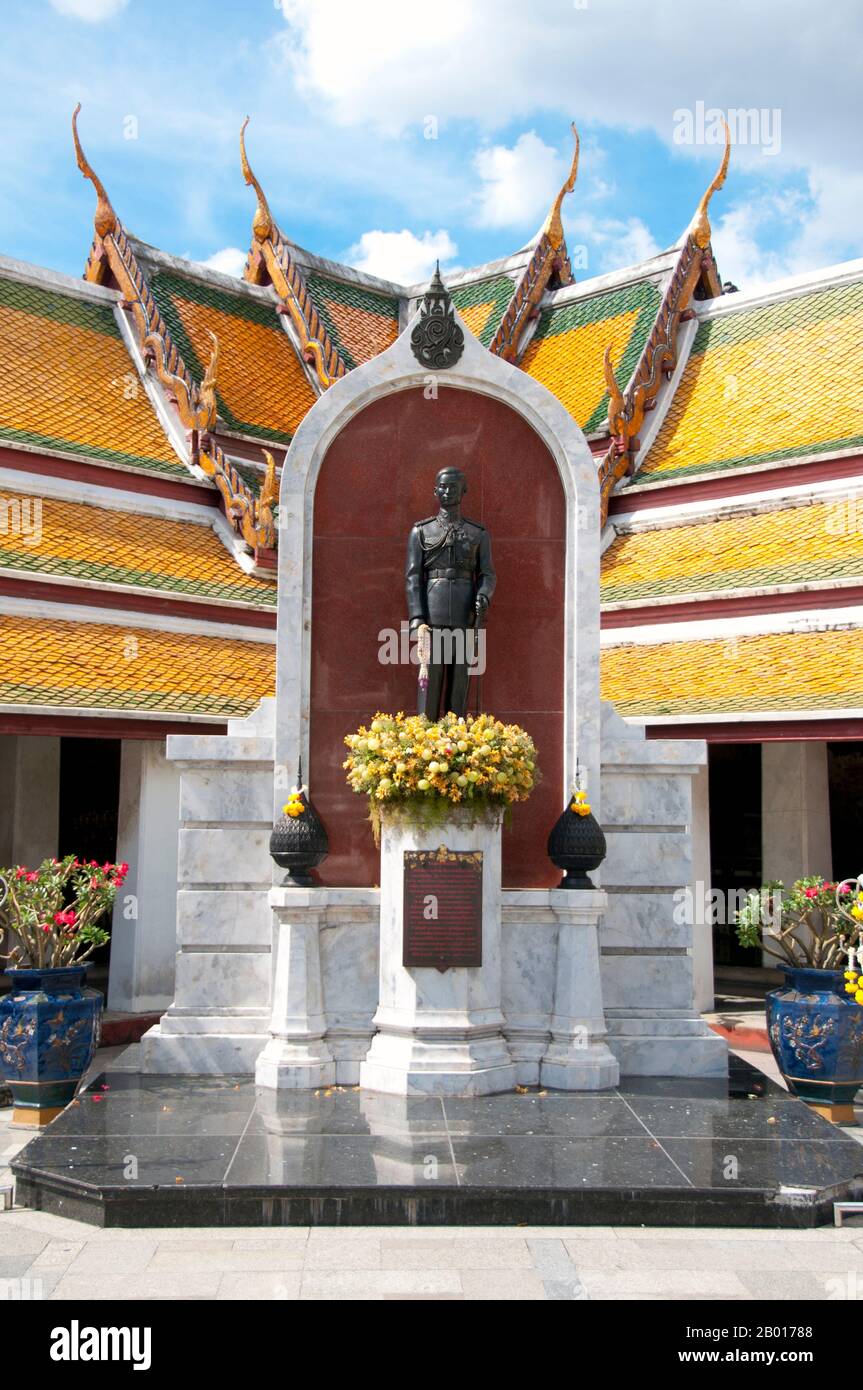 Thailand: Statue of King Ananda Mahidol (Rama VIII), Wat Suthat, Bangkok. Phra Bat Somdet Phra Poramentharamaha Ananda Mahidol Phra Atthama Ramathibodindara, or Rama VIII, (20 September 1925–9 June 1946) was the eighth monarch of Thailand under the House of Chakri. Wat Suthat Thepphawararam is a royal temple of the first grade, one of six such temples in Thailand. Construction was begun by King Buddha Yodfa Chulaloke (Rama I) in 1807. Further construction and decorations were carried out by King Buddha Loetla Nabhalai (Rama II) who helped carve the wooden doors. Stock Photohttps://www.alamy.com/image-license-details/?v=1https://www.alamy.com/thailand-statue-of-king-ananda-mahidol-rama-viii-wat-suthat-bangkok-phra-bat-somdet-phra-poramentharamaha-ananda-mahidol-phra-atthama-ramathibodindara-or-rama-viii-20-september-19259-june-1946-was-the-eighth-monarch-of-thailand-under-the-house-of-chakri-wat-suthat-thepphawararam-is-a-royal-temple-of-the-first-grade-one-of-six-such-temples-in-thailand-construction-was-begun-by-king-buddha-yodfa-chulaloke-rama-i-in-1807-further-construction-and-decorations-were-carried-out-by-king-buddha-loetla-nabhalai-rama-ii-who-helped-carve-the-wooden-doors-image344235032.html
Thailand: Statue of King Ananda Mahidol (Rama VIII), Wat Suthat, Bangkok. Phra Bat Somdet Phra Poramentharamaha Ananda Mahidol Phra Atthama Ramathibodindara, or Rama VIII, (20 September 1925–9 June 1946) was the eighth monarch of Thailand under the House of Chakri. Wat Suthat Thepphawararam is a royal temple of the first grade, one of six such temples in Thailand. Construction was begun by King Buddha Yodfa Chulaloke (Rama I) in 1807. Further construction and decorations were carried out by King Buddha Loetla Nabhalai (Rama II) who helped carve the wooden doors. Stock Photohttps://www.alamy.com/image-license-details/?v=1https://www.alamy.com/thailand-statue-of-king-ananda-mahidol-rama-viii-wat-suthat-bangkok-phra-bat-somdet-phra-poramentharamaha-ananda-mahidol-phra-atthama-ramathibodindara-or-rama-viii-20-september-19259-june-1946-was-the-eighth-monarch-of-thailand-under-the-house-of-chakri-wat-suthat-thepphawararam-is-a-royal-temple-of-the-first-grade-one-of-six-such-temples-in-thailand-construction-was-begun-by-king-buddha-yodfa-chulaloke-rama-i-in-1807-further-construction-and-decorations-were-carried-out-by-king-buddha-loetla-nabhalai-rama-ii-who-helped-carve-the-wooden-doors-image344235032.htmlRM2B01788–Thailand: Statue of King Ananda Mahidol (Rama VIII), Wat Suthat, Bangkok. Phra Bat Somdet Phra Poramentharamaha Ananda Mahidol Phra Atthama Ramathibodindara, or Rama VIII, (20 September 1925–9 June 1946) was the eighth monarch of Thailand under the House of Chakri. Wat Suthat Thepphawararam is a royal temple of the first grade, one of six such temples in Thailand. Construction was begun by King Buddha Yodfa Chulaloke (Rama I) in 1807. Further construction and decorations were carried out by King Buddha Loetla Nabhalai (Rama II) who helped carve the wooden doors.
 Thailand: King Rama III, Jessadabodindra (31 March 1787 – 2 April 1851), 3rd monarch of the Chakri Dynasty. Oil on canvas painting, c. 19th century. Phra Bat Somdet Phra Poramintharamaha Jessadabodindra Phra Nangklao Chao Yu Hua (Chetsadabodin Phra Nang Klao Chao Yu Hua), or Rama III, was the third monarch of Siam under the House of Chakri, ruling from 21 July 1824 to 2 April 1851. He succeeded his father, Buddha Loetla Nabhalai, as the King of Siam. His succession was unusual according to the traditions because Jessadabodindra was a son of a concubine rather than a queen. Stock Photohttps://www.alamy.com/image-license-details/?v=1https://www.alamy.com/thailand-king-rama-iii-jessadabodindra-31-march-1787-2-april-1851-3rd-monarch-of-the-chakri-dynasty-oil-on-canvas-painting-c-19th-century-phra-bat-somdet-phra-poramintharamaha-jessadabodindra-phra-nangklao-chao-yu-hua-chetsadabodin-phra-nang-klao-chao-yu-hua-or-rama-iii-was-the-third-monarch-of-siam-under-the-house-of-chakri-ruling-from-21-july-1824-to-2-april-1851-he-succeeded-his-father-buddha-loetla-nabhalai-as-the-king-of-siam-his-succession-was-unusual-according-to-the-traditions-because-jessadabodindra-was-a-son-of-a-concubine-rather-than-a-queen-image344232258.html
Thailand: King Rama III, Jessadabodindra (31 March 1787 – 2 April 1851), 3rd monarch of the Chakri Dynasty. Oil on canvas painting, c. 19th century. Phra Bat Somdet Phra Poramintharamaha Jessadabodindra Phra Nangklao Chao Yu Hua (Chetsadabodin Phra Nang Klao Chao Yu Hua), or Rama III, was the third monarch of Siam under the House of Chakri, ruling from 21 July 1824 to 2 April 1851. He succeeded his father, Buddha Loetla Nabhalai, as the King of Siam. His succession was unusual according to the traditions because Jessadabodindra was a son of a concubine rather than a queen. Stock Photohttps://www.alamy.com/image-license-details/?v=1https://www.alamy.com/thailand-king-rama-iii-jessadabodindra-31-march-1787-2-april-1851-3rd-monarch-of-the-chakri-dynasty-oil-on-canvas-painting-c-19th-century-phra-bat-somdet-phra-poramintharamaha-jessadabodindra-phra-nangklao-chao-yu-hua-chetsadabodin-phra-nang-klao-chao-yu-hua-or-rama-iii-was-the-third-monarch-of-siam-under-the-house-of-chakri-ruling-from-21-july-1824-to-2-april-1851-he-succeeded-his-father-buddha-loetla-nabhalai-as-the-king-of-siam-his-succession-was-unusual-according-to-the-traditions-because-jessadabodindra-was-a-son-of-a-concubine-rather-than-a-queen-image344232258.htmlRM2B013N6–Thailand: King Rama III, Jessadabodindra (31 March 1787 – 2 April 1851), 3rd monarch of the Chakri Dynasty. Oil on canvas painting, c. 19th century. Phra Bat Somdet Phra Poramintharamaha Jessadabodindra Phra Nangklao Chao Yu Hua (Chetsadabodin Phra Nang Klao Chao Yu Hua), or Rama III, was the third monarch of Siam under the House of Chakri, ruling from 21 July 1824 to 2 April 1851. He succeeded his father, Buddha Loetla Nabhalai, as the King of Siam. His succession was unusual according to the traditions because Jessadabodindra was a son of a concubine rather than a queen.
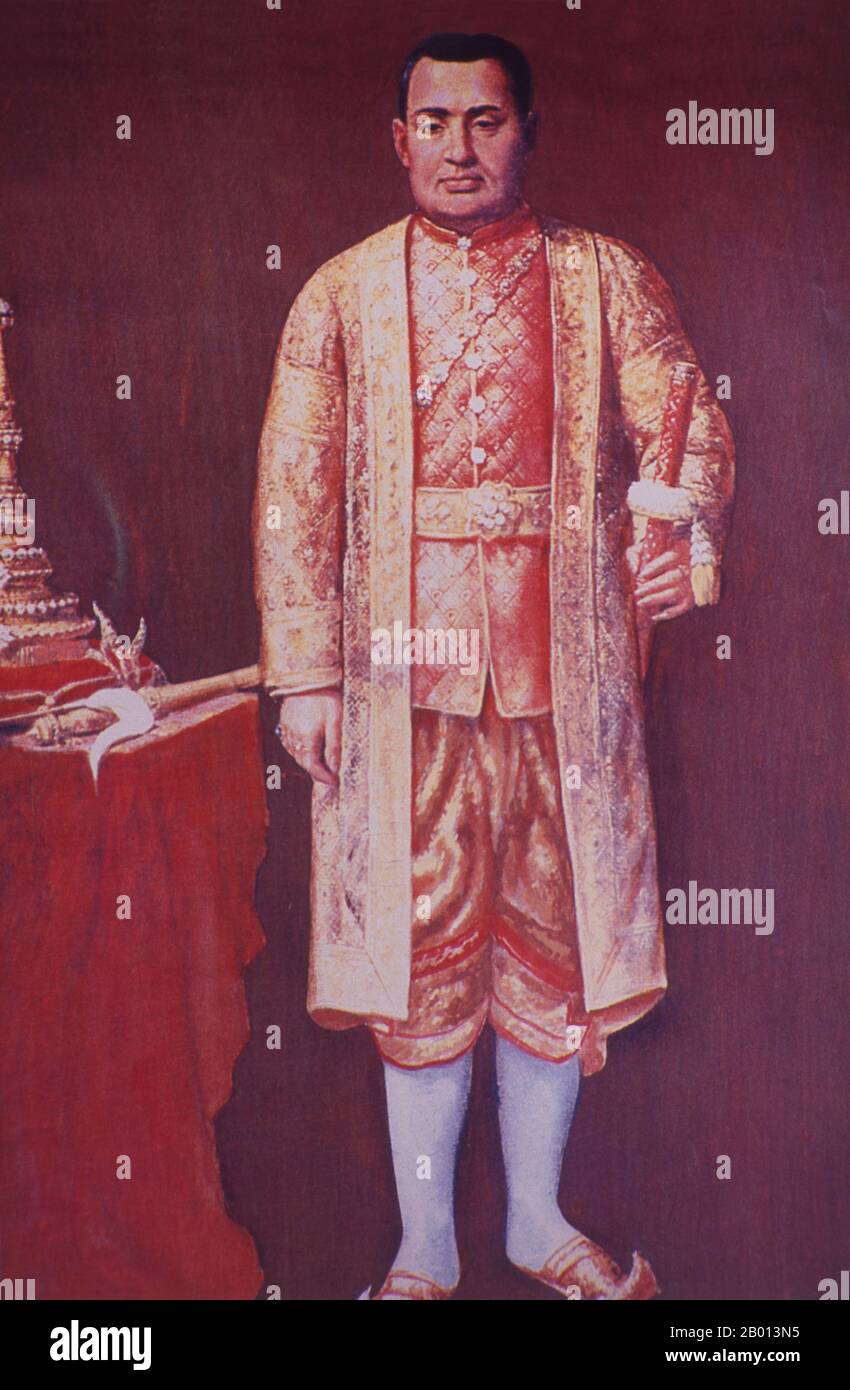 Thailand: King Rama III, Jessadabodindra (31 March 1787 – 2 April 1851), 3rd monarch of the Chakri Dynasty. Oil on canvas painting, c. 19th century. Phra Bat Somdet Phra Poramintharamaha Jessadabodindra Phra Nangklao Chao Yu Hua (Chetsadabodin Phra Nang Klao Chao Yu Hua), or Rama III, was the third monarch of Siam under the House of Chakri, ruling from 21 July 1824 to 2 April 1851. He succeeded his father, Buddha Loetla Nabhalai, as the King of Siam. His succession was unusual according to the traditions because Jessadabodindra was a son of a concubine rather than a queen. Stock Photohttps://www.alamy.com/image-license-details/?v=1https://www.alamy.com/thailand-king-rama-iii-jessadabodindra-31-march-1787-2-april-1851-3rd-monarch-of-the-chakri-dynasty-oil-on-canvas-painting-c-19th-century-phra-bat-somdet-phra-poramintharamaha-jessadabodindra-phra-nangklao-chao-yu-hua-chetsadabodin-phra-nang-klao-chao-yu-hua-or-rama-iii-was-the-third-monarch-of-siam-under-the-house-of-chakri-ruling-from-21-july-1824-to-2-april-1851-he-succeeded-his-father-buddha-loetla-nabhalai-as-the-king-of-siam-his-succession-was-unusual-according-to-the-traditions-because-jessadabodindra-was-a-son-of-a-concubine-rather-than-a-queen-image344232257.html
Thailand: King Rama III, Jessadabodindra (31 March 1787 – 2 April 1851), 3rd monarch of the Chakri Dynasty. Oil on canvas painting, c. 19th century. Phra Bat Somdet Phra Poramintharamaha Jessadabodindra Phra Nangklao Chao Yu Hua (Chetsadabodin Phra Nang Klao Chao Yu Hua), or Rama III, was the third monarch of Siam under the House of Chakri, ruling from 21 July 1824 to 2 April 1851. He succeeded his father, Buddha Loetla Nabhalai, as the King of Siam. His succession was unusual according to the traditions because Jessadabodindra was a son of a concubine rather than a queen. Stock Photohttps://www.alamy.com/image-license-details/?v=1https://www.alamy.com/thailand-king-rama-iii-jessadabodindra-31-march-1787-2-april-1851-3rd-monarch-of-the-chakri-dynasty-oil-on-canvas-painting-c-19th-century-phra-bat-somdet-phra-poramintharamaha-jessadabodindra-phra-nangklao-chao-yu-hua-chetsadabodin-phra-nang-klao-chao-yu-hua-or-rama-iii-was-the-third-monarch-of-siam-under-the-house-of-chakri-ruling-from-21-july-1824-to-2-april-1851-he-succeeded-his-father-buddha-loetla-nabhalai-as-the-king-of-siam-his-succession-was-unusual-according-to-the-traditions-because-jessadabodindra-was-a-son-of-a-concubine-rather-than-a-queen-image344232257.htmlRM2B013N5–Thailand: King Rama III, Jessadabodindra (31 March 1787 – 2 April 1851), 3rd monarch of the Chakri Dynasty. Oil on canvas painting, c. 19th century. Phra Bat Somdet Phra Poramintharamaha Jessadabodindra Phra Nangklao Chao Yu Hua (Chetsadabodin Phra Nang Klao Chao Yu Hua), or Rama III, was the third monarch of Siam under the House of Chakri, ruling from 21 July 1824 to 2 April 1851. He succeeded his father, Buddha Loetla Nabhalai, as the King of Siam. His succession was unusual according to the traditions because Jessadabodindra was a son of a concubine rather than a queen.